|
Meinem Lehrer und Freund Prof. Dr. Heinrich von Stietencron in Dankbarkeit gewidmet. |
Zitierweise | cite as: Amarasiṃha <6./8. Jhdt. n. Chr.>: Nāmaliṅgānuśāsana (Amarakośa) / übersetzt von Alois Payer <1944 - >. -- 1. Prathamam kāṇḍam. -- 1. svargavargaḥ. -- Fassung vom 2017-05-15. -- URL: http://www.payer.de/amarakosa/amara101.htm
Erstmals hier publiziert: 2010-07-09
Überarbeitungen: 2017-05-15 [Ergänzungen] ; 2017-05-08 [Ergänzungen] ; 2010-11-05 [Ergänzungen] ; 2010-08-24 [Verbesserungen]
©opyright: Creative Commons Lizenz (Namensnennung, keine kommerzielle Nutzung, share alike)
Dieser Text ist Teil der Abteilung Sanskrit von Tüpfli's Global Village Library
|
Meinem Lehrer und Freund Prof. Dr. Heinrich von Stietencron in Dankbarkeit gewidmet. |
Falls Sie die diakritischen Zeichen nicht dargestellt bekommen, installieren Sie eine Schrift mit Diakritika wie z.B. Tahoma.
Die Devanāgarī-Zeichen sind in Unicode kodiert. Sie benötigen also eine Unicode-Devanāgarī-Schrift.
Jātarūpa
Jātarūpa <vor 1119 n. Chr.>: Jātarūpa's Commentary on the Amarakoṣa : for the first time critically edited together with an introduction, appendices and indices / Mahes Raj Pant. - 2 Bde. -- Delhi [u.a.] : Motilal Banarsidass, 2000. -- Teilw. zugl.: Hamburg, Univ., Diss. von Mahes Raj Pant. -- ISBN 81-208-1690-0
6. svar avyayaṃ svarga-nāka-tridiva-tridaśālayāḥ
suraloko dyo-divau dve striyāṃ klībe triviṣṭapam.
स्वरव्ययं स्वर्ग-नाक-त्रिदिव-त्रिदशालयाः ।
सुरलोको द्यो-दिवौ द्वे स्त्रियां क्लिबे त्रिविष्टपम् ॥६॥
[Bezeichnungen für Himmel sind:]
Erläuterungen:
1 Svar - स्वर् Indekl.: Himmel
"Svar. "Vyāhṛtis. Three mystical words said by Manu to have been milked from the Vedas by Prajāpati - the word bhūr,
from the Ṛg-veda ; the word bhuvaḥ, from the Yajur-veda; and the word svar, from the Sāma-veda (Manu, ii. 76). The Śatapatha Brāhmaṇa defines them as "three luminous essences", which Prajāpati produced from the Vedas by heating them. "He uttered the word bhur, which became this earth ; bhuvaḥ, which became this firmament; and svar, which became that sky." A fourth word, mahar, is sometimes added, and is probably intended to represent the Atharva-veda. See Loka."
[Quelle: Dowson, John <1820-1881>: A classical dictionary of Hindu mythology and religion, geography, history, and literature. -- London, Trübner, 1879. -- s.v. ]
2 Svarga - स्वर्ग m.: Himmel
"Svarga. The heaven of Indra, the abode of the inferior gods and of beatified mortals, supposed to be situated on Mount Meru. It is called also Sairibha, Miśraka-vana, Tāviṣa, Tridivam, Tri-piṣṭapam, and Ūrdhva-loka, Names of heaven or paradise in general are also used for it."
[Quelle: Dowson, John <1820-1881>: A classical dictionary of Hindu mythology and religion, geography, history, and literature. -- London, Trübner, 1879. -- s.v. ]
3 Tridaśālaya - त्रिदशालय m.: Wohnort der 30 [eigentlich: 33] Götter
"Tridaśa. 'Three times ten', thirty. In round numbers, the thirty-three deities
twelve Ādityas,
eight Vasus,
eleven Rudras, and
two Aśvins."
[Quelle: Dowson, John <1820-1881>: A classical dictionary of Hindu mythology and religion, geography, history, and literature. -- London, Trübner, 1879. -- s.v. ]
4 Suraloka - सुरलोक m.: Götterwelt
"Suras. In the Vedas, a class of beings connected with Sūrya, the sun. The inferior deities who inhabit Svarga ; a god in general. According to some, the word is allied to svar, heaven; others think it to have sprung from the derivation assigned to asura, and as a-sura is said to signify not agod, sura has come to mean god." [Quelle: Dowson, John <1820-1881>: A classical dictionary of Hindu mythology and religion, geography, history, and literature. -- London, Trübner, 1879. -- s.v. ]
5 Dyo, Div - द्यो f., दिव् f.: Himmel5
"Dyaus. The sky, heaven. In the Vedas he is a masculine deity, and is called occasionally Dyaus-pitṛ, heavenly father, the earth being regarded as the mother. He is father of Uṣas, the dawn. Cf. Ζεύς, Deus, Jovis, Ju-piter. Dyāvā-pṛthivī, 'heaven and earth', are represented as the universal parents, not only of men but of gods; but in other places they are spoken of as having been themselves created; and then, again, there are speculations as to their origin and priority. In one hymn it is asked, "Which of these two was the first and which the last? How have they been produced? Who knows ?" The Śatapatha Brāhmaṇa declares in favour of the earth, saying, "This earth is the first of created beings.""
[Quelle: Dowson, John <1820-1881>: A classical dictionary of Hindu mythology and religion, geography, history, and literature. -- London, Trübner, 1879. -- s.v. ]
6 Triviṣṭapa - त्रिविष्टप n.: Indras Himmel
Jātarūpa: "Der Himmel der Drei. Weil die drei, Hari (Viṣṇu), Hara (Śiva) und Brahmā, die Wichtigsten sind, wird die Bezeichnung nur mit diesen gebildet." (त्रयाणां विष्टपं त्रिविष्टपम् । प्राधान्याच्च हरिहरब्रह्मणां तैरेव व्यपदेशो भवति)
7. amarā nirjarā devās tridaśā vibudhāḥ surāḥ
suparvāṇaḥ sumanasas tridiveśā divaukasaḥ
8. āditeyā diviṣado lekhā aditinandanāḥ
ādityā ṛbhavo 'svapnā amartyā amṛtāndhasaḥ
9. barhirmukhāḥ kratubhujo gīrvāṇā dānavārayaḥ
vṛndārakā daivatāni puṃsi vā devatāḥ striyām
अमरा निर्जरा देवास् त्रिदशा विबुधाः सुराः
सुपर्वाणः सुमनसस्-त्रिदिवेशा दिवौकसः ॥७॥
आदितेया दिविषदो लेखा अदितिनिन्दनाः
आदित्या ऋभवो
ऽस्वप्ना अमर्त्या अमृतान्धसः
॥८॥
बर्हिर्मुखा क्रतुभुजो गीर्वाणा दाबवारयः
वृन्दारका दैवतानि पुंसि वा देवाताः स्त्रियाम् ॥९॥
[Bezeichnungen für Gottheiten1 sind:]
Erläuterungen:
1 Devatā - देवता f.: Gottheit
"Devatā. 'A divine being or god'. The name Devatās includes the gods in general, or, as most frequently used, the whole body of inferior gods."
[Quelle: Dowson, John <1820-1881>: A classical dictionary of Hindu mythology and religion, geography, history, and literature. -- London, Trübner, 1879. -- s.v. ]
2 Deva - देव m.: Gott
"Deva. (Nom. Devas = Deus, from the root Div, to shine.) 'God. A deity'. The gods are spoken of as thirty-three in number, eleven for each of the three worlds." [Quelle: Dowson, John <1820-1881>: A classical dictionary of Hindu mythology and religion, geography, history, and literature. -- London, Trübner, 1879. -- s.v. ]
3 Tridaśa - त्रिदश m. Pl.: die dreißig (genau 33) Götter
"Tridaśa. 'Three times ten', thirty. In round numbers, the thirty-three deities
twelve Ādityas,
eight Vasus,
eleven Rudras, and
two Aśvins."
[Quelle: Dowson, John <1820-1881>: A classical dictionary of Hindu mythology and religion, geography, history, and literature. -- London, Trübner, 1879. -- s.v. ]
4 Sura - सुर m.: Gott
"Suras. In the Vedas, a class of beings connected with Sūrya, the sun. The inferior deities who inhabit Svarga ; a god in general. According to some, the word is allied to svar, heaven; others think it to have sprung from the derivation assigned to asura, and as a-sura is said to signify not agod, sura has come to mean god." [Quelle: Dowson, John <1820-1881>: A classical dictionary of Hindu mythology and religion, geography, history, and literature. -- London, Trübner, 1879. -- s.v. ]
5 Āditya, Āditeya - आदित्य m., आदितेय m.: Sohn der Göttermutter Aditi
(s. auch unten)
"Aditi. 'Free, unbounded. Infinity'; the boundless heaven as compared with the finite earth ; or, according to M. Müller, "the visible infinite, visible by the naked eye; the endless expanse beyond the earth, beyond the clouds, beyond the sky." In the Ṛg-veda she is frequently implored "for blessings on children and cattle, for protection and for forgiveness." Aditi is called Deva-mātṛ, mother of the gods, and is represented as being the mother of Dakṣa and the daughter of Dakṣa. On this statement Yaska remarks in the Nirukta : "How can this be possible ? They may have had the same origin ; or, according to the nature of the gods, they may have been born from each other, have derived their substance from one another." "Eight sons were born from the body of Aditi ; she approached the gods with seven but cast away the eighth, Mārtāṇḍa (the sun)." These seven were the Ādityas. In the Yajur-veda Aditi is addressed as "Supporter of the sky, sustainer of the earth, sovereign of this world, wife of Viṣṇu ;" but in the Mahābhārata and Rāmāyaṇa, as well as in the Purāṇas, Viṣṇu is called the son of Aditi. In the Viṣṇu Purāṇa she is said to be the daughter of Dakṣa and wife of Kaśyapa, by whom she was mother of Viṣṇu, in his dwarf incarnation (wherefore he is sometimes called Āditya), and also of Indra, and she is called "the mother of the gods"; and "the mother of the world." Indra acknowledged her as mother, and Viṣṇu, after receiving the adoration of Aditi, addressed her in these words : "Mother, goddess, do thou show favour unto me and grant me thy bless ing." According to the Matsya Purāṇa a pair of ear-rings was produced at the churning of the ocean, which Indra gave to Aditi, and several of the Purāṇas tell a story of these ear-rings being stolen and carried off to the city of Prāg-jyotiṣa by the Asura king Naraka, from whence they were brought back and restored to her by Kṛṣṇa. Devakī, the mother of Kṛṣṇa, is represented as being a new birth or manifestation of Aditi. See Max Müller's Ṛg Veda, i. 230; Muir's Texts, iv. n, v. 35." [Quelle: Dowson, John <1820-1881>: A classical dictionary of Hindu mythology and religion, geography, history, and literature. -- London, Trübner, 1879. -- s.v. ]
6 Ṛbhu - ऋभु m.: (bildender) Künstler
"Ṛbhu. 'Clever, skilful'. An epithet used for Indra, Agni, and the Ādityas. In the Purāṇic mythology, Ṛbhu is a "son of the supreme Brahma, who, from his innate disposition, was of a holy character and acquainted with true wisdom." His pupil was Nidāgha, a son of Pulastya, and he took especial interest in his instruction, returning to him after two intervals of a thousand years, "to instruct him further in true wisdom." The Viṣṇu Purāṇa, "originally composed by the Ṛṣi (Nārāyaṇa), was communicated by Brahmā to Ṛbhu." He was one of the four Kumāras (q.v.)." [Quelle: Dowson, John <1820-1881>: A classical dictionary of Hindu mythology and religion, geography, history, and literature. -- London, Trübner, 1879. -- s.v. ]
7 Amṛtādhas - अमृतान्धस् m.: der Als Saft Soma (Unsterblichkeitstrank) besitzt
"Amṛta. 'Immortal.' A god. The water of life. The term was known to the Vedas, and seems to have been applied to various things offered in sacrifice, but more especially to the Soma juice. It is also called Nir-jara and Pīyūṣa. In later times it was the water of life produced at the churning of the ocean by the gods and demons, the legend of which is told with some variations in the Rāmāyaṇa, the Mahā-bhārata, and the Purāṇas. The gods, feeling their weakness, having been worsted by the demons, and being, according to one authority, under the ban of a holy sage, repaired to Viṣṇu, beseeching him for renewed vigour and the gift of immortality. He directed them to churn the ocean for the Amṛta and other precious things which had been lost." [Quelle: Dowson, John <1820-1881>: A classical dictionary of Hindu mythology and religion, geography, history, and literature. -- London, Trübner, 1879. -- s.v. ]
8 Barhirmukha - बर्हिर्मुख m.: dessen Antlitz auf das Opferstreu (den Opferplatz) gerichtet ist; bzw. dessen Mund das Feuer ist
Jātarūpa: "die, deren Mund Barhis, 'Feuer', ist." (बर्हिरग्निर्मुखमेषामिति बर्गिर्मिखाः)
9 Dānavāri - दानवारि m. Pl.: Feind der Dānava
"Dānavas. Descendants from Danu by the sage Kaśyapa. They were giants who warred against the gods. See Daityas." [Quelle: Dowson, John <1820-1881>: A classical dictionary of Hindu mythology and religion, geography, history, and literature. -- London, Trübner, 1879. -- s.v. ]
10. āditya-viśva-vasavas-tuṣitābhāsvarānilāḥ
mahārājika-sādhyāś ca rudrāś ca gaṇadevatāḥ
आदित्य-विश्व-वसवस् तुषिताभास्वरानिलाः
महाराजिक-साध्याश् च रुद्राश् च गणदेवताः ॥१०॥
Gruppengottheiten1 sind die
Erläuterungen:
1 Gaṇadevatā - गणदेवता f. - Gruppengottheiten
"Gaṇa-devatās. Troops of deities. Deities who generally appear, or are spoken of, in classes. Nine such classes are mentioned:
Ādityas
Viśvas or Viśve-devas
Vasus
Tuṣitas
Ābhāsvaras
Anilas
Mahārājikas
Sādhyas
Rudras.
These inferior deities are attendant upon Śiva, and under the command of Gaṇesa. They dwell on Gaṇa-parvata, i.e., Kailāsa."
[Quelle: Dowson, John <1820-1881>: A classical dictionary of Hindu mythology and religion, geography, history, and literature. -- London, Trübner, 1879. -- s.v. ]
2 Āditya - आदित्य m.: Āditya
Jātarūpa nennt folgende 12:
- Indra
- Vidhātṛ
- Parjanya
Tvaṣṭṛ
Pūṣan
Āryaman
Bhaga
Vivasvant
Viṣṇu
Aṃśa
Varuṇa
Mitra
"Āditya. In the early Vedic times the Ādityas were six, or more frequently seven, celestial deities, of whom Varuṇa was chief, consequently he was the āditya. They were sons of Aditi, who had eight sons, but she approached the gods with seven, having cast away the eighth, Mārtaṇḍa (the sun). In aftertimes the number was increased to twelve, as representing the sun in the twelve months of the year. Āditya is one of the names of the sun. Dr. Muir quotes the following from Professor Roth: "There (in the highest heaven) dwell and reign those gods who bear in common the name of Ādityas. We must, however, if we would discover their earliest character, abandon the conceptions, which in a later age, and even in that of the heroic poems, were entertained regarding these deities. According to this conception they were twelve sun gods, bearing evident reference to the twelve months. But for the most ancient period we must hold fast the primary signification of their name. They are the inviolable, imperishable, eternal beings. Aditi, eternity, or the eternal, is the element, which sustains or is sustained by them. The eternal and inviolable element in which the Ādityas dwell, and which forms their essence, is the celestial light. The Ādityas, the gods of this light, do not therefore by any means coincide with any of the forms in which light is manifested in the universe. They are neither sun, nor moon, nor stars, nor dawn, but the eternal sustainers of this luminous life, which exists, as it were, behind all these phenomena."
The names of the six Ādityas are
- Mitra
- Aryaman
- Bhaga
- Varuṇa
- Dakṣa
- Aṃśa.
Dakṣa is frequently excluded, and Indra, Sāvitṛ (the sun), and Dhātṛ are added.
Those of the twelve ādityas are variously given, but many of them are names of the sun."
[Quelle: Dowson, John <1820-1881>: A classical dictionary of Hindu mythology and religion, geography, history, and literature. -- London, Trübner, 1879. -- s.v. ]
3 Viśva - विश्व m.: Viśva
Jātarūpa nennt folgende 10:
- Vasu
- Satya
- Kratu
- Dakṣa
- Kāma
- Kāla
- Dhuri
- Locana
- Purūravas
- Mādravas
"Viśva-devas, Viśve-devas. 'All the gods'. In the Vedas they form a class nine in number. All the deities of inferior order. They are addressed in the Veda as "preservers of men, bestowers of rewards." In later times, a class of deities particularly interested in exequial offerings. The accounts of them are rather vague. They are generally said to be ten in number, but the lists vary, both as to the number and the names.
The following is one list:
Vasu
Satya
Kratu
Dakṣa
Kāla
Kāma
Dhṛti
Kuru
Purū-ravas
Mādravas.
Two others are sometimes added,
Rocaka or Locana and
Dhuri or Dhvani.
See Viṣṇu Purāṇa, Hall s edition, vol. iii. pp. 178, 188, 189."
[Quelle: Dowson, John <1820-1881>: A classical dictionary of Hindu mythology and religion, geography, history, and literature. -- London, Trübner, 1879. -- s.v. ]
4 Vasu - वसु m.: Vasu
Jātarūpa nennt folgende 8:
- Dhara
- Dhruva
- Soma
- Viṣṇu
- Anila
- Anala
- Pratyūṣa
- Prabhāsa
"Vasu. The Vasus are a class of deities, eight in number, chiefly known as attendants upon Indra. They seem to have been in Vedic times personifications of natural phenomena. They are
- Āpa (water)
- Dhruva (pole-star)
- Soma (moon)
- Dhara (earth)
- Anila (wind)
- Anala (fire)
- Prabhāsa (dawn), and
- Pratyuṣa (light).
According to the Rāmāyana they were children of Aditi."
[Quelle: Dowson, John <1820-1881>: A classical dictionary of Hindu mythology and religion, geography, history, and literature. -- London, Trübner, 1879. -- s.v. ]
5 Tuṣita - तुषित m.: Tuṣita
Jātarūpa nennt als ihre Anzahl 36.
"Tuṣitas. A gaṇa or class of subordinate deities, thirty-six in number, but sometimes reduced to twelve, and identified with the Ādityas."
[Quelle: Dowson, John <1820-1881>: A classical dictionary of Hindu mythology and religion, geography, history, and literature. -- London, Trübner, 1879. -- s.v. ]
6 Ābhāsvara - आभास्वर m.: Ābhāsvara
Jātarūpa nennt als ihre Anzahl 64.
"Ābhāsvaras. A class of deities, sixty-four in number, of whose nature little is known." [Quelle: Dowson, John <1820-1881>: A classical dictionary of Hindu mythology and religion, geography, history, and literature. -- London, Trübner, 1879. -- s.v. ]
7 Anila - अनिल m.: Anila
Jātarūpa nennt als ihre Anzahl 49.
"Anilas. A gaṇa or class of deities, forty-nine in number, connected with Anila, the wind." [Quelle: Dowson, John <1820-1881>: A classical dictionary of Hindu mythology and religion, geography, history, and literature. -- London, Trübner, 1879. -- s.v. ]
8 Mahārājika - महाराजिक m.: Mahārājika
Jātarūpa nennt als ihre Anzahl 226.
"Mahārājikas. A gaṇa or class of inferior deities, 236 or 220 in number." [Quelle: Dowson, John <1820-1881>: A classical dictionary of Hindu mythology and religion, geography, history, and literature. -- London, Trübner, 1879. -- s.v. ]
9 Sādhya - साध्य m.: Sādhya
Jātarūpa nennt folgende 12:
- Manas
- Anumantṛ
- Viṣṇu
- Manu
- Nārāyaṇa
- Tapas
- Nidhi
- Nimi
- Haṃsa
- Dharma
- Vibhu
- Prabhu
"Sādhyas. A gaṇa or class of inferior deities ; the personified rites and prayers of the Vedas who dwell with the gods or in the intermediate region between heaven and earth. Their number is twelve according to one authority, and seventeen according to another, and the Purāṇas make them sons of Dharma and Sādhyā, daughter of Dakṣa." [Quelle: Dowson, John <1820-1881>: A classical dictionary of Hindu mythology and religion, geography, history, and literature. -- London, Trübner, 1879. -- s.v. ]
10 Rudra - रुद्र m.: Rudra
Jātarūpa nennt folgende 11:
- Ajaikapād
- Virūpakṣa
- Raivata
- Hara
- Bahurūpa
- Tryambaka
- Sureśvara
- Sāvitra
- Jayanta
- Pinākin (Ahirbudhna)
- Aparājita
"Rudra. 'A howler or roarer; terrible.' In the Vedas Rudra has many attributes and many names. He is the howling terrible god, the god of storms, the father of the Rudras or Maruts, and is sometimes identified with the god of fire. On the one hand he is a destructive deity who brings diseases upon men and cattle, and upon the other he is a beneficient deity supposed to have a healing influence. These are the germs which afterwards developed into the god Śiva. It is worthy of note that Rudra is first called Mahādeva in the White Yajurveda. As applied to the god Śiva, the name of Rudra generally designates him in his destructive character. In the Bṛhadaraṇyaka Upaniṣad the Rudras are "ten vital breaths (prāṇa) with the heart (manas) as eleventh." In the Viṣṇu Purāṇa the god Rudra is said to have sprung from the forehead of Brahmā, and at the command of the god to have separated his nature into male and female, then to have multiplied each of these into eleven persons, some of which were white and gentle, others black and furious. Elsewhere it is said that the eleven Rudras were sons of Kaśyapa and Surabhī, and in another chapter of the same Purāṇa it is represented that Brahmā desired to create a son, and that Rudra came into existence as a youth. He wept and asked for a name. Brahmā gave him the name of Rudra; but he wept seven times more, and so he obtained seven other names: Bhava, Śarva, Iśāna, Paśupati, Bhīma, Ugra, and Mahādeva. Other of the Purāṇas agree in this nomenclature. These names are sometimes used for Rudra or Śiva himself, and at others for the seven manifestations of him, sometimes called his sons. The names of the eleven Rudras vary considerably in different books. [Quelle: Dowson, John <1820-1881>: A classical dictionary of Hindu mythology and religion, geography, history, and literature. -- London, Trübner, 1879. -- s.v. ]
11. vidyādharāpsaro-yakṣa-rakṣo-gandharva-kiṃnarāḥ
piśāco guhyakaḥ siddho bhūto 'mī devayonayaḥ
विद्याधराप्सरो-यक्ष-रक्षो-गन्धर्व-किंनराः ।
पिशाचो गुह्यकः सिद्धो भूतो मी देवयोनयः ॥११॥
Wesen göttlichen Ursprungs1 (Halbgötter) sind:
Erläuterungen:
1 Devayoni - देवयोनि m.: Wesen göttlichen Ursprungs
Jātarūpa: "Die genannten sind Devayonis, aus Göttern entstandene, Erben von Göttern da bei ihrer Entstehung Götter der Urgrund sind." (एते देवयोनयो देवप्रभवा देवांशका एषामुत्पत्तौ देवानामेवादिकारणत्वात्)
1a Vidyādhāra - विद्याधार m.: Vidyādhāra (Wissensträger, großer Gelehrter)
Jātarūpa: "Sie heißen Wissenträger, weil sie das Wissen über Pillen, Salben usw. tragen (गुटिकाञ्जनादिविद्याधारणाद्विद्याधाराः). Puṣpadanta usw."
"Vidyā-dhāra m., Vidyā-dhārī f. 'Possessors of knowledge'. A class of inferior deities inhabiting the regions between the earth and sky, and generally of benevolent disposition. They are attendants upon Indra, but they have chiefs and kings of their own, and are represented as intermarrying and having much intercourse with men. They are also called Kāma-rūpin, 'taking shapes at will'; Khecara and Nabhas-cara, 'moving in the air'; Priyaṃ-vāda, 'sweet-spoken'."
[Quelle: Dowson, John <1820-1881>: A classical dictionary of Hindu mythology and religion, geography, history, and literature. -- London, Trübner, 1879. -- s.v. ]
2 Apsaras - अप्सरस् f.: Apsaras (himmlische Nymphe)
Jātarūpa: "Apsarase sind Urvaśī und die übrigen Huren." (उर्वश्यादयो वेश्या अप्सरसः)
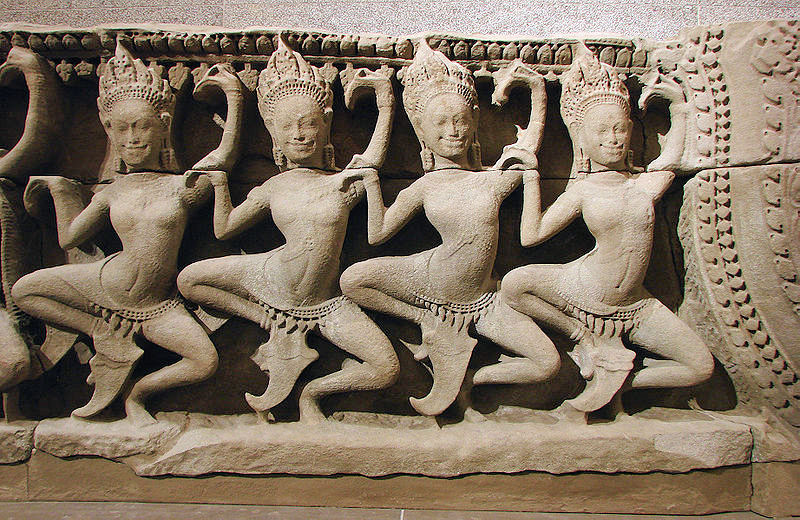
Abb.: Apsaras, Bayon Tempel (ប្រាសាទបាយ័ន),
at Angkor (អង្គរ),
Kambodscha, 12. Jhdt. n. Chr.
[Bildquelle: Vassil / Wikipedia. -- Public domain]
"Apsaras. The Apsarases are the celebrated nymphs of Indra s heaven. The name, which signifies 'moving in the water', has some analogy to that of Aphrodite. They are not prominent in the Vedas, but Urvaśī and a few others are mentioned. In Manu they are said to be the creations of the seven Manus. In the epic poems they become prominent, and the Rāmāyaṇa and the Purāṇas attribute their origin to the churning of the ocean. (See Amṛta.) It is said that when they came forth from the waters neither the gods nor the Asuras would have them for wives, so they became common to all. They have the appella tions of Surānganās, 'wives of the gods', and Sumad-ātmajās 'daughters of pleasure'. "Then from the agitated deep up sprung
The legion of Apsarases, so named
That to the watery element they owed
Their being. Myriads were they born, and all
In vesture heavenly clad, and heavenly gems :
Yet more divine their native semblance, rich
With all the gifts of grace, of youth and beauty.
A train innumerous followed ; yet thus fair,
Nor god nor demon sought their wedded love :
Thus Rāghava ! they still remain their charms
The common treasure of the host of heaven."(Rāmāyaṇa) WILSON.
In the Purāṇas various gaṇas or classes of them are mentioned with distinctive names. The Vāyu Purāṇa enumerates fourteen, the Hari-vaṃśa seven classes. They are again distinguished as being daivika, 'divine', or laukika, 'worldly'. The former are said to be ten in number and the latter thirty-four, and these are the heavenly charmers who fascinated heroes, as Urvaśī, and allured austere sages from their devotions and penances, as Menakā and Rambhā, The Kāśī-khaṇḍa says "there are thirty-five millions of them, but only one thousand and sixty are the principal."
The Apsarases, then, are fairylike beings, beautiful and voluptuous. They are the wives or the mistresses of the Gandharvas, and are not prudish in the dispensation of their favours. Their amours on earth have been numerous, and they are the rewards in Indra s paradise held out to heroes who fall in battle. They have the power of changing their forms ; they are fond of dice, and give luck to whom they favour. In the Atharva-veda they are not so amiable ; they are supposed to produce madness (love's madness !), and so there are charms and incantations for use against them. There is a long and exhaustive article on the Apsarases in Goldstiicker's Dictionary, from which much of the above has been adapted. As regards their origin he makes the following speculative observations : "Originally these divinities seem to have been personifications of the vapours which are attracted by the sun and form into mist or clouds ; their character may be thus interpreted in the few hymns of the Ṛg-veda where mention is made of them. At a subsequent period . . . (their attributes expanding with those of their associates the Gandharvas), they became divinities which represent phenomena or objects both of a physical and ethical kind closely associated with that life" (the elementary life of heaven)."
[Quelle: Dowson, John <1820-1881>: A classical dictionary of Hindu mythology and religion, geography, history, and literature. -- London, Trübner, 1879. -- s.v. ]
3 Yakṣa - यक्ष m.: Yakṣa (Spukgestalt)
Jātarūpa: "Yakṣas sind Fleischfresser. Kubera usw." (मांसादा यक्षाः । कुबेरादयः)
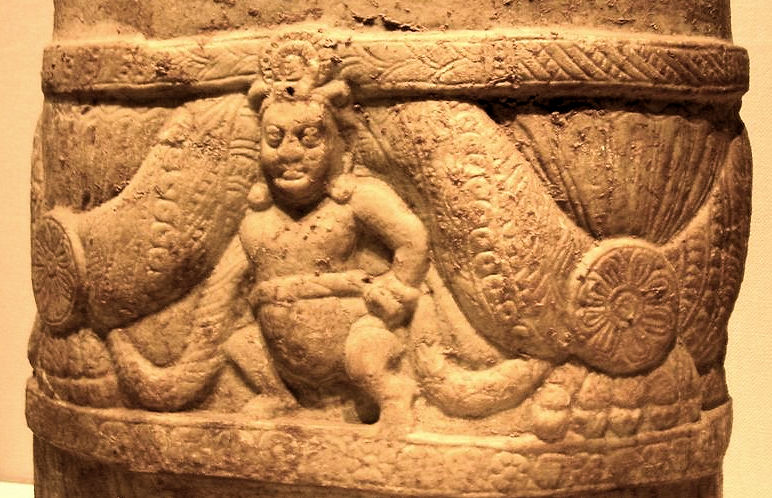
Abb.: Yakṣa, Amaravatī (अमरावती), 3. Jhdt. n. Chr.
[Bildquelle: Kajasudhakarababu / Wikipedia. -- Public domain]
"Yakṣa. A class of supernatural beings attendant on Kuvera, the god of wealth. Authorities differ as to their origin. They have no very special attributes, but they are generally considered as inoffensive, and so are called Puṇya-janas, good people, but they occasionally appear as imps of evil. It is a Yakṣa in whose mouth Kāli-dāsa placed his poem Megha-dūta (cloud messenger)." [Quelle: Dowson, John <1820-1881>: A classical dictionary of Hindu mythology and religion, geography, history, and literature. -- London, Trübner, 1879. -- s.v.]
4 Rakṣas - रक्षस् n.: Rakṣas (Unhold)
Jātarūpa: "Raksas sind Vibhīṣaṇa usw." (रक्षांसि विभीषणादयः)
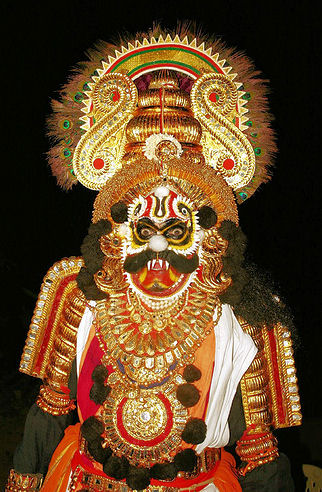
Abb.: Rakṣas, Yakṣagāna (ಯಕ್ಷಗಾನ),
Karnataka (ಕರ್ನಾಟಕ)
[Bildquelle: Manohara Upadhya / Wikipedia. -- GNU FDLicense]
"Rakṣas, Rakṣasa. Goblins or evil spirits. They are not all equally bad, but have been classified as of three sorts
one as a set of beings like the Yakshas,
another as a sort of Titans or enemies of the gods,
and lastly, in the common acceptation of the term, demons and fiends who haunt cemeteries, disturb sacrifices, harass devout men, animate dead bodies, devour human beings, and vex and afflict mankind in all sorts of ways.
These last are the Rakṣasas of whom Rāvaṇa was chief, and according to some authorities, they are descended, like Rāvaṇa himself, from the sage Pulastya. According to other authorities, they sprang from Brahmā' foot. The Viṣṇu Purāṇa also makes them descendants of Kaśyapa and Khaśā, a daughter of Dakṣa, through their son Rakṣas ; and the Rāmāyaṇa states that when Brahmā created the waters, he formed certain "beings to guard them who were called Rakṣasas (from the root rakṣ, 'to guard', but the derivation from this root may have suggested the explanation), and the Viṣṇu Purāṇa gives a somewhat similar derivation.
It is thought that the Rakshasas of the epic poems were the rude barbarian races of India who were subdued by the Aryans.
When Hanumān entered the city of Laṅkā to reconnoitre in the form of a cat, he saw that "the Rakṣasas sleeping in the houses were of every shape and form. Some of them disgusted the eye, while some were beautiful to look upon. Some had long arms and frightful shapes ; some were very fat and some were very lean : some were mere dwarfs and some were prodigiously tall. Some had only one eye and others only one ear. Some had monstrous bellies, hanging breasts, long projecting teeth, and crooked thighs ; whilst others were exceedingly beautiful to behold and clothed in great splendour. Some had two legs, some three legs, and some four legs. Some had the heads of serpents, some the heads of donkeys, some the heads of horses, and some the heads of elephants." (Rāmāyaṇa.)
The Rakshasas have a great many epithets descriptive of their characters and actions. They are called Anuśaras, Aśaras, and Hanūṣas, 'killers or hurters' ; Iṣṭi-pacas, 'stealers of offerings'; Sandhyā-balas, 'strong in twilight' ; Kṣapāṭas, Naktaṃcaras, Rātri-caras, and Śamanī-ṣadas, 'night-walkers'; Nṛagdhas or Nṛ-cakṣas, 'cannibals' ; Palalas, Palādas, Palaṅkaṣas, Kravyāds, 'carnivorous'; Asra-pas, Aśṛk-pas, Kauna-pas, Kīlāla-pas, and Rakta-pas, 'blood-drinkers'; Dandaśukas, 'biters'; Praghasas, 'gluttons'; Malina-mukhas, 'black-faced'; Karbūras, &c. But many of these epithets are not reserved exclusively for Rakṣasas."
[Quelle: Dowson, John <1820-1881>: A classical dictionary of Hindu mythology and religion, geography, history, and literature. -- London, Trübner, 1879. -- s.v.]
5 Gandharva - गन्धर्व m.: Gandharva (himmlischer Musiker)
Jātarūpa: "Gandharven sind himmlische Sänger. Hāhā, Hūhū usw." (गन्धर्वा दिव्यगायना हाहाहूहूप्रभृतयः)
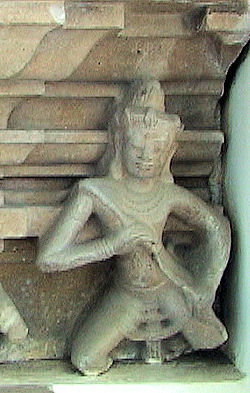
Abb.: Gandharva, Champa, Vietnam, 10. Jhdt. n. Chr.
[Bildquelle: DoktorMax/ Wikipedia. -- Public domain]
"Gandharva. The heavenly Gandharva of the Veda was a deity who knew and revealed the secrets of heaven and divine truths in general. He is thought by Goldstücker to have been a personification of the fire of the sun. The Gandharvas generally had their dwelling in the sky or atmosphere, and one of their offices was to prepare the heavenly soma juice for the gods. They had a great partiality for women, and had a mystic power over them. The Atharva-veda speaks of "the 6333 Gandharvas." The Gandharvas of later times are similar in character; they have charge of the soma, are skilled in medicine, regulate the asterisms, and are fond of women. Those of Indra s heaven are generally intended by the term, and they are singers and musicians who attend the banquets of the gods.
The Purāṇas give contradictory accounts of the origin of the Gandharvas. The Viṣṇu Purāṇa says, in one place, that they were born from Brahmā, "imbibing melody. Drinking of the goddess of speech (gām dhayantah), they were born, and thence their appellation." Later on it says that they were the offspring of Kaśyapa and his wife Ariṣṭā. The Hari-vaṃśa states that they sprang from Brahmā's nose, and also that they were descended from Muni, another of Kaśyapa's wives. Citra-ratha was chief of the Gandharvas ; and the Apsarases were their wives or mistresses. The "cities of the Gandharvas" are often referred to as being very splendid. The Viṣṇu Purāṇa has a legend of the Gandharvas fighting with the Nāgas in the infernal regions, whose dominions they seized and whose treasures they plundered. The Nāga chiefs appealed to Viṣṇu for relief, and he promised to appear in the person of Purukutsa to help them. Thereupon the Nāgas sent their sister Narmadā (the Nerbudda river) to this Purukutsa, and she conducted him to the regions below, where he destroyed the Gandharvas. They are sometimes called Gātus and Pulakas. In the Mahā-bhārata, apparently, a race of people dwelling in the hills and wilds is so called."
[Quelle: Dowson, John <1820-1881>: A classical dictionary of Hindu mythology and religion, geography, history, and literature. -- London, Trübner, 1879. -- s.v.]
6 Kinnara - किन्नर m.: Kinnara (halb menschlich, halb tierisches Wesen)
Jātarūpa: Kinnaras haben einen menschlichen Körper und Pferdegesichter, sie bringen himmlischen Gesang zum Ertönen." (किन्नरा नरशरीरा अश्वमुखा दिव्यगीतध्वनयः)
"Kinnara. Kiṃnara. 'What men?' Mythical beings with the form of a man and the head of a horse. They are celestial choristers and musicians, dwelling in the paradise of Kuvera on Kailāsa. They sprang from the toe of Brahmā with the Yakṣas, but according to others, they are sons of Kaśyapa. They are also called Aśva-mukhas, Turaṅga-vaktras, 'horse-faced', and Mayus." [Quelle: Dowson, John <1820-1881>: A classical dictionary of Hindu mythology and religion, geography, history, and literature. -- London, Trübner, 1879. -- s.v.]
7 Piśāca - पिशाच m.: Piśāca7 (Dämon)
"Piśāca m., Piśācī f. Fiends, evil spirits placed by the Vedas as lower than Rakṣasas. The vilest and most malignant order of malevolent beings. Accounts differ as to their origin. The Brāhmaṇa and the Mahā-bhārata say that they were created by Brahmā, together with the Asuras and Raksṣasas, from the stray drops of water which fell apart from the drops out of which gods, men, gandharvas, &c., had been produced. According to Manu they sprang from the Prajāpatis. In the Purāṇas they are represented as the offspring of Kaśyapa by his wife Krodhavaśā, or Piśācā, or Kapiśā. [Quelle: Dowson, John <1820-1881>: A classical dictionary of Hindu mythology and religion, geography, history, and literature. -- London, Trübner, 1879. -- s.v.]
8 Guhyaka - गुह्यक m.: Guhyaka (Geheime)
Jātarūpa: "Guhyakas behüten verborgene Schätze. Maṇibhadra usw." (गुह्यका निधिपा मणिभद्रादयः)
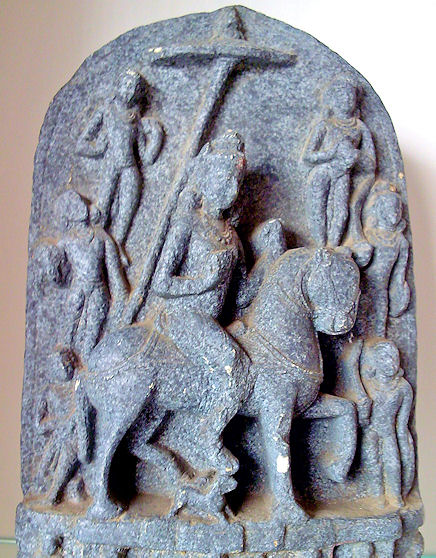
Abb.: Revanta, Chef der Guhyakas, Bengalen, 11. Jhdt n. Chr.
[Bildquelle: Redtigerxyz / Wikipedia. -- GNU FDLicense]
"Guhyaka. Hidden beings. Inferior divinities attendant upon Kuvera, and guardians of his hidden treasures." [Quelle: Dowson, John <1820-1881>: A classical dictionary of Hindu mythology and religion, geography, history, and literature. -- London, Trübner, 1879. -- s.v.]
9 Siddha - सिद्ध m.: Siddha (Vollendeter)
Jātarūpa: "Siddhas besitzen die achtfachen übernatürlichen Kräfte." (सिद्धा अष्टगुणैश्वर्याः)
"Siddhas. A class of semi-divine beings of great purity and holiness, who dwell in the regions of the sky between the earth and the sun. They are said to be 88,000 in number." [Quelle: Dowson, John <1820-1881>: A classical dictionary of Hindu mythology and religion, geography, history, and literature. -- London, Trübner, 1879. -- s.v.]
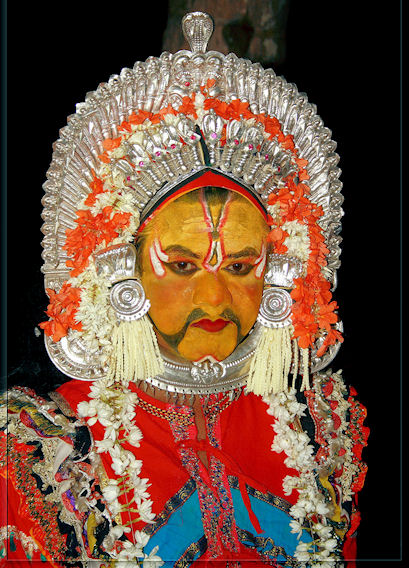
Abb.: Bhūta, Udupi (ಉಡುಪಿ),
Karnataka
[Bildquelle: Shrinis. -- http://www.flickr.com/photos/shrinivasap/3060782411/. -- Zugriff am 2010-06-25. -- Creative Commons Lizenz (Namensnennung, keine kommerzielle Nutzung)]
10 Bhūta - भूत m.: Bhūta (Gespenst, Dämon)
Jātarūpa: "Bhūtas sind Unterarten der Piśāca. Adhomukha, Ūrdhvamukha etc." (भूताः पिशाचप्रभदा अधोमुखोर्ध्वमुखादयः)
"Bhūta. A ghost, imp, goblin. Malignant spirits which haunt cemeteries, lurk in trees, animate dead bodies, and delude and devour human beings. According to the Viṣṇu Purāṇa they are "fierce beings and eaters of flesh," who were created by the Creator when he was incensed. In the Vāyu Purāṇa their mother is said to have been Krodhā, anger. The Bhūtas are attendants of Śiva, and he is held to be their king." [Quelle: Dowson, John <1820-1881>: A classical dictionary of Hindu mythology and religion, geography, history, and literature. -- London, Trübner, 1879. -- s.v.]
11. asurā daitya-daiteya-danujendrāri-dānavāḥ
śukraśiṣyā ditisutāḥ pūrvadevāḥ suradviṣaḥ
असुरा दैत्य-दैतेय-दनुजेन्द्रारि-दानवाः ।
शुक्रशिष्या दितिसुताः पूर्वदेवाः सुरद्विषः ॥११॥
[Bezeichnungen für Gegengötter sind:]
Erläuterungen:
1 Asura - असुर m.: Asura1 (Gegengott)
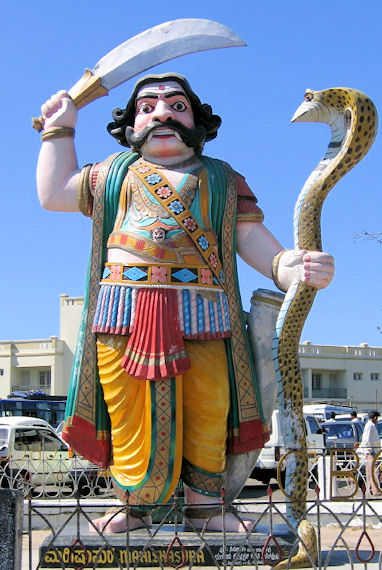
Abb.: Mahiṣāsura, der König der Asuras, Chamundi Hills bei Mysore (ಮೈಸೂರು)
[Bildquelle: Ashwatham / Wikipedia. -- GNU FDLicense]
"Asura. 'Spiritual, divine'. In the oldest parts of the Ṛgveda this term is used for the supreme spirit, and is the same as the Ahura of the Zoroastrians. In the sense of god it was applied to several of the chief deities, as to Indra, Agni, and Varuṇa, It afterwards acquired an entirely opposite meaning, and came to signify, as now, a demon or enemy of the gods. The word is found with this signification in the later parts of the Ṛg-veda, particularly in the last book, and also in the Atharvaveda. The Brāhmaṇas attach the same meaning to it, and record many contests between the Asuras and the gods. According to the Taittirīya Brāhmaṇa, the breath (asu) of Prajāpati became alive, and "with that breath he created the Asuras." In another part of the same work it is said that Prajāpati "became pregnant. He created Asuras from his abdomen." The Śatapatha Brāhmaṇa accords with the former statement, and states that "he created Asuras from his lower breath." The Taittirīya Āraṇyaka represents that Prajāpati created "gods, men, fathers, Gandharvas, and Apsarases" from water, and that the Asuras, Rakṣasas, and Piśācas sprang from the drops which were spilt. Manu's statement is that they were created by the Prajāpatis. According to the Viṣṇu Purāṇa, they were produced from the groin of Brahmā (Prajāpati). The account of the Vāyu Purāṇa is : "Asuras were first produced as sons from his (Prajāpati's) groin. Asu is declared by Bāhmaṇs to mean breath. From it these beings were produced ; hence they are Asuras." The word has long been used as a general name for the enemies of the gods, including the Daityas and Dānavas and other descendants of Kaśyapa, but not including the Rakṣasas descended from Pulastya. In this sense a different derivation has been found for it : the source is no longer asu, breath, but the initial a is taken as the negative prefix, and a-sura signifies not a god ; hence, according to some, arose the word sura, commonly used for a god. See Sura." [Quelle: Dowson, John <1820-1881>: A classical dictionary of Hindu mythology and religion, geography, history, and literature. -- London, Trübner, 1879. -- s.v.]
2 Daitya, Daiteya, Ditisuta - दैत्य m., दैतेय m., दितिसुत m.: Diti-Sohn
"Daitya, Daiteya, Ditisuta. Titans. Descendants from Diti by Kaśyapa. They are a race of demons and giants, who warred against the gods and interfered with sacrifices. They were in turn victorious and vanquished. They and the Dānavas are generally associated, and are hardly distinguishable. As enemies of sacrifices they are called Kratu-dviṣas." [Quelle: Dowson, John <1820-1881>: A classical dictionary of Hindu mythology and religion, geography, history, and literature. -- London, Trübner, 1879. -- s.v.]
"Diti. A goddess or personification in the Vedas who is associated with Aditi, and seems to be intended as an antithesis or as a complement to her. In the Rāmāyaṇa and in the Purāṇas she is daughter of Dakṣa, wife of Kaśyapa, and mother of the Daityas. The Viṣṇu Purāṇa relates that having lost her children, she begged of Kaśyapa a son of irresistible prowess, who should destroy Indra. The boon was granted, but with this condition : "If, with thoughts wholly pious and person entirely pure, you care fully carry the babe in your womb for a hundred years." She assiduously observed the condition ; but Indra knew what was preparing for him. So he went to Diti and attended upon her with the utmost humility, watching his opportunity. In the last year of the century, Diti retired one night to rest without washing her feet. Indra then with his thunderbolt divided the embryo in her womb into seven portions. Thus mutilated, the child cried bitterly, and Indra being unable to pacify it, became angry, and divided each of the seven portions into seven, thus forming the swift-moving deities called Maruts, from the words, "Mā rodīḥ, 'Weep not', which Indra used to quiet them."
[Quelle: Dowson, John <1820-1881>: A classical dictionary of Hindu mythology and religion, geography, history, and literature. -- London, Trübner, 1879. -- s.v.]
3 Dānava, Danuja - दानव m., दनुज m.: Danu-Sohn
"Dānava, Danuja. Descendants from Danu by the sage Kaśyapa. They were giants who warred against the gods. See Daityas." [Quelle: Dowson, John <1820-1881>: A classical dictionary of Hindu mythology and religion, geography, history, and literature. -- London, Trübner, 1879. -- s.v.]
4 Śukraśiṣya - शुक्रशिष्य m.: Schüler Śukras (des Planeten Venus)
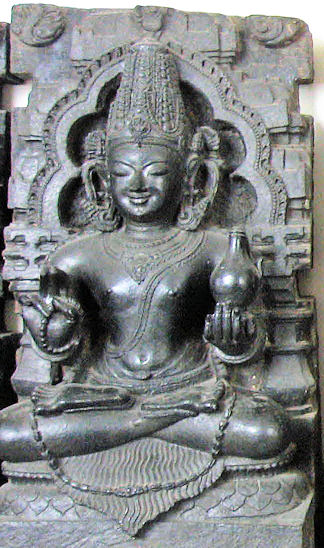
Abb.: Śukra
[Bildquelle: Redtigerxyz / Wikimedia. -- Creative Commons Lizenz (Namensnennung, share alike)]
"Śukra. The planet Venus and its regent. Śukra was son of Bhṛgu and priest of Bali and the Daityas (Daitya-guru). He is also called the son of Kavi. His wife's name was Śuśumā or Śata-parvā. His daughter Devayānī married Yayāti of the Lunar race, and her husband's infidelity induced Śukra to curse him. Śukra is identified with Uśanas, and is author of a code of law. The Hari-vaṃśa relates that he went to Śiva and asked for means of protecting the Asuras against the gods, and for obtaining his object he performed "a painful rite, imbibing the smoke of chaff with his head downwards for a thousand years." In his absence the gods attacked the Asuras and Viṣṇu killed his mother, for which deed Śukra cursed him "to be born seven times in the world of men." Śukra restored his mother to life, and the gods being alarmed lest Śukra's penance should be accomplished, Indra sent his daughter Jayantī to lure him from it. She waited upon him and soothed him, but he accomplished his penance and afterwards married her. Śukra is known by his patronymic Bhārgava, and also as Bhṛgu. He is also Kavi or Kāvya, 'the poet'. The planet is called Āsphujit, 'Ἀφροδίτη'; Maghā-bhava, 'son of Maghā'; Ṣodaśāṃśu, 'having sixteen rays' ; and Śveta, 'the white'." [Quelle: Dowson, John <1820-1881>: A classical dictionary of Hindu mythology and religion, geography, history, and literature. -- London, Trübner, 1879. -- s.v.]
13. sarvajñaḥ sugataḥ buddho dharmarājas tathāgataḥ
samantabhadro bhagavān mārajil lokajij jinaḥ
14. ṣaḍabhijño daśabalo 'dvayavādī vināyakaḥ
munīndraḥ śrīghanaḥ śāstā muniḥ śākyamunis tu yaḥ
15. sa śākyasiṃhaḥ sarvārthasiddhaḥ śauddhodaniś ca saḥ
gautamaś cārkabandhuś ca māyādevīsutaś ca saḥ
सर्वज्ञः सुगतः बुद्धो धर्मराजस् तथागतः ।
समन्तभद्रो भगवान् मारजिल् लोकजिज् जिनः ॥१३॥
षडभिज्ञो दशबलो
ऽद्वयवादी
विनायकः ।
मुनीन्द्रः श्रीघनः शास्ता मुनिः शाक्यमुनिस् तु यः ॥१४॥
स शाक्यसिंहः सर्वार्थसिद्धः शौद्धोदनिश्च सः
गौतमश्चार्कबन्धुश्च मायादेवीसुतश्च सः ॥१५॥
[Bezeichnungen für einen Buddha sind:]
सर्वज्ञ m.: Allwissender
सुगत m.: gut (durch die Wiedergeburten) Gegangener
बुद्ध m.: Erwachter
धर्मराजन् m.: König des Richtigen
तथागत m.: Zur Wahrheit Gelangter, Wahrheitsfinder
समन्तभद्र m.: voll Glücklicher
भगवन्त् m.: Ehrwürdiger
मारजित् m.: Māra-Besieger1
लोकजित् m.: Welten-Besieger
जिन m.: Sieger
षडभिज्ञ m.: die sechs Geisteskräfte2 Besitzender
दशबल m.: die zehn Kräfte3 Besitzender
अद्वयवादिन् m.: unzweideutig Sprechender
विनायक m.: Führer
मुनीन्द्र m.: Fürst der Weisen
श्रीघन m.: voller Herrlichkeit
शास्तृ m.: Lehrer
मुनि m.: Weiser
Erläuterungen:
1 Mārajit - मारजित् m.: Māra-Besieger
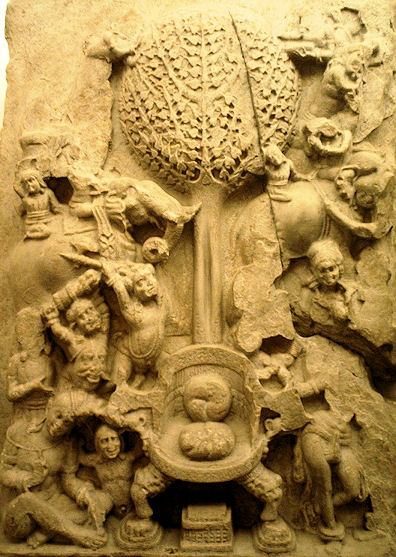
Abb.: Māras Angriff auf Buddha, Amaravati, 2. Jhdt. n. Chr.
[Bildquelle: Gurubrahma / Wikipedia. -- GNU FDLicense]
"Māra Generally regarded as the personification of Death, the Evil One, the Tempter (the Buddhist counterpart of the Devil or Principle of Destruction). The legends concerning Māra are, in the books, very involved and defy any attempts at unravelling them. In the latest accounts, mention is made of five Māras.
[...]
The later books, especially the Nidānakathā of the Jātaka Commentary (J.i.71ff.; cp. MA.i.384) and the Buddhavamsa Commentary (p. 239f), contain a very lively and detailed description of the temptation of the Buddha by Māra, as the Buddha sat under the Bodhi tree immediately before his Enlightenment. These accounts describe how Māra, the devaputta, seeing the Bodhisatta seated, with the firm resolve, of becoming a Buddha, summoned all his forces and advanced against him. These forces extended to a distance of twelve yojanas to the front of the Bodhisatta, twelve to the back, and nine each to the right and to the left. Māra himself, thousand armed, rode on his elephant, Girimekhala, one hundred and fifty leagues in height. His followers assumed various fearsome shapes and were armed with dreadful weapons. At Māra's approach, all the various Devas, Nāgas and others, who were gathered round the Bodhisatta singing his praises and paying him homage, disappeared in headlong flight. The Bodhisatta was left alone, and he called to his assistance the ten pārami which he had practiced to perfection. "
[Malalasekera, G. P. <1899 - 1973>: Dictionary of Pâli proper names. -- Nachdruck der Ausgabe 1938. -- London : Pali Text Society, 1974. -- 2 vol. -- 1163, 1370 S. -- ISBN 0860132692. s.v.]
2 Ṣaḍabhijña - षडभिज्ञ m.: die sechs Geisteskräfte Besitzender
Jātarūpa: "[Die sechs höheren Geisteskräfte sind:]
- das himmlishce Auge
- das himmlische Ohr
- Erinnerung an frühere eigene Daseinsformen
- die Erkenntnis der Gedanken anderer
- außergewöhnliche Macht
- Triebversiegung
(दिव्यचक्षुर्दिव्यश्रोत्रं पूर्वनिवासानुस्मृतिः परचित्ताज्ञानमृद्धिराश्रवक्ष्यश्चेति)
Abhiññā f. -- höhere Geisteskräfte
- lokiyā abhiññā f. -- weltliche höhere Geisteskräfte:
1. iddhi-vidhā f. -- die verschiedenen Fähigkeiten außergewöhnlicher Macht (iddhi):
- einer seiend wird er vielfach und vielfach geworden wird er wieder einer
- er macht sich sichtbar und unsichtbar
- ungehindert schwebt er durch Wände, Mauern und Berge hindurch
- auf dem Wasser schreitet er dahin ohne unterzusinken
- in der Erde taucht er auf und unter
- mit gekreuzten Beinen schwebt er durch die Luft
- Sonne und Mond berührt er mit seiner Hand
- bis hinauf zur Brahmawelt hat er über seinen Körper Gewalt
(z.B. auch Sāmaññaphalasutta : Dīghanikāya I, 77)
- 2. dibba-sota -- das himmlische Ohr: Fähigkeit himmlische und menschliche Töne zu hören, ferne und nahe
- 3. parassa ceto-pariyañāṇa n. -- das Durchschauen der Herzen anderer: Erkennen des Bewusstseins anderer, ob gierbehaftet usw.
- 4. pubbe-nivāsānussati f. -- Erinnerung an frühere eigene Daseinsformen
- 5. dibba-cakkhu n. -- das himmlische Auge: man sieht wie andere Wesen vergehen und wiederentstehen
- lokuttarā abhiññā : überweltliche höhere Geisteskraft (durch Vipassanā erreichbar):
6. āsava-kkhaya-ñāṇa n. -- Wissen um die eigene Triebversiegung
(Dutiya-āhuneyyasutta : Aṅguttaranikāya III, 280 - 281; Nal III; 3, 16 - 5, 7; Th 22, 312 - 314)
s. Nāgārjuna: La traité de la grande vertu de sagesse (Mahāprajñāpāramitā`sāstra) / [Trad. par] Étienne Lamotte. -- Tome IV. -- p. 1809 - 1827.
3 Daśabala - दशबल m.: die zehn Kräfte Besitzender
Jātarūpa: "Er ist daśabala, da er folgende 10 Kräfte besitzt:
- Freigebigkeit (dāna)
- Sittlichkeit (śīla)
- Geduld (kṣānti)
- energische Ausdauer (vīrya)
- meditative Versenkung (dhyāna)
- Weisheit (prajñā)
- Kraft (bala)
- Geschicklichkeit in der Wahl der Mittel (upāya)
- Aufmerksamkeit (praṇidhi)
- erlösende Erkenntnis (jñāna)
(दानशीलक्षान्तिवीर्यध्यानप्रज्ञाबलोपायप्रणिधिप्रज्ञानानि दश बलान्यस्येति दशबलः)
Dasa-bala - die zehn Kräfte eines Buddha
- ṭhānāṭhāna-ñāṇa n. -- Erkenntnis, was möglich und was unmöglich ist
- vipāka-ñāṇa n. -- Erkenntnis der Reifung von Kamma in Vergangenheit, Gegenwart und Zukunft mit Möglichkeiten und Ursachen
- sabbatthagāminī-paṭipadā-ñāṇa n. -- Erkenntnis, wohin jeder Weg führt
- nānā-dhātu-ñāṇa n. -- Erkenntnis der Welt mit ihren Elementen
- nānādhimuttika-ñāṇa n. -- Erkenntnis der verschiedenen Neigungen der Wesen
- indriya-paro-pariyatti-ñāṇa n. -- Erkenntnis der Fähigkeiten anderer Wesen
- jhānādi-saṅkilesa-ñāṇa n. -- Erkenntnis der Versenkungszustände (jhāna n.), Befreiungen (vimokkha m.), Zustände der Sammlung (samādhi m.) mit ihren Befleckungen, ihrer Reinigung und Entstehung
- pubbe-nivāsānussati-ñāṇa n. -- Erinnerung an frühere Geburten
- cutūpapāta-ñāṇa n. -- Erkenntnis des Vergehens und Entstehens der Wesen im Saṃsāra
- āsava-kkhaya-ñāṇa n. -- Erkenntnis, dass die Triebe (āsava) verschwunden sind
(Mahāsīhanādasutta : Majjhimanikāya I, 69 - 71; Nal I, 98, 7 - 101, 8; Th 12, 140 - 145; Nyanamoli III, 241 - 243)
s. Nāgārjuna: La traité de la grande vertu de sagesse (Mahāprajñāpāramitā`sāstra) / [Trad. par] Étienne Lamotte. -- Tome III. -- p. 1505 - 1566.
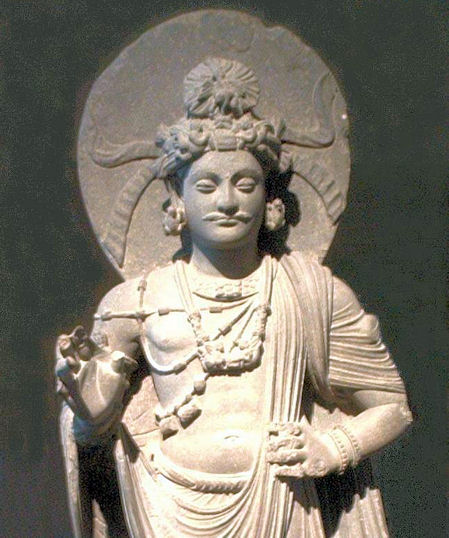
Abb.: Prinz Siddhārtha, Shahbaz-Garhi, Gandhara, 2./3. Jhdt n. Chr.
[Bildquelle: Wikipedia. -- Public domain]
Bezeichnungen für Siddhārtha sind:
शाक्यमुनि m.: Weiser aus dem Volk der Śākya1
शाक्यसिंह m.: Löwe aus dem Volk der Śākya1
सर्वार्थसिद्ध m.: der alle Ziele erreicht hat
शौद्धोदनि m.: Sohn des Śuddhodana2
गौतम m.: zum Gotra Gautama (Nachkommen des Gotama) gehörend
अर्कबन्धु m.: Verwandter der Sonne3
मायादेवीसुत m.: Sohn der Königin Māyā4
Erläuterungen:
1 Śākyamuni - शाक्यमुनि m.: Weiser aus dem Volk der Śākya, Śākyasiṃha - शाक्यसिंह m.: Löwe aus dem Volk der Śākya
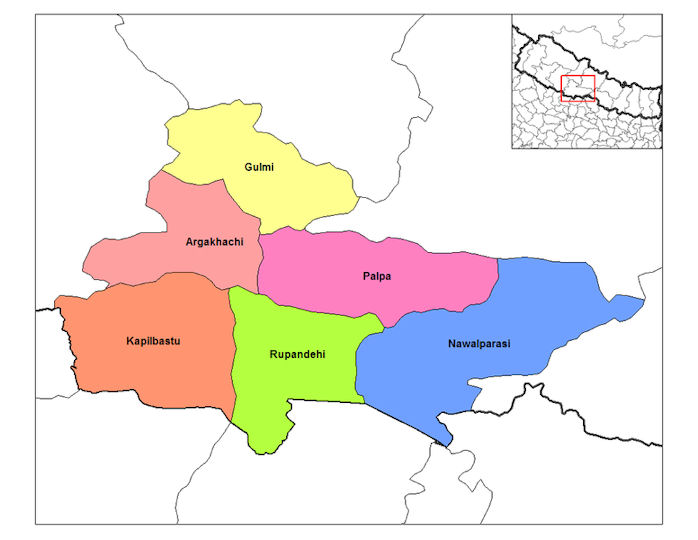
Abb.: Lage von Kapilavastu, Nepal
[Bildquelle: Hégésippe Cormier / Wikipadia. -- Public domain]
"Sokyā, Sakka, Sākiyā A tribe in North India, to which the Buddha belonged. Their capital was Kapilavatthu. Mention is also made of other Sākyan settlements - e.g., Cātumā, Khomadussa, Sāmagāma, Devadaha, Sīlavatī, Nagaraka, Medatalumpa, Sakkhara and Ulumpa (q.v.). Within the Sākyan tribe there were probably several clans, gottā. The Buddha himself belonged to the Gotamagotta. It has been suggested (E.g., Thomas, op. cit., 22) that this was a brahmin clan, claiming descent from the ancient isi Gotama. The evidence for this suggestion is, however, very meagre. Nowhere do we find the Sākyans calling themselves brahmins. On the other hand, we find various clans claiming a share of the Buddha's relics on the ground that they, like the Buddha, were khattiyas (D.ii.165). It is stated a that the Sākyans were a haughty people. Vin.ii.183; D.i.90; J.i.88; DhA.iii.163. Hiouen Thsang, however, found them obliging and gentle in manners (Beal, op. cit., ii.14)."
[Malalasekera, G. P. <1899 - 1973>: Dictionary of Pâli proper names. -- Nachdruck der Ausgabe 1938. -- London : Pali Text Society, 1974. -- 2 vol. -- 1163, 1370 S. -- ISBN 0860132692. s.v.]
2 Śauddhodani - शौद्धोदनि m.: Sohn des Śuddhodana
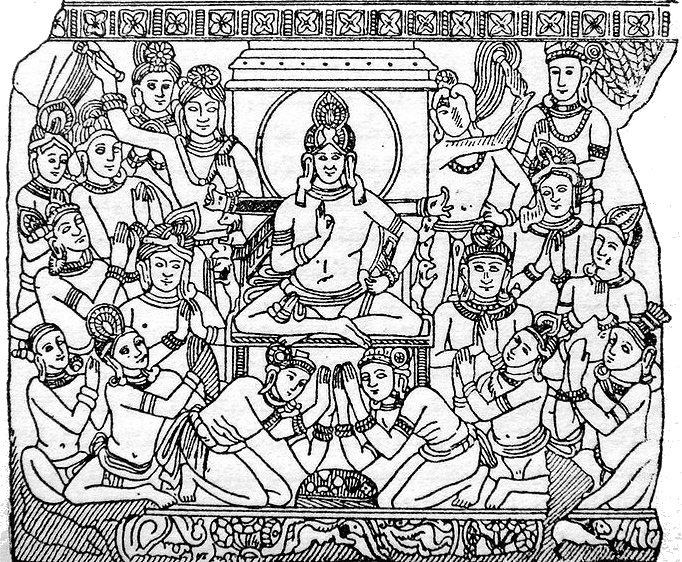
Abb.: König Śuddhodana
[Bildquelle: Encyclopedie Larousse Illustree, 1898. -- Public domain]
"Suddhodana. A Sākiyan Rājā of Kapilavatthu and father of Gotama Buddha. He was the son of Sihahanu and Kaccānā. His brothers were Dhotodana, Sakkodana, Sukkodana and Amitodana, and his sisters were Amitā and Pamitā. Māyā was his chief consort, and, after her death her sister Pajāpatī was raised to her position (Mhv.ii.15f.; Dpv.iii.45; J.i.15, etc.)."
[Malalasekera, G. P. <1899 - 1973>: Dictionary of Pâli proper names. -- Nachdruck der Ausgabe 1938. -- London : Pali Text Society, 1974. -- 2 vol. -- 1163, 1370 S. -- ISBN 0860132692. s.v.]
3 Arkabandhu - अर्कबन्धु m.: Verwandter der Sonne
Jātarūpa: "Verwandter der Sonne, weil er zum Sonnengeschlecht gehört." (अर्कबन्धुः सूर्यवंश्यत्वात्)
Siehe: Mahanama <6. Jhdt n. Chr.>: Mahavamsa : die große Chronik Sri Lankas / übersetzt und erläutert von Alois Payer. -- 2. Kapitel 2: Der Stammbaum Siddhatta's. -- 2006-06-05. -- URL: http://www.payer.de/mahavamsa/chronik02.htm
"SŪRYA-VAṂŚA. 'The Solar race'. A race or lineage of Kṣatriyas which sprank from Ikṣvāku, grandson of the sun. Rāma was of this race, and so were many other great kings and heroes. Many Rājputs claim descent from this and the other great lineage, the Lunar race. The Rāna of Udaypur claims to be of the Sūrya-vaṃśa, and the Jhārejas of Cutch and Sindh assert a descent from the Candra-vaṃśa. There were two dynasties of the Solar race. The elder branch, which reigned at Ayodhyā, descended from Ikṣvāku through his eldest son, Vikukṣi. The other dynasty, reigning at Mithilā, descended from another of Ikṣvāku's sons, named Nimi."
[Quelle: Dowson, John <1820-1881>: A classical dictionary of Hindu mythology and religion, geography, history, and literature. -- London, Trübner, 1879. -- s.v.]
4 Māyādevīsuta - मायादेवीसुत m.: Sohn der Königin Māyā
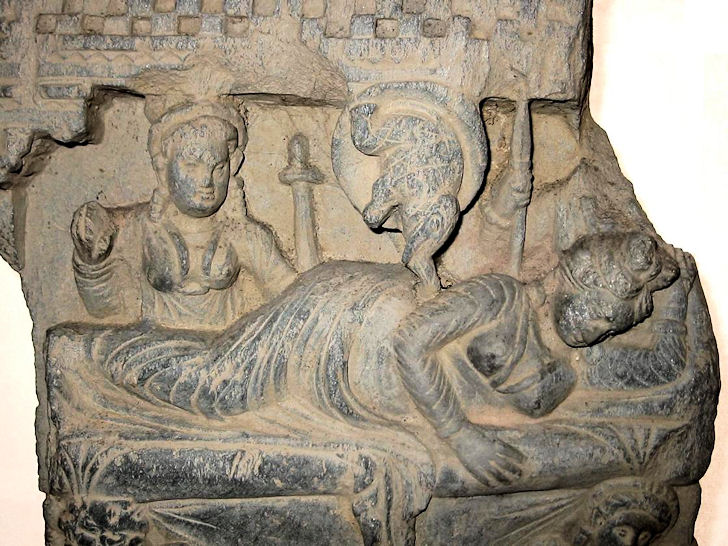
Abb.: Königin Māyās Traum, Gandhara, 2./3. Jhdt n. Chr.
[Bildquelle: PHG / Wikipedia. -- GNU FDLicense]
"Māyā, Mahāmāyā The mother of the Buddha (D.ii.52; see Thomas: op. cit., 25).
Her father was the Sākiyan Añjana of Devadaha, son of Devadahasakka, and her mother Yasodharā, daughter of Jayasena. (Mhv.ii.17ff.; elsewhere her father is called Mahā Suppabuddha (ThigA.141), while the Apadāna (ii.538) gives the name of her mother as Sulakkhanā).
Dandapāni and Suppabuddha were her brothers, and Mahā Pajāpatī her sister. Both the sisters were married to Suddhodana in their youth, but it was not till Māyā was between forty and fifty that the Buddha was born (Vibhā.278). She had all the qualities necessary for one who was to bear the exalted rank of being the mother of the Buddha: she was not too passionate, she did not take intoxicants, she had practiced the pāramī for one hundred thousand kappas, and had not, since her birth, violated the five sīlā. On the day of her conception she kept her fast, and in her sleep that night she had the following dream: the four Mahārāja gods took her in her bed to Himavā and placed her under a sāla tree on Manosilātala. Then their wives came and bathed her in the Anotatta Lake and clad her in divine robes. They then led her into a golden palace and laid her on a divine couch; there the Bodhisatta, in the form of a white elephant, holding a white lotus in his gleaming trunk, entered into her right side. This was on the day of the Uttarāsālhanakkhatta, after a festival lasting seven days, in which she had already taken part.
From the day of her conception she was guarded by the Four Regent Gods; she felt no desire for men, and the child in her womb could be seen from outside. At the end of the tenth month she wished to return to her people in Devadaha, but, on her way thither, she stopped at the sāla grove in Lumbinī and there her child was born as she stood holding on to the branch of a sāla tree (J.i.49ff). Seven days later Māyā died and was reborn as a male in the Tusita world, under the name of Māyādevaputta (Thag.vss.533f.; ThagA.i.502).
The Buddha visited Tāvatimsa immediately after the performance of the Twin Miracle at the foot of the Gandamba tree, on the full moon day of āsālha, and there, during the three months of the rainy season, the Buddha stayed, preaching the Abhidhamma Pitaka to his mother (who came there to listen to him), seated on Sakka's Pandukambalasilāsana, at the foot of the Pāricchattaka tree. (It is said that, during this time, at certain intervals, the Buddha would return to earth, leaving a seated image of himself in Tāvatimsa to continue the preaching while he attended to his bodily needs, begging alms in Uttarakuru and eating his food on the banks of Anotatta, where Sāriputta waited on him and learnt of what he had been preaching to the devas.) (DhSA.i.15; DhA.iii.216f)
The Commentaries (UdA.276f ) state the view, held by some, that had Māyā been alive the Buddha would not have shown such reluctance to bestow ordination on women. This view, says Dhammapāla is erroneous. It would have made no difference, for it is the dhammatā of all Buddhas that women shall be ordained, but subject to certain important restrictions. The mothers of all Buddhas die very soon after the birth of their son, because no other child is fit to be conceived in the same womb as a Buddha."
[Malalasekera, G. P. <1899 - 1973>: Dictionary of Pâli proper names. -- Nachdruck der Ausgabe 1938. -- London : Pali Text Society, 1974. -- 2 vol. -- 1163, 1370 S. -- ISBN 0860132692. s.v.]
16. brahmātmabhūḥ surajyeṣṭhaḥ parameṣṭhī pitāmahaḥ
hiraṇyagarbho lokeśaḥ svayaṃbhūś caturānanaḥ
17. dhātābjayonir druhiṇo viriñciḥ kamalāsanaḥ
sraṣṭā prajāpatir vedhā vidhātā viśvasṛg vidhiḥ
18. nābhijanmāṇḍajaḥ pūrvo nidhanaḥ kamalodbhavaḥ
sadānando rajomūrtiḥ satyako haṃsavāhanaḥ
ब्रह्मात्मभूह् सुरज्येष्ठः परमेष्ठी पितामहः ।
हिरण्यगर्भो लोकेशः स्वयम्भूश् चतुराननः ॥१६॥
धाताब्जयोनिर् द्रुहिणो विरिञ्चिः कमलासनः ।
स्रष्टा प्रजापतिर् वेधा विधाता विश्वसृग् विधिः ॥१७॥
नाभिजन्माण्डजः पूर्वो निधनः कमलोद्भवः ।
सदानन्दो रजोमूर्तिः सत्यको हंसवाहनः ॥१८॥
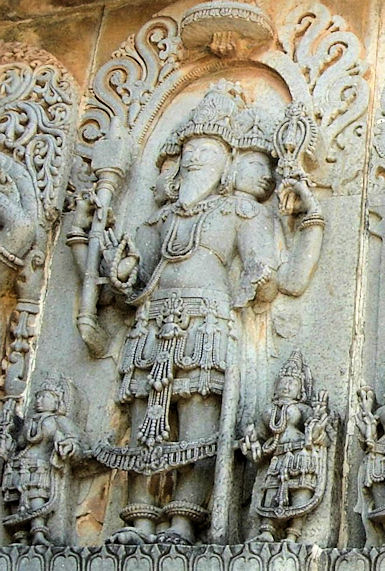
Abb.: Brahmā, Halebidu (ಹಳೆಬೀಡು), Karnataka (ಕರ್ನಾಟಕ),
12. Jhdt. n. Chr.
[Bildquelle: Calvinkrishy / Wikipedia. -- GNU FDLIcense]
[Bezeichnungen für Brahmā sind:]
Erläuterungen:
1 Brahman - ब्रह्मन् m.: Brahmā
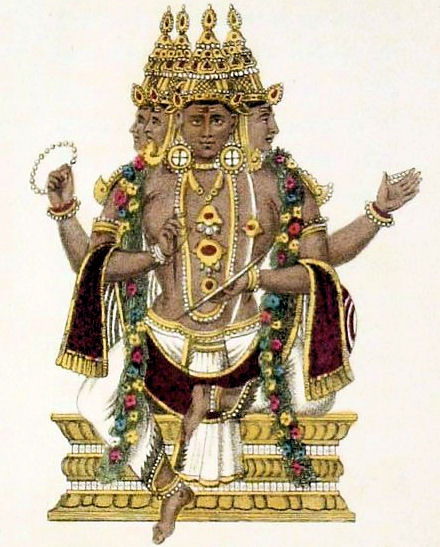
Abb.: Brahmā
[Bildquelle: Frederic Shoberl: The World in Miniature: Hindoostan. -- London :
R. Ackerman, 1820's. -- Public domain]
"BRAHMĀ (masculine). The first member of the Hindu triad; the supreme spirit manifested as the active creator of the universe. He sprang from the mundane egg deposited by the supreme first cause, and is the Prajāpati, or lord and father of all creatures, and in the first place of the Ṛṣis or Prajāpatis. When Brahmā has created the world it remains unaltered for one of his days, a period of 2,160,000,000 years. The world and all that is therein is then consumed by fire, but the sages, gods, and elements survive. When he awakes he again restores creation, and this process is repeated until his existence of a hundred years is brought to a close, a period which it requires fifteen figures to express. When this period is ended he himself expires, and he and all the gods and sages, and the whole universe are resolved into their constituent elements.
His name is invoked in religious services, but Puṣkara [पुष्कर] (hodie Pokhar), near Ājmīr [अजमेर], is the only place where he receives worship, though Professor Williams states that he has heard of homage being paid to him at Īdar [ઇડર].
Brahmā is said to be of a red colour. He has four heads ; originally he had five, but one was burnt off by the fire of Śiva's central eye because he had spoken disrespectfully. Hence he is called Catur-ānana or Catur-mukha, 'four-faced', and Aṣṭakarṇa, 'eight-eared'. He has four arms; and in his hands he holds his sceptre, or a spoon, or a string of beads, or his bow Parivīta, or a water jug, and the Veda. His consort is Sarasvatī, goddess of learning, also called Brāhmī. His vehicle is a swan or goose, from which he is called Haṃsa-vāhana. His residence is called Brahma-vṛndā.
The name Brahmā is not found in the Vedas and Brāhmaṇas, in which the active creator is known as Hiraṇya-garbha, Prajāpati, &c. ; but there is a curious passage in the Śatapatha Brāhmaṇa which says : "He (Brahma, neuter) created the gods. Having created the gods, he placed them in these worlds : in this world Agni, Vāyu in the atmosphere, and Sūrya in the sky." Two points connected with Brahmā are remarkable.
As the father of men he performs the work of procreation by incestuous intercourse with his own daughter, variously named Vāc or Sarasvatī (speech), Sandhyā (twilight), Śata-rūpā (the hundred-formed), &c.
Secondly, that his powers as creator have been arrogated to the other gods Viṣṇu and Śiva, while Brahmā has been thrown into the shade.
In the Aitareya Brāhmaṇa it is said that Prajāpati was in the form of a buck and his daughter was Rohit, a deer. According to the Śatapatha Brāhmaṇa and Manu, the supreme soul, the self-existent lord, created the waters and deposited in them a seed, which seed became a golden egg, in which he himself was born as Brahmā, the progenitor of all the worlds. As the waters (nara) were "the place of his movement, he (Brahmā) was called Nārayāṇa." Here the name Nārāyaṇa is referred distinctly to Brahmā, but it afterwards became the name of Viṣṇu. The account of the Rāmayaṇa is that "all was water only, in which the earth was formed. Thence arose Brahmā, the self-existent, with the deities. He then, becoming a boar, raised up the earth and created the whole world with the saints, his sons. Brahmā, eternal and perpetually undecaying, sprang from the ether ; from him was descended Marīci ; the son of Mārici was Kaśyapa. From Kaśyapa sprang Vivasvat, and Manu is declared to have been Vivasvat's son." A later recension of this poem alters this passage so as to make Brahmā a mere manifestation of Viṣṇu. Instead of "Brahmā, the self-existent, with the deities," it substitutes for the last three words, "the imperishable Viṣṇu." The Viṣṇu Purāṇa says that the "divine Brahmā called Nārāyaṇa created all beings", that Prajāpati "had formerly, at the commencement of the (previous) kalpas, taken the shape of a fish, a tortoise, &c., (so now), entering the body of a boar, the lord of creatures entered the water." But this "lord of creatures" is clearly shown to be Viṣṇu, and these three forms, the fish, the tortoise, and the boar, are now counted among the Avatāras of Viṣṇu. (See Avatāra.) This attribution of the form of a boar to Brahmā (Prajāpati) had been before made by the Śatapatha Brāhmaṇa, which also says, "Having assumed the form of a tortoise, Prajāpati created offspring." The Liṅga Purāṇa is quite exceptional among the later works in ascribing the boar form to Brahmā. The Mahābhārata represents Brahmā as springing from the navel of Viṣṇu or from a lotus which grew thereout ; hence he is called Nābhi-ja, 'navel-born'; Kanja, 'the lotus'; Sarojin, 'having a lotus'; Abja-ja, Abja-yoni, and Kanja-ja, 'lotus-born'. This is, of course, the view taken by the Vaiṣṇavas. The same statement appears in the Rāmāyaṇa, although this poem gives Brahmā a more prominent place than usual. It represents Brahmā as informing Kāma of his divinity, and of his calling him to heaven in "the glory of Viṣṇu"; He bestowed boons on Rāma while that hero was on earth, and he extended his favours also to Rāvaṇa and other Rakṣasas who were descendants of his son Pulastya. In the Purāṇas also he appears as a patron of the enemies of the gods, and it was by his favour that the Daitya King Bali obtained that almost universal dominion which required the incarnation of Viṣṇu as the dwarf to repress. He is further represented in the Rāmāyaṇa as the creator of the beautiful Ahalyā, whom he gave as wife to the sage Gautama. Brahmā, being thus inferior to Viṣṇu, is represented as giving homage and praise to Viṣṇu himself and to his form Kṛṣṇa, but the Vaiṣṇava authorities make him superior to Rudra, who, they say, sprang from his forehead. The Śaiva authorities make Mahā-deva or Rudra to be the creator of Brahmā, and represent Brahmā as worshipping the Liṅga and as acting as the charioteer of Rudra.
Brahmā was the father of Dakṣa, who is said to have sprung from his thumb, and he was present at the sacrifice of that patriarch, which was rudely disturbed by Rudra. Then he had to humbly submit and appease the offended god. The four Kumāras, the chief of whom was called Sanat-kumāra or by the patronymic Vaidhātra, were later creations or sons of Brahmā,
Brahmā is also called Vidhi, Vedhās, Druhiṇa, and Sraṣṭṛ, 'creator' ; Dhātṛ and Vidhātṛ, 'sustainer' ; Pitāmaha, 'the great father ; Lokeśa, 'lord of the world' ; Parameṣṭa, 'supreme in heaven'; Sanat, 'the ancient'; Ādi-kavi, 'the first poet' ; and Drū-ghaṇa, 'the axe or mallet'."
[Quelle: Dowson, John <1820-1881>: A classical dictionary of Hindu mythology and religion, geography, history, and literature. -- London, Trübner, 1879. -- s.v.]
1a Parameṣṭhin - परमेष्ठिन् m.: an der Spitze stehender
Jātarūpa: "Parameṣṭhin = er steht an der Spitze." (परमे तिष्ठति परमेष्ठी)
1b Pitāmaha - पितामह m.: Großvater
Jātarūpa: "Er ist auch der Vater der Väter, der Schöpfer, darum heißt er 'Großvater'." (पि्तॄणां प्रजापतीनामपि पितेति पितामहः)
2 Hiraṇyagarbha - हिरण्यगर्भ m.: Goldkeim
"HIRAṆYA-GARBHA. 'Golden egg or golden womb'. In the Ṛg-veda Hiraṇya-garbha "is said to have arisen in the beginning, the one lord of all beings, who upholds heaven and earth, who gives life and breath, whose command even the gods obey, who is the god over all gods, and the one animating principle of their being." According to Manu, Hiraṇya-garbha was Brahmā, the first male, formed by the undiscernible eternal First Cause in a golden egg resplendent as the sun. "Having continued a year in the egg, Brahma divided it into two parts by his mere thought, and with these two shells he formed the heavens and the earth ; and in the middle he placed the sky, the eight regions, and the eternal abode of the waters." See Brahmā." [Quelle: Dowson, John <1820-1881>: A classical dictionary of Hindu mythology and religion, geography, history, and literature. -- London, Trübner, 1879. -- s.v.]
3 Caturānana - चतुरानन m.: Viergesichtriger
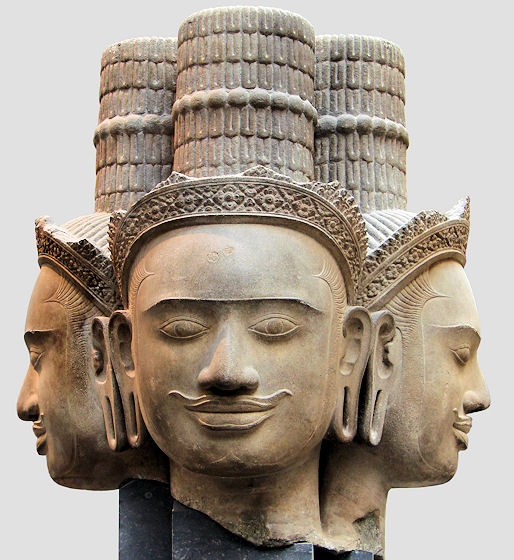
Abb.: Viergesichtiger Brahmā, Phnom Bok, Siemreap, Kambodscha, 1./10. Jhdt. n.
Chr.
[Bildquelle: Vassil / Wikipedia. -- Public domain]
4 Abjayoni - अब्जयोनि m.: aus einem Lotus Entstandener, Kamalodbhava - कमलोद्भव m.: der Lotusentstandene, Nābhijanman - नाभिजन्मन् m.: aus dem Nabel (Viṣṇus) Geborener
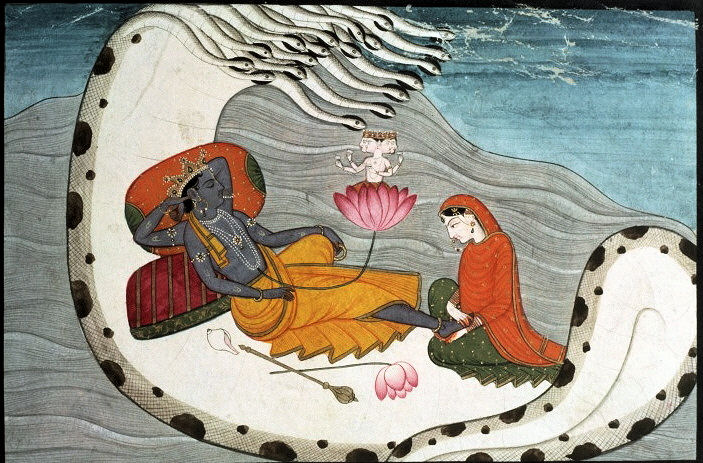
Abb.: Brahmā entsteht aus einem Lotus aus dem Nabel Viṣṇus, der auf der Schlange
Śeṣa liegt, Lakṣmī zu Füßen Viṣṇus, ca. 1870
[Bildquelle: Wikipedia. -- Public domain]
5 Prajāpati - प्रजापति m.: Herr der Geschöpfe
"PRAJĀ-PATI. 'Lord of creatures', a progenitor, creator. In the Veda the term is applied to Indra, Savitṛ, Soma, Hiraṇya-garbha, and other deities. In Manu the term is applied to Brahmā as the active creator and supporter of the universe ; so Brahmā is the Prajā-pati. It is also given to Manu Svāyambhuva himself, as the son of Brahmā and as the secondary creator of the ten Ṛṣis, or "mind-born sons" of Brahmā, from whom mankind has descended. It is to these ten sages, as fathers of the human race, that the name Prajā-pati most commonly is given. They are Marīci, Atri, Aṅgiras, Pulastya, Pulaha, Kratu, Vasiṣṭha, Pracetas or Dakṣa, Bhṛgu, and Nārada. According to some authorities the Prajā-patis are only seven in number, being identical with the seven great Ṛṣis. (See Ṛṣi.) The number and names of the Prajā-patis vary in different authorities : the Mahā-bhārata makes twenty-one." [Quelle: Dowson, John <1820-1881>: A classical dictionary of Hindu mythology and religion, geography, history, and literature. -- London, Trübner, 1879. -- s.v.]
6 Kamalāsana - कमलासन m.: der einen Lotus als Sitz hat, Haṃsavāhana - हंसवाहन m.: der eine Gans als Fahrzeug hat
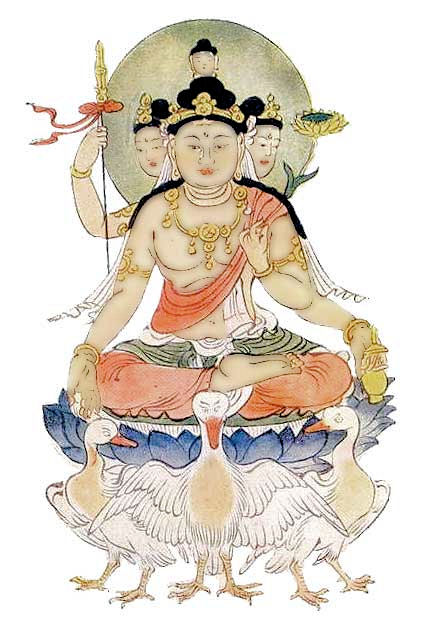
Abb.: Der einen Lotus als Sitz und eine Gans als Fahrzeug hat
[Bildquelle: VanemTao / Wikipedia. -- Creative Commons Lizenz (Namensnennung, share alike)]
18. viṣṇur nārāyaṇaḥ kṛṣṇo vaikuṇṭho viṣṭaraśravāḥ
dāmodaro hṛṣīkeśaḥ keśavo mādhavaḥ svabhūḥ
19. daityāriḥ puṇḍarīkākṣo govindo garuḍadhvajaḥ
pītāmbaro 'cyutaḥ śārṅgī viṣvakseno janārdanaḥ
20. upendra indrāvarajaś cakrapāṇiś caturbhujaḥ
padmanābho madhuripur vāsudevas trivikramaḥ
21. devakīnandanaḥ śauriḥ śrīpatiḥ puruṣottamaḥ
vanamālī balidhvaṃsī kaṃsārātir adhokṣajaḥ
22. viśvambharaḥ kaiṭabhajid vidhuḥ śrīvatsalāñchanaḥ
purāṇapuruṣo yajñapuruṣo narakāntakaḥ
23. jalaśāyī viśvarūpo mukundo muramardanaḥ
विष्णुर् नारायणः कृष्णो वैकुण्ठो विष्टरश्रवाः ।
दामोदरो हृशीकेशः केशवो माधवः स्वभूः ॥१८॥
दैत्यारिः पुण्डरीकाक्षो गोविन्दो गरुडध्वजः ।
पीताम्बरो
ऽच्युतः
शार्ङ्गी विष्वक्सेनो जनार्दनः ॥१९॥
उपेन्द्र इन्द्रावरजश् चक्रपाणिश् चतुर्भुजः ।
पद्मनाभो मधुरिपुर् वासुदेवस् त्रिविक्रमः ॥२०॥
देवकीनन्दनः शौरिः श्रीपतिः पुरुशोत्तमः ।
वनमाली बलिध्वंसी कंसारातिर् अधोक्षजः ॥२१॥
विश्वम्भरः कैटभजिद् विधुः श्रीवत्सलाञ्छनः ।
पुराणपुरुषो यज्ञपुरुषो नरकान्तकः ॥२२॥
जलशायी विश्वरूपो मुकुन्दो मुरमर्दनः ।२३क।
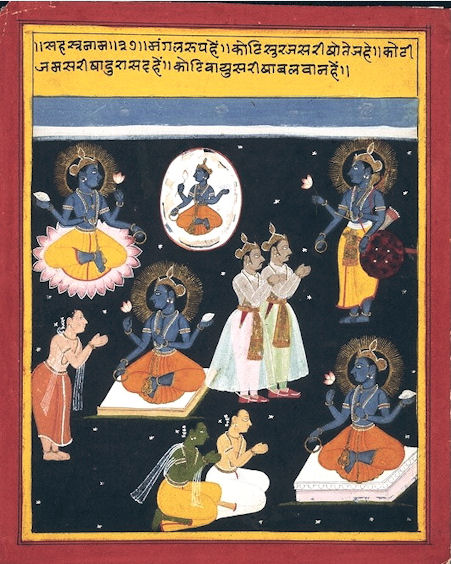
Abb.: Viṣṇu, Viṣṇusahasranāma, Mewar (मेवाड़), ca 1690 n. Chr.
[Bildquelle: Wikipedia. -- Public domain]
[Bezeichnungen für Viṣṇu sind:]
Erläuterungen:
1 Viṣṇu - विष्णु m.: Viṣṇu
Jātarūpa: "Er ist tätig [Wurzel विष् III], deshalb heißt er 'der Wirker' (Viṣṇu)" (विवेष्टीति विष्णुः)
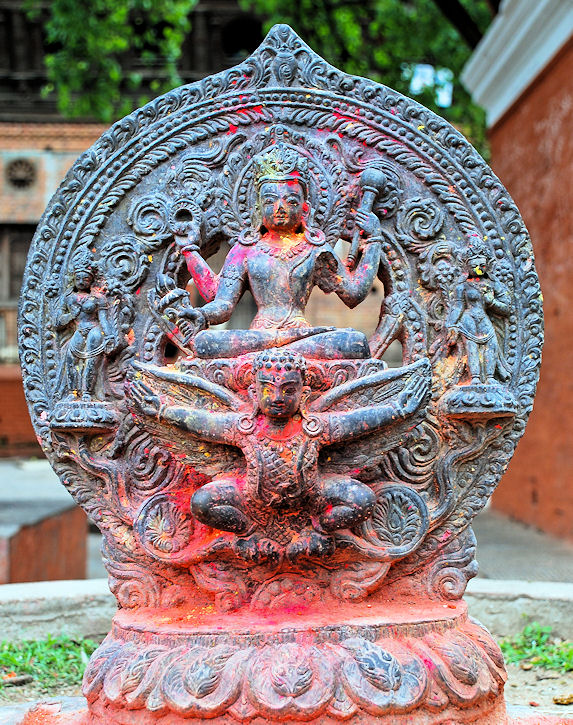
Abb.: Viṣṇu, auf Garuḍa reitend, Lalitpur (लालितपुर), Nepal
[Bildquelle: Markus Koljonen / Wikipedia. -- Creative Commons Lizenz (Namensnennung, share alike)]
"VIṢṆU. Root, viṣ, 'to pervade'. The second god of the Hindu triad In the Ṛg-veda Viṣṇu is not in the first rank of gods. He is a manifestation of the solar energy, and is described as striding through the seven regions of the universe in three steps, and enveloping all things with the dust (of his beams). These three steps are explained by commentators as denoting the three manifestations of light - fire, lightning, and the sun ; or the three places of the sun - its rising, culmination, and setting. In the Veda he is occasionally associated with Indra. He has very little in common with the Viṣṇu of later times, but he is called "the unconquerable preserver," and this distinctly indicates the great preserving power which he afterwards became. In the Brāhmaṇas Viṣṇu acquires new attributes, and is invested with legends unknown to the Vedas, but still very far distant from those of the Purāṇas. In Manu, the name is mentioned, but not as that of a great deity. In the Mahā-bhārata and in the Purāṇas he is the second member of the triad, the embodiment of the Sattva-guṇa, the quality of mercy and goodness, which displays itself as the preserving power, the self-existent, all-pervading spirit. As such, his votaries associate him with the watery element which spread everywhere before the creation of the world. In this character he is called Nārāyaṇa 'moving in the waters', and is represented pictorially in human form slumbering on the serpent Śeṣa and floating on the waters. This, too, is the position he assumes during the periods of temporary annihilation of the universe.
The worshippers of Viṣṇu recognise in him the supreme being from whom all things emanate. In the Mahā-bhārata and in the Purāṇas he is the Prajāpati (creator) and supreme god. As such, he has three Avasthas or conditions :
That of Brahmā, the active creator, who is represented as springing from a lotus which grew from Viṣṇu's navel while he was sleeping afloat upon the waters.
Viṣṇu himself, the preserver, in an Avatāra or incarnate form, as in Kṛṣṇa.
Śiva or Rudra, the destructive power, who, according to a statement of the Mahā-bhārata, sprang from his forehead.
But though the Mahā-bhārata generally allows Viṣṇu the supremacy, it does not do so invariably and exclusively. There are passages which uphold Śiva as the greatest of the gods, and represent Viṣṇu as paying him homage. The Śaiva Purāṇas of course make Śiva supreme.
Viṣṇu's preserving and restoring power has been manifested to the world in a variety of forms called Avatāras, literally 'descents', but more intelligibly incarnations, in which a portion of his divine essence was embodied in a human or supernatural form possessed of superhuman powers. All these Avatāras became manifest for correcting some great evil or effecting some great good in the world. The Avatāras are ten in number, but the Bhāgavata Purāṇa increases them to twenty-two, and adds that in reality they are innumerable. All the ten Avatāras are honoured, but the seventh and eighth, Rāma and Kṛṣṇa, are honoured as great mortal heroes and receive worship as great gods.
Kṛṣṇa is more especially looked upon as a full manifestation of Viṣṇu, and as one with Viṣṇu himself, and he is the object of a widely extended and very popular worship. See Avatāra.
The holy river Ganges is said to spring from the feet of Viṣṇu.
As preserver and restorer, Viṣṇu is a very popular deity, and the worship paid to him is of a joyous character. He has a thousand names (Sahasra-nāma), the repetition of which is a meritorious act of devotion. His wife is Lakṣmī or Śrī, the goddess of fortune, his heaven is Vaikuṇṭha, and his vehicle is the bird Garuḍa. He is represented as a comely youth of a dark-blue colour, and dressed like an ancient king. He has four hands.
One holds the Panhajanya (q.v.), a Śaṅkha or conchshell ;
another the Su-darśana or Vajra-nābha, a cakra or quoit weapon ;
the third, a Gadā or club called Kaumodakī ;
and the fourth, a Padma or lotus.
He has a bow called Śārṅga, and a sword called Nandaka. On his breast are the peculiar mark or curl called Śrī-vatsa and the jewel Kaustubha, and on his wrist is the jewel Syamantaka.
He is sometimes represented seated on a lotus with Lakṣmī beside him, or reclining on a leaf of that plant.
Sometimes he is portrayed reclining on the serpent Śeṣa, and at others as riding on his gigantic bird Garuḍa.
Of the thousand names of Viṣṇu the following are some of the most common : Acyuta, 'unfalien, imperishable' ; Ananta, 'the endless' ; 'Ananta-śayana, 'who sleeps on the serpent Ananta' ; Catur-bhuja, 'four-armed' ; Dāmodara, 'bound round the belly with a rope' ; as Kṛṣṇa ; Govinda or Gopāla, 'the cow-keeper' (Kṛṣṇa); Hari ; Hṛṣīkesa, 'lord of the organs of sense' ; Jala-śayin, 'who sleeps on the waters' ; Janārddana, 'whom men worship' ; Keśava, 'the hairy, the radiant' ; Kirītin, 'wearing a tiara' ; Lakṣmīpati, lord of Lakṣmī ; Madhusūdana, 'destroyer of Madhu' ; Mādhava, 'descendant of Madhu' ; Mukunda, 'deliverer' ; Murāri, 'the foe of Mura' ; Nara, 'the man' ; Nārāyaṇa, 'who moves in the waters' ; Pancāyudha, 'armed with five weapons' ; Padma-nābha, 'lotus-navel' ; Pītāmbara, 'clothed in yellow garments' ; Puruṣa, 'the man, the spirit' ; Puruṣottama, 'the highest of men, the supreme spirit' ; Śārṅgin or Sārṅgi-pāṇi, carrying the bow Śārṅga ; Vāsudeva, Kṛṣṇa, son of Vasudeva; Vārṣṇeya, 'descendant of Vṛṣṇi' ; Vaikuṇṭha-nātha, 'lord of Vaikuṇṭha' (paradise) ; Yajñeśa, Yajñeśvara, lord of sacrifice."
[Quelle: Dowson, John <1820-1881>: A classical dictionary of Hindu mythology and religion, geography, history, and literature. -- London, Trübner, 1879. -- s.v.]
2 Nārāyaṇa - नारायण m.: Nārāyaṇa
Jātarūpa: "Nārāyaṇa = Sohn des Nara, des Urmanns." (नरस्यापत्यं नारायणः)
"NĀRĀYAṆA.
The son of Nara, the original man, and often identified or coupled with Nara.
The creator Brahmā, who, according to Manu, was so called because the waters (nara) were his first ayana or place of motion.
The name is found for the first time in the Śatapatha Brāhmaṇa. The name as commonly used applies to Viṣṇu, and is that under which he was first worshipped."
[Quelle: Dowson, John <1820-1881>: A classical dictionary of Hindu mythology and religion, geography, history, and literature. -- London, Trübner, 1879. -- s.v.]
3 Kṛṣṇa - कृष्ण m.: Kṛṣṇa
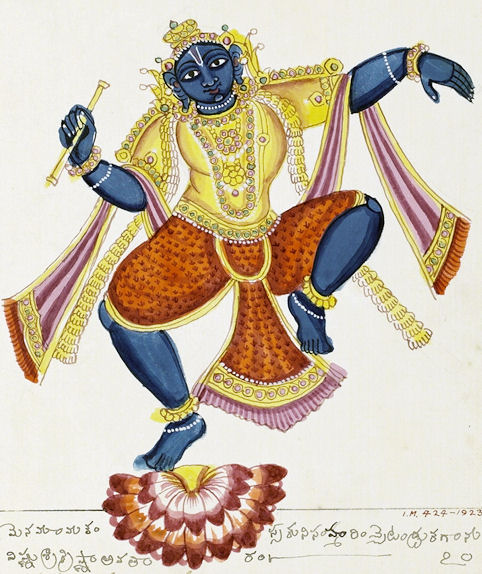
Abb.: Kṛṣṇa, Tiruchchirappalli (தி௫ச்சிராப்பள்ளி),
Tamil Nadu, ca. 1825
[Bildquelle: Wikipedia. -- Public domain]
"KṚṢṆA. 'Black'. This name occurs in the Ṛveda, but without any relation to the great deity of later times. The earliest mention of Kṛṣṇa, the son of Devakī, is in the Chāndogya-Upaniṣad, where he appears as a scholar. There was a Ṛṣi of the name who was a son of Viśvaka. There was also a great Asura so named, who with 10,000 followers committed fearful devastation, until he was defeated and skinned by Indra. In another Vedic hymn, 50,000 Kṛṣṇas are said to have been slain, and it is added in another that his pregnant wives were slain with him that he might leave no posterity. This is supposed to have reference to the Rākṣasas or to the dark-coloured aborigines of India. The modern deity Kṛṣṇa is the most celebrated hero of Indian mythology, and the most popular of all the deities. He is said to be the eighth Avatāra or incarnation of Viṣṇu, or rather a direct manifestation of Viṣṇu himself. This hero, around whom a vast mass of legend and fable has been gathered, probably lived in the Epic age, when the Hindus had not advanccd far beyond their early settlements in the north-west. He appears prominently in the Mahā-bhārata, where his character is invested with a certain degree of mysticism. Additions and interpolations have raised him to divinity, and it is in the character of the "Divine One" that he delivered the celebrated song, Bhagavad-gītā, a production of comparatively late date, now held to be part of the great epic. In this work he distinctly declares himself to be the Supreme Being. He says : "All this universe has been created by me ; all things exist in me;" and Arjuna addresses him as "the supreme universal spirit, the supreme dwelling, the eternal person, divine, prior to the gods, unborn, omnipresent." The divine character of Kṛṣṇa, having thus been established, it was still further developed in the Hari-vaṃśa, a later addition to the Mahā-bhārata ; and in the Purāṇas, especially in the Bhāgavata Purāṇa, it attained full expansion. There the story of the life of Kṛṣṇa, from his earliest days, is related with minute details, and it is upon this portion of his life that the popular mind delights to dwell. The mischievous pranks of the child, the follies of the boy, and the amours of the youth, are the subjects of boundless wonder and delight. All these stories, as told in the Bhāgavata Purāṇa, have been made accessible and popular by the Hindi translation known by the name Prem Sāgar, 'ocean of love', and by other versions. Much of the story of the early days of Kṛṣṇa is thus of comparatively modern invention, while the incidents of his relations with the Pāṇḍava princes are among the most ancient.
Kṛṣṇa was of the Yādava race, being descended from Yadu, one of the sons of Yāyati. The Yādavas of old were a pastoral race, and dwelt on the river Yamunā (Jumna), in Vṛndāvana, on the western side, and in Gokula on the other. In those days, Kaṃsa, Rāja of the Bhojas, having deposed his father, Ugrasena, ruled in the city of Mathurā, near Vṛndāvana. Ugrasena had a brother named Devaka, and Devaka had a daughter named Devakī, who married Vasu-deva, son of Śūra, also a descendant of Yadu. The history of Kṛṣṇa's birth, as given in the Mahā-bhārata and followed by the Viṣṇu Purāṇa, is that Viṣṇu plucked out two of his own hairs, one white, the other black. These two hairs entered the wombs of Rohinī and Devakī ; the white hair became Bala-rāma and the black (kṛṣṇa) hair (keśa) became Kṛṣṇa or Keśava. His reputed father, Vasu-deva, was brother of Kunti, the wife of Pāṇḍu, and so Kṛṣṇa was cousin of the three elder Pāṇḍava princes.
The Mahā-bhārata gives two summaries of his exploits, of which the following are abridgments :
"While Kṛṣṇa, was growing up as a high-souled boy in the tribe of cowherds, the force of his arms was rendered famous by him in the three worlds." He slew the king of the Hayas (horses), dwelling in the woods of the Yamunā. He slew the direful Dānava, who bore the form of a bull He also slew Pralambha, Naraka, Jambha, and Pītha, the great Asura, and Muru. He overthrew and slew Kaṃsa, who was supported by Jarā-sandha. With the help of Bala-rāma he defeated and destroyed Su-nāman, brother of Kaṃsa and king of the Śūrasenas. He carried off the daughter of the king of the Gandharas at a svayam-vara, and princes were yoked to his car. He secured the death of Jarā-sandha and slew Śiśupāla. He overthrew Saubha, the self-supporting or flying city of the Daityas, on the shore of the ocean. He conquered the Aṅgas and Baṅgas, and numerous other tribes. Entering the ocean filled with marine monsters, he overcame Varuṇa. In Pātāla he slew Pañcajana, and obtained the divine shell Pāñcajanya. With Arjuna he propitiated Agni in the Khāṇḍava forest, and obtained the fiery weapon the discus. Mounted on Garuḍa, he alarmed Amarāvatī, the city of Indra, and brought away the Pārijāta tree from thence.
In another passage, Arjuna rehearses some of Kṛṣṇa's exploits. He destroyed the Bhoja kings in battle, and carried off Rukmṇī for his bride. He destroyed the Gāndhāras, vanquished the sons of Nagnajit, and released King Su-darśana, whom they had bound. He slew Pāṇḍya with the fragment of a door, and crushed the Kaliṅgas in Dantakūra. Through him the burnt city of Benares was restored. He killed Ekalavya, king of the Niṣādas, and the demon Jambha. With the aid of Bala-rāma he killed Su-nāman, the wicked son of Ugrasena, and restored the kingdom to the latter. He conquered the flying city of Saubha and the king of the Śālvas, and there he obtained the fiery weapon Śata-ghnī. Naraka, son of the earth, had carried off the beautiful jewelled earrings of Aditi to Prāg-jyotiṣa, the impregnable castle of the Asuras. The gods, headed by Indra, were unable to prevail against Naraka, so they appointed Kṛṣṇa, to slay him. Accordingly he killed Muru and the Rākṣasa Ogha ; and finally he slew Naraka and brought back the earrings.
It further appears in different parts of the Mahā-bhārata that Kṛṣṇa, prince of Dvārakā, was present at the swayam-vara of Draupadī, and gave his judgment that she had been fairly won by Arjuna. While the Pāṇḍavas were reigning at Indra-prastha, he paid them a visit, and went out hunting with them in the Khāṇḍava forest. There he and Arjuna allied themselves with Agni, who was desirous of burning the Khāṇḍava forest, but was prevented by Indra. Agni having secured the help of Kṛṣṇa and Arjuna, he gave the former the celebrated cakra (discus) Vajra-nābha, and the club Kaumodakī. Then Indra was defeated and Agni burnt the forest, Arjuna afterwards visited Kṛṣṇa at Dvārakā, and was received with great demonstrations of joy. Arjuna, with the connivance of Kṛṣṇa, eloped with Su-bhadrā, Kṛṣṇa's sister, much to the annoyance of Bala-rāma, her elder brother. When Yudhiṣṭhira was desirous of performing the Rāja-sūya sacrifice, Kṛṣṇa told him that he must first conquer Jarā-sandha, king of Magadha. Jarā-sandha was attacked and slain, and Kṛṣṇa was thus revenged upon the enemy who had forced him to leave Mathurā and emigrate to Dvārakā. Kṛṣṇa attended the Rāja-sūya sacrifice performed by Yudhi-ṣṭhira, and there he met Śiśu-pāla, whose betrothed wife he had carried off. Śiśu-pāla reviled him and acted very violently, so Kṛṣṇa cast his discus and cut off his enemy s head. He was present at the gambling match between Yudhi-ṣṭhira and the Kauravas. When Draupadī had been staked and lost, she was dragged into the public hall by Duḥ-śāsana, who tore off her clothes, but Kṛṣṇa pitied her, and renewed her clothes as fast as they were torn away. After the close of the exile of the Pāṇḍavas, Kṛṣṇa, was present, and took part in the council which preceded the great war, and strongly advised a peaceful settlement. Then he returned to Dvārakā. Thither Arjuna and Dur-yodhana followed him with the object of enlisting his services in the coming war, but he refused to take any active part because he was related to both parties. He gave them the choice of his personal attendance or of the use of his army. Arjuna, who had arrived first, and therefore had the first choice, asked for Kṛṣṇa himself, and Dur-yodhana joyfully accepted the army. Kṛṣṇa then became the charioteer of Arjuna. After this, at the request of the Pāṇḍavas, he went in splendid state to Hastinā-pura as a mediator, but his efforts were unavailing, and he returned. Preparations for action were then made and the forces drawn out. On the eve of the battle, while acting as Arjuna s charioteer, he is represented as relating to Arjuna the Bhagavad-gītā or divine song. He rendered valuable services to Arjuna throughout the battle, but on two occasions he suggested unfair dealing. He prompted the lie by which Yudhi-ṣṭhira broke down the prowess of Droṇa, and he suggested the foul blow by which Bhīma shattered the thigh of Dur-yodhana. He afterwards went to Hastinā-pura with the conquerors, and he also attended their Aśva-medha sacrifice. On returning to Dvārakā he issued a proclamation forbidding the use of wine. Portents and fearful signs appeared, and a general feeling of alarm spread among all in Dvārakā. Kṛṣṇa gave directions that the inhabitants should go out to Prabhāsa on the sea-shore and endeavour to propitiate the deity. He gave permission also that wine might be drunk for one day. A drunken brawl followed, in which his son Pradyumna was killed in his presence, and nearly all the chiefs of the Yādavas were slain. Bala-rāma went out from the fray and died peacefully under a tree, and Kṛṣṇa himself was killed unintentionally by a hunter named Jaras, who shot him with an arrow, mistaking him at a distance for a deer. Arjuna proceeded to Dvārakā and performed the obsequies of Kṛṣṇa. A few days afterwards the city was swallowed up by the sea. Five of Kṛṣṇa's widows were subsequently burnt upon a funeral pile in the plain of Kuru-kṣetra.
"Among the texts of the Mahā-bhārata," says Dr. Muir, "there are some in which Kṛṣṇa is distinctly subordinated to Mahā-deva (Śiva), of whom he is exhibited as a worshipper, and from whom, as well as from his wife Umā, he is stated to have received a variety of boons. Even in these passages, however, a superhuman character is ascribed to Kṛṣṇa."
The popular history of Kṛṣṇa, especially of his childhood and youth, is given in the Purāṇas, and is the subject of many a story. The Bhāgavata Purāṇa is the great authority, and from that the following account is condensed :
The sage Nārada had foretold to Kaṃsa that a son of Devakī, his brother's daughter, should destroy him and overthrow his kingdom. To obviate this danger, Kaṃsa kept his cousin Devakī confined in his own palace, and six children that she bore he caused to be put to death. She conceived a seventh time, but the child was an incarnation of Viṣṇu, and was miraculously preserved by being transferred from the womb of Devakī to that of Rohiṇī, who was Vasu-deva's second wife. This child was Bala-rāma. Devakī again conceived, and her eighth child was born at midnight with a very dark skin, whence he was called Kṛṣṇa. He had a peculiar curl of hair, called śrī-vatsa, upon his breast. The gods interposed to preserve the life of this divinely begotten child. The guards of the palace were overpowered with sleep, and bolts and barriers were removed. Vasudeva took up the child and escaped with him from Mathurā. He repaired to the bank of the Yamunā (Jumna), and, crossing the river, went to the house of Nanda, a cowherd, whose wife, Yaśodā, had on that very night been delivered of a female child. Vasu-deva secretly changed the infants, and carried back the daughter of Yaśodā to his wife Devakī. Kaṃsa discovered that he had been cheated, and in his wrath he ordered that every male infant that gave signs of vigour should be put to death.
Vasu-deva and Devakī, being no longer dangerous, were set at liberty. Nanda, alarmed by the order for the massacre, took the young child and removed with Yaśodā and with Rohiṇī and Bala-rāma to Gokula. Here Krishfia was brought up, and wandered about in company of his elder brother Bala-rāma. They played many pranks and passed many practical jokes ; but they exhibited such marvellous strength and such godlike powers that they soon became famous. Kaṃsa was continually forming schemes for the death of Kṛṣṇa. The female demon Pūtanā assumed a lovely form, and tried to kill him by suckling him, but the child sucked away her life. Another demon tried to drive a cart over him, but he dashed the cart to pieces. A demon named Triṇāvartta took the form of a whirlwind and flew off with him, but the child brought the demon to the ground with such violence that he died. One day Kṛṣṇa broke the vessels of milk and curds and ate the butter, which made Yaśodā angry. She fastened a rope round his body, and tied him to a large bowl, but he dragged the bowl away till it caught between two trees and uprooted them. From this feat he got the name of Dāmodara (rope-belly). He had a terrible conflict with the great serpent Kāliya, who lived in the Yamuna, and he compelled him to go away. On one occasion, when the gopīs or milkmaids were bathing, he took away all their clothes and climbed up a tree, and there he remained till the damsels came to him naked to recover them. He persuaded Nanda and the cowherds to give up the worship of Indra, and to worship the mountain Govardhana, which sheltered them and their cattle. Incensed at the loss of his offerings, Indra poured down a heavy rain, which would have deluged them, but Kṛṣṇa, lifted up the mountain Govardhana, and held it upon his finger as a shelter for seven days and nights, till Indra felt that he was foiled. From this feat he obtained the name of Govardhana-dhara and Tuṅgīśa. As he had protected the kine, Indra expressed his satisfaction, and gave him the title of Upendra. He was now approaching manhood, and was very handsome. The gopīs were all enamoured of him, and he dispensed his favours very freely. He married seven or eight of them, but his first and favourite wife was Rādhā. At this period of his life he is represented with flowing hair and with a flute in his hand. One of his favourite pastimes was a round dance, called Maṇḍala-nṛtya or Rāsa-maṇḍala, in which he and Rādhā formed the centre whilst the gopīs danced round them. But his happiness was interrupted by the machinations of Kaṃsa, who sent formidable demons to destroy him - Ariṣṭha in the form of a bull, and Keśin in the form of a horse. These attempts having failed, Kaṃsa sent his messenger, Akrūra, to invite Kṛṣṇa and Balarāma to Mathurā to attend some games, and he formed several plans for their destruction. They accepted the invitation, and went to Mathurā. Near the city they found Kaṃsa's washerman engaged in his calling. They threw down some of his clothes, and he addressed them insolently, upon which they killed him, and took such clothes as they liked. In his progress he met Kubjā, a crooked damsel, who gave him some unguent, and he repaid her gift by making her straight. In the games he killed Cāṇūra, the king s boxer. Afterwards he killed Kaṃsa himself, and replaced Ugrasena on the throne. He remained in Mathurā and studied the science of arms under Sāndīpani. He went down to the infernal regions and brought back his six brothers, whom Kaṃsa had killed, and these, having tasted the milk of their mother, ascended to heaven. During this period he killed a demon named Pañcajana, who had attacked the son of his teacher. This demon lived in the sea in the form of a conch-shell, and Kṛṣṇa afterwards used this shell, called Pāñcajanya, as a trumpet. Kaṃsa s two wives were daughters of Jarā-sandha, king of Magadha. This king assembled his forces and marched against Mathurā to chastise Kṛṣṇa, but he was defeated. He renewed his attacks eighteen times, and was as often defeated. A new enemy then threatened Kṛṣṇa, a Yavana or foreigner named Kāla-yavana, and Kṛṣṇa had been so weakened that he knew he must succumb either to him or to his old enemy the king of Magadha, so he and all his people migrated to the coast of Guzerat, where he built and fortified the city of Dvārakā. (The Mahā-bhārata makes no mention of this foreign king, and says that Kṛṣṇa retired before the eighteenth attack of Jarā-sandha. The foreign king would, therefore, seem to be an invention of the Purāṇas for saving Kṛṣṇa's reputation.]
After his settlement at Dvārakā, Kṛṣṇa carried off and married Rukmiṇī, daughter of the Rāja of Vidarbha, and the betrothed of Śiśu-pāla. An incident now occurred which brought him two more wives. A Yadava chief named Satrājit had a beautiful gem called Syamantaka, which Kṛṣṇa wished to possess. Satrājit, for the sake of security, gave the gem into the charge of his brother Prasena, and Prasena was killed in the forest by a lion, who carried off the jewel in his mouth. This lion was killed by Jāmbavat, the king of the bears. Satrājit suspected Kṛṣṇa, of taking the jewel, and he, to clear himself, went out into the forest, ascertained the manner of Prasena's death, fought with Jāmbavat, and recovered the jewel. Kṛṣṇa then married Jāmbavatī, the daughter of Jāmbavat, and Satyabhāmā, the daughter of Satrājit. But the number of his wives was practically unlimited, for he had 16,000 and a hundred or so besides, and he had 180,000 sons. By Rukmiṇī he had a son Pradyumna and a daughter Cārumatī. His son by Jāmbavatī was Śāmba, and by Satya-bhāmā he had ten sons. Indra came to visit Kṛṣṇa at Dvārakā, and implored him to suppress the evil deeds of the demon Naraka. Kṛṣṇa accordingly went to the city of Naraka, killed the demon Muru, who guarded the city, and then destroyed Naraka himself. Kṛṣṇa next went to pay a visit to Indra in Svarga, taking with him his wife Satya-bhāmā. At her request lie requited the hospitality shown him by carrying off the famed Pārijāta tree, which was produced at the churning of the ocean. The tree belonged to Śacī, wife of Indra, and she complained to her husband. India drew out his forces and tried to recover it, but was defeated by Kṛṣṇa. Pradyumna, son of Kṛṣṇa, had a son named Aniruddha, with whom a female Daitya, Uṣā, daughter of Bāṇa, fell in love. She induced a companion to carry off the young man, and Kṛṣṇa, Bala-rāma, and Pradyumna went to rescue him. Bāṇa, with the whole Daitya host, and assisted by Śiva and Skanda, the god of war, encountered them. Kṛṣṇa, "with the weapon of yawning, set Śiva agape," and so overpowered him. Skanda was wounded. Bāṇa maintained a fierce combat with Kṛṣṇa, and was severely wounded, but Kṛṣṇa spared his life at the intercession of Śiva, and Aniruddha was released.
There was a man named Pauṇḍraka, who was a Vāsu-deva, or descendant of one Vasu-deva. Upon the strength of the identity of this name with that of Vasu-deva, the father of Kṛṣṇa, this man Pauṇḍraka assumed the insignia and title of Kṛṣṇa, and he had the king of Kāśī or Benares for an ally. Kṛṣṇa slew Pauṇḍraka, and he hurled his naming discus at Benares and destroyed that city. Such are the principal incidents of the life of Kṛṣṇa as given in the Hari-vaṃśa, the Purāṇas, and the Prem Sāgar.
Similarity in the sound of the name, and some incidents in the life of Kṛṣṇa, have led some to believe that the legend of Kṛṣṇa had its origin in the life of Christ, but this is not the general opinion.
Kṛṣṇa has many appellations derived from his family relations, his exploits, and personal characteristics ; and there are many which apply both to the full deity, Viṣṇu, and his incarnation, Kṛṣṇa."
[Quelle: Dowson, John <1820-1881>: A classical dictionary of Hindu mythology and religion, geography, history, and literature. -- London, Trübner, 1879. -- s.v.]
4 Vaikuṇṭha - वैकुण्ठ m.: Vaikuṇṭha
"VAIKUṆṬHA. The paradise of Viṣṇu, sometimes described as on Mount Meru, and at others as in the Northern Ocean. It is also called Vaibhra. Viṣṇu himself is sometimes designated by this term."
[Quelle: Dowson, John <1820-1881>: A classical dictionary of Hindu mythology and religion, geography, history, and literature. -- London, Trübner, 1879. -- s.v.]
5 Dāmodara - दामोदर् m.: Um den Bauch ein Band habend
"DĀMODARA. A name given to Kṛṣṇa because his fostermother tried to tie him up with a rope (dāma) round his belly (udara)." [Quelle: Dowson, John <1820-1881>: A classical dictionary of Hindu mythology and religion, geography, history, and literature. -- London, Trübner, 1879. -- s.v.]
6 Mādhava - माधव m.: Gatte der Mutter (Lakṣmī)
Jātarūpa: "Mā (Mutter) ist Lakṣmī. Deren Gatte (dhava) ist Mā-dhava." (मा लक्ष्मीः । तस्य धवो माधवः)
7 Daityāri - दैत्यारि m.: Feind der Daitya
Daitya: siehe oben zu Vers 11.
8 Puṇḍarīkākṣa - पुण्डरीकाक्ष m.: Lotusäugiger
puṇḍarīka: Nelumbo nucifera Gaertn. = Indische Lotosblume
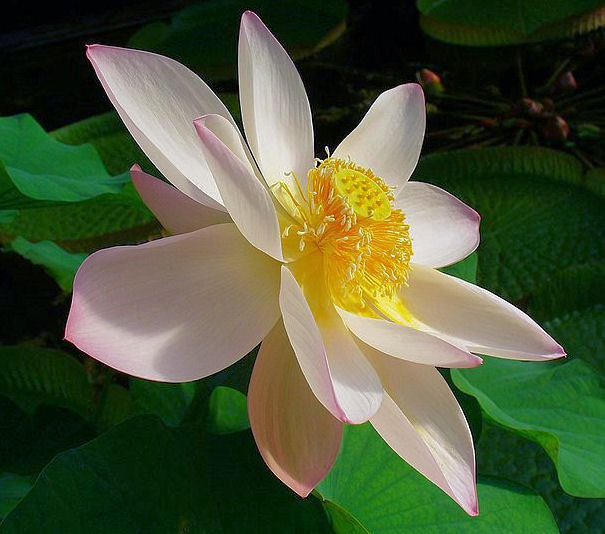
Abb.: Nelumbo nucifera Gaertn. = Indische Lotosblume
[Bildquelle: H. Zell / Wikipedia. --
Creative Commons
Lizenz (Namensnennung, share alike)]
9 Govinda - गोविन्द m.: Kuhfinder, Rinderfinder
Jātarūpa: "Er findet = der Finder. ... Kuhfinder (go-vinda) = Finder von Kühen oder Finder einer Kuh." (विन्दतीति विन्दः । ... । गवां विन्दो गोर्वा विन्दो गोविन्दः)
10 Janārdana - जनार्दन m.: Wesenbedränger
Jātarūpa: "Wesenbedränger, weil er zur Zeit des Weltuntergangs [die Wesen] in sich aufnimmt. Wesen = rākṣasa, dessen Bedränger ist der Wesenbedränger, so erklären einige." (प्रलयकाले जनानां संहारक्त्वज् जनार्दनः । जनो राक्षसस् तस्यार्दनो जनार्दन इतिकेचित्)
11 Cakrapāṇī - चक्रपाणि m.: der in der Hand einen Diskus (Wurfscheibe) hat
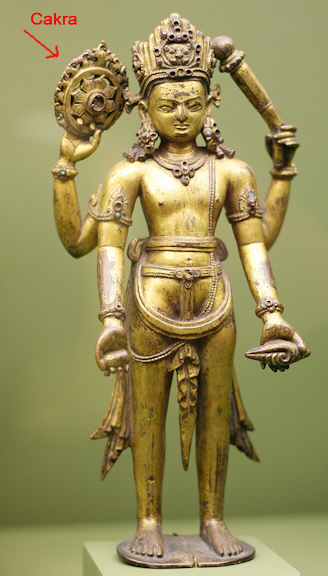
Abb.: Viṣṇu, 10. Jhdt. n. Chr.
[Bildquelle: katie chao and ben muessig / Wikimedia. --
Creative Commons
Lizenz (Namensnennung, share alike)]
12 Padmanābha - पद्मनाभ m.: Lotusnabliger
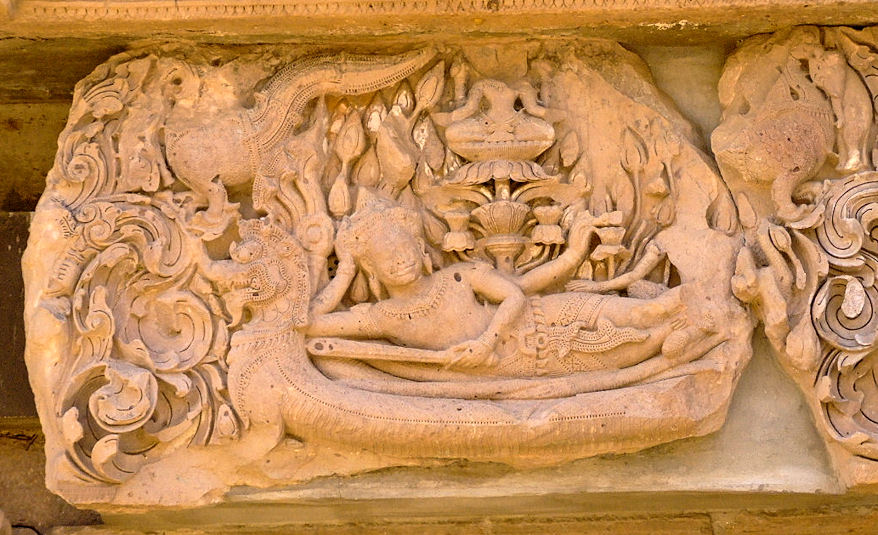
Abb.: Viṣṇu padmanābha, Prasat Phanom Rung (ปราสาทหินเขาพนมรุ้ง),
Thailand, 10./12. Jhdt. n. Chr.
[Bildquelle: Thanyakij / Wikipedia. -- Public domain]
13 Madhuripu - मधुरिपु m.: Feind Madhu's, Kaiṭabhajit - कैटभजित् m.: Besieger des Kaiṭabha
"KAIṬABHA. Kaiṭabha and Madhu were two horrible demons, who, according to the Mahā-bhārata and the Purāṇas, sprang from the ear of Viṣṇu while he was asleep at the end of a kalpa, and were about to kill Brahmā, who was lying on the lotus springing from Viṣṇu s navel. Viṣṇu killed them, and hence he obtained the names of Kaiṭabha-jit and Madhu-sūdana. The Mārkaṇḍeya Purāṇia attributes the death of Kaiṭabha to Umā, and she bears the title of Kaiṭabhā. The Hari-vaṃśa states that the earth received its name of Medinī from the marrow (medas) of these demons. In one passage it says that their bodies, being thrown into the sea, produced an immense quantity of marrow or fat, which Nārāṇawa used in forming the earth. In another place it says that the medas quite covered the earth, and so gave it the name of Medinī. This is another of the many etymological inventions."
[Quelle: Dowson, John <1820-1881>: A classical dictionary of Hindu mythology and religion, geography, history, and literature. -- London, Trübner, 1879. -- s.v.]
14 Vāsudeva - वासुदेव m.: Sohn Vasudevas
ZU Vasudeva s. unten zu Vers 13c./d.
15 Trivikrama - त्रिविक्रम m.: der, welcher drei erobernde Schritte tut/tat
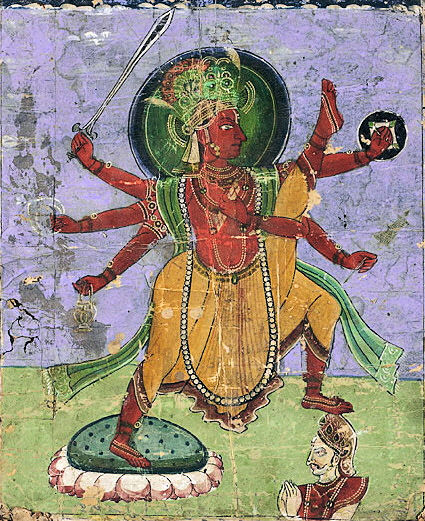
Abb.: Viṣṇu als Vāmana trivikrama, Nepal, 19. Jhdt. n. Chr.
[Bildquelle: Wikipedia. -- Public domain]
"TRI-VIKRAMA. A name of Viṣṇu used in the Ṛg-veda, and referring to three steps or paces which he is represented as taking. These steps, according to the opinion of a commentator, are "the three periods of the sun's course, his rising, culminating, and setting." An old commentator says, "Viṣṇu stepped by separate strides over the whole universe. In three places he planted his step, one step on the earth, a second in the atmosphere, and a third in the sky, in the successive forms of Agni, Vāyu, and Sūrya." The great commentator Sāyaṇa, a comparatively modern writer, understands these steps as being the three steps of Viṣṇu in the Vāmana or dwarf incarnation, and no doubt they were the origin of this fiction." [Quelle: Dowson, John <1820-1881>: A classical dictionary of Hindu mythology and religion, geography, history, and literature. -- London, Trübner, 1879. -- s.v.]
16 Devakīnandana - देवकीनन्दन m.: Wonne Devakī's
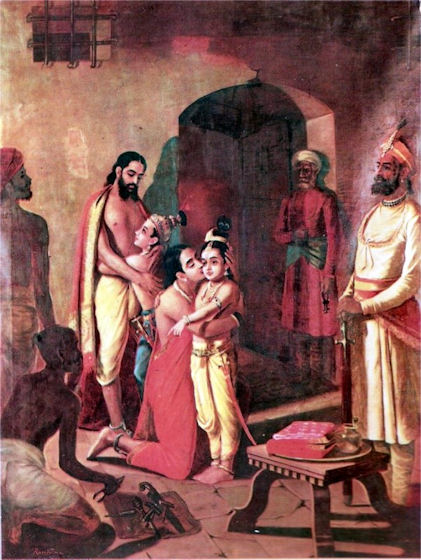
Abb.: Raja Ravi Varma (രാജാ രവി വര്മ)
<1848 - 1906>: Kṛṣṇa und Balarāma mit ihren Eltern Vasudeva und Devakī
[Bildquelle: Wikipedia. -- Public domain]
"DEVAKĪ.Wife of Vasu-deva, mother of Kṛṣṇa, and cousin of Kaṃsa. She is sometimes called an incarnation of Aditi, and is said to have been born again as Pṛṣṇī, the wife of King Su-tapas."
[Quelle: Dowson, John <1820-1881>: A classical dictionary of Hindu mythology and religion, geography, history, and literature. -- London, Trübner, 1879. -- s.v.]
17 Śauri - शौरि m.: Nachfahre Śūra's
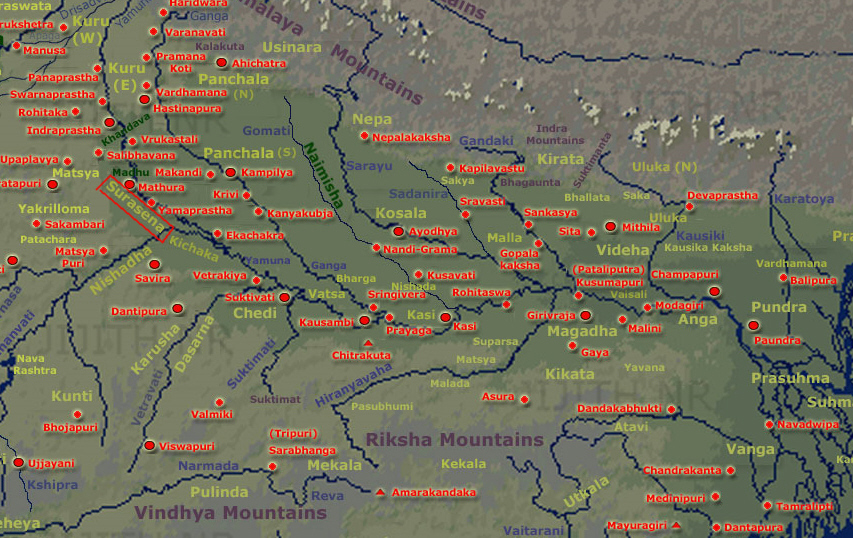
Abb.: Lage von Śūrasena
[Bildquelle: JIJITH NR / Wikipedia. --
Creative Commons
Lizenz (Namensnennung, share alike)]
"ŚŪRA. A Yādava king who ruled over the Śūrasenas at Mathurā ; he was father of Vasu-deva and Kuntī, and grand-father of Kṛṣṇa."
[Quelle: Dowson, John <1820-1881>: A classical dictionary of Hindu mythology and religion, geography, history, and literature. -- London, Trübner, 1879. -- s.v.]
18 Puruṣottama - पुरुशोत्तम m.: Höchste Person
Jātarūpa: "Puruṣas sind die Seelen (ātman); deren höchster, weil er als Gestalt die höchste Seele (paramātman) hat. Deshalb 'höchste der Seelen" (पुरुषा आत्मानः । तेषामुत्तमः परमात्मरूपत्वादिति पुरुषोत्तमः)
19 Balidhvaṃsin - बलिध्वंसिन् m.: Vernichter des Bali
"BALI. A good and virtuous Daitya king. He was son of Virocana, son of Prahlāda, son of Hiraṇya-kaśipu. His wife was Vindhyāvalī. Through his devotion and penance he defeated Indra, humbled the gods, and extended his authority over the three worlds. The gods appealed to Viṣṇu for protection, and he became manifest in his Dwarf Avatāra for the purpose of restraining Bali. This dwarf craved from Bali the boon of three steps of ground, and, having obtained it, he stepped over heaven and earth in two strides ; but then, out of respect to Bali s kindness and his grandson Prahlāda's virtues, he stopped short, and left to him Pātāla, the infernal regions. Bali is also called Mahā-bali, and his capital was Mahā-bali-pura. The germ of the legend of the three steps is found in the Ṛg-veda, where Viṣṇu is represented as taking three steps over earth, heaven, and the lower regions, typifying perhaps the rising, culmination, and setting of the sun."
[Quelle: Dowson, John <1820-1881>: A classical dictionary of Hindu mythology and religion, geography, history, and literature. -- London, Trübner, 1879. -- s.v.]
20 Kaṃsārāti - कंसाराति् m.: Feind des Kaṃsa
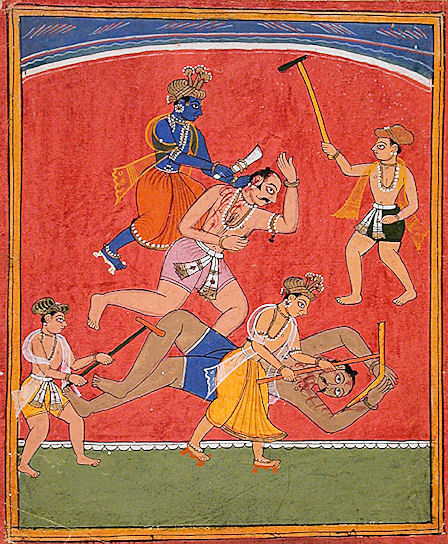
Abb.: Kṛṣṇa tötet Kaṃsa, Mewar, ca. 1630
[Bildquelle: Wikipdia. -- Public domain]
"KAṂSA. A tyrannical king of Mathurā, son of Ugra-sena and cousin of Devakī the mother of Kṛṣṇa ; so he was the cousin, not the uncle, of Kṛṣṇa, as he is often called. He married two daughters of Jarā-sandha, king of Magadha. He deposed his father. It was foretold that a son born of Devakī should kill him, so he endeavoured to destroy all her children. But Bala-rāma, her seventh son, was smuggled away to Gokula, and was brought up by Rohiṇī. When Kṛṣṇa the eighth was born his parents fled with him. The tyrant then gave orders for a general massacre of all vigorous male infants. Kaṃsa became the great persecutor of Kṛṣṇa, but was eventually killed by him. Kaṃsa is also called Kalāṅkura, 'crane'. He is looked upon as an Asura, and is in some way identified with the Asura Kāla-nemi."
[Quelle: Dowson, John <1820-1881>: A classical dictionary of Hindu mythology and religion, geography, history, and literature. -- London, Trübner, 1879. -- s.v.]
21 Śrīvatsalāñchana - श्रीवत्सलाञ्छन m.: der Śrīvatsa als Zeichen hat
"ŚRĪ-VATSA. A particular mark, said to be a curl of hair on the breast of Viṣṇu or Kṛṣṇa, and represented by
."
[Quelle: Dowson, John <1820-1881>: A classical dictionary of Hindu mythology and religion, geography, history, and literature. -- London, Trübner, 1879. -- s.v.]
22 Narakāntaka - नरकान्तक m.: Vernichter des Naraka
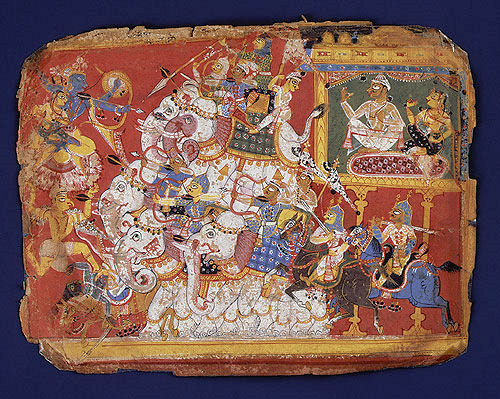
Abb.: Kṛṣṇa bekämpft Narakas Armee, ca. 1520/30
[Bildquelle: Wikipedia. -- Public domain]
"NARAKA. An Asura, son of the Earth. In the Mahābhārata and Viṣṇu Purāṇa he is said to have carried off the ear-rings of Aditi to the impregnable castle of Prāg-jyotiṣa, but Kṛṣṇa, at the request of the gods, went there and killed him and recovered the jewels.
In the Hari-vaṃśa the legend differs. According to this, Naraka, king of Prāg-jyotiṣa, was an implacable enemy of the gods. He assumed the form of an elephant, and having carried off the daughter of Viśva-karma, he subjected her to violation. He seized the daughters of the Gandharvas, and of gods and of men, as well as the Apsarasas themselves, and had more than 16,000 women, for whom he built a splendid residence. He also appropriated to himself jewels, garments, and valuables of all sorts, and no Asura before him had ever been so horrible in his actions."
[Quelle: Dowson, John <1820-1881>: A classical dictionary of Hindu mythology and religion, geography, history, and literature. -- London, Trübner, 1879. -- s.v.]
23 Jalaśāyin - जलशायिन् m.: auf dem Wasser (Ozean) Liegender
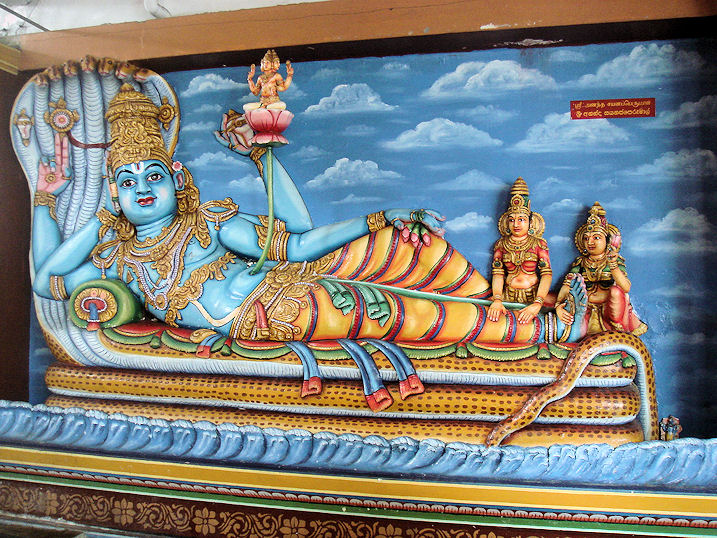
Abb.: Viṣṇu auf Śeṣa auf dem Weltozean liegend, Munneswaram Temple,
முன்னேசுவரம் கோயில்)
, Sri Lanka
[Bildquelle: spaceppl. --
http://www.flickr.com/photos/37706524@N00/2968137740. -- Zugriff am
2010-06-30. --
Creative Commons Lizenz (Namensnennung, share alike) ]
24 Viśvarūpa - विश्वरूप m.: Allgestaltiger
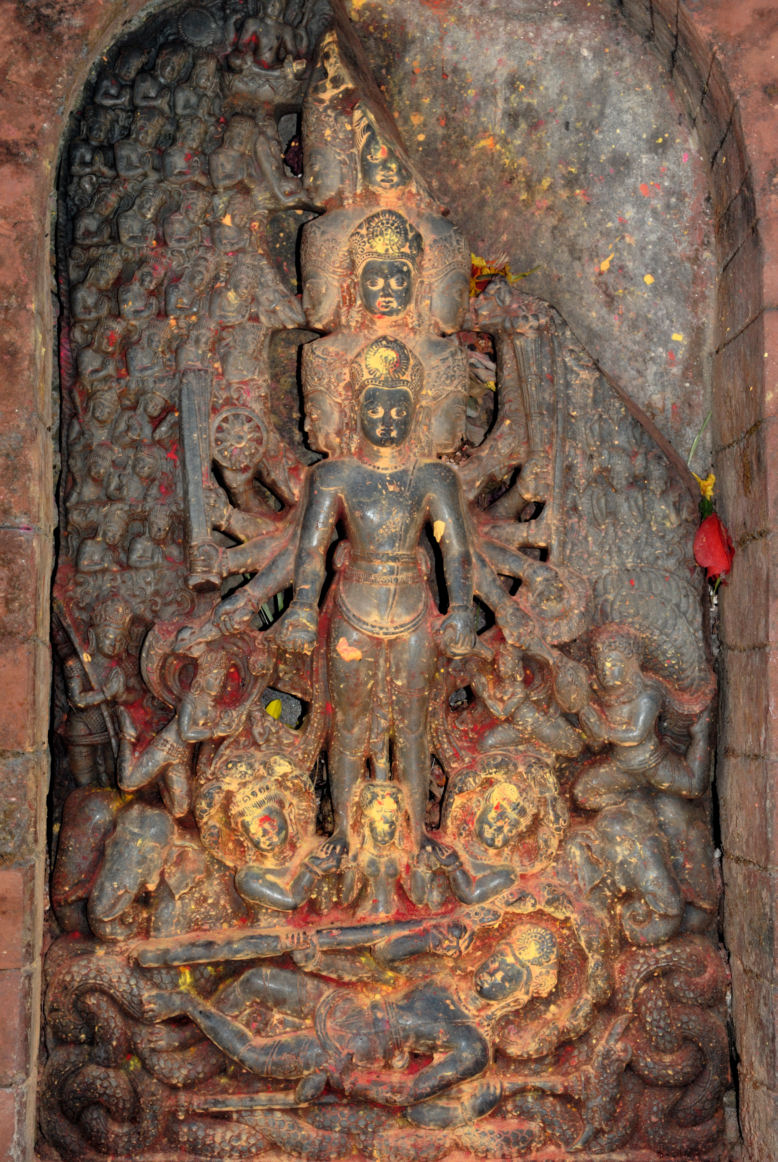
Abb.: Viṣṇu viśvarūpa, Changu Narayan (चांगुनारायन), Nepal, 9. Jhdt. n. Chr.
[Bildquelle: Hans Stieglitz / Wikipedia. --
Creative Commons
Lizenz (Namensnennung, share alike)]
25 Muramardana - मुरमर्दन m.: Zermalmer Muras
"MURA, MURU. A great demon who had seven thousand sons. He was an ally of the demon Naraka, who ruled over Prāg-jyotiṣa, and assisted him in the defence of that city against Kṛṣṇa. He placed in the environs of the city "nooses the edges of which were as sharp as razors," but Kṛṣṇa cut them to pieces with his discus, slew Muru, "and burnt his seven thousand sons like moths with the flame of the edge of his discus."" [Quelle: Dowson, John <1820-1881>: A classical dictionary of Hindu mythology and religion, geography, history, and literature. -- London, Trübner, 1879. -- s.v.]
Siehe auch:
Amarasiṃha <6./8. Jhdt. n. Chr.>: Nāmaliṅgānuśāsana (Amarakośa) / übersetzt von Alois Payer <1944 - >. -- 1. Prathamam kāṇḍam. -- 1. svargavargaḥ. -- Anhang 3: Jogendra Nath Bhattacharya [যোগেন্দ্রনাথ ভট্টাচার্য্য] über Vaiṣṇavas (1896). -- URL: http://www.payer.de/amarakosa/amara101Anhang3.htm
Amarasiṃha <6./8. Jhdt. n. Chr.>: Nāmaliṅgānuśāsana (Amarakośa) / übersetzt von Alois Payer <1944 - >. -- 1. Prathamam kāṇḍam. -- 1. svargavargaḥ. -- Anhang 3: Jogendra Nath Bhattacharya [যোগেন্দ্রনাথ ভট্টাচার্য্য] über "Semi-Vishuvite and Guru-worshipping sects" (1896). -- URL: http://www.payer.de/amarakosa/amara101Anhang4.htm
13c./d. vasudevo 'sya janakaḥ sa evānakadundubhiḥ
वसुदेवो ऽस्य जनकः स एवानकदुन्दुभिः ॥२३ख्॥
Vasudeva1 ist sein [Kṛṣṇas] Vater, er heißt auch Ānakadundubhi2 (Ānaka-Trommel)
Erläuterungen:
1 Vasudeva - वसुदेव m.: Vasudeva
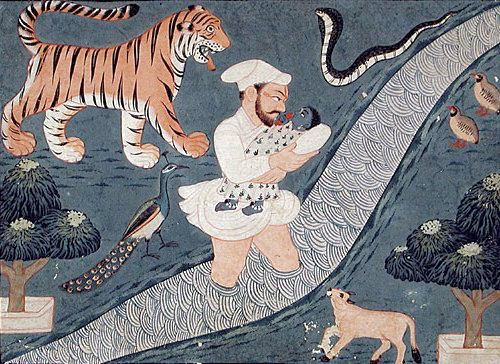
Abb.: Vasudeva trägt Kṛṣṇa nach seiner Geburt über den Fluss Yamunā, Mandi,
Himachal Pradesh, 18. Jhdt. n. Chr.
[Bildquelle: Wikipedia. -- Public domain]
"VASU-DEVA. Son of Śura, of the Yādava branch of the Lunar race. He was father of Kṛṣṇa, and Kuntī, the mother of the Pāṇḍava princes, was his sister. He married seven daughters of Āhuka, and the youngest of them, Devakī, was the mother of Kṛṣṇa. After the death of Kṛṣṇa and Balarāma lie also died, and four of his wives "burnt themselves with his corpse." So says the Mahā-bhārata, hut according to the Viṣṇu Purāṇa he and Devakī and Rohiṇī burnt themselves at Dvārakā. He received the additional name of Ānaka-dundubhi, because the gods, conscious that he was to be the putative father of the divine Kṛṣṇa, sounded the drums of heaven at his birth. He was also called Bhū-kaśyapa and Dundu, 'drum'." [Quelle: Dowson, John <1820-1881>: A classical dictionary of Hindu mythology and religion, geography, history, and literature. -- London, Trübner, 1879. -- s.v.]
2 Ānakadundubhi - आनकदुन्दुभि m.: Ānaka-Trommel
ānaka m.: "Bezeichnung verschiedener Arten von Trommeln, = paṭaha [...], = bherī [...], = mṛdaṅga [...]" (Petersburger Wörterbuch s. v.)
dundubhi m.: "Pauke, Trommel" (Petersburger Wörterbuch s. v.)
"ĀNAKA-DUNDUBHI. 'Drums'. A name of Vasu-deva, who was so called because the drums of heaven resounded at his birth." [Quelle: Dowson, John <1820-1881>: A classical dictionary of Hindu mythology and religion, geography, history, and literature. -- London, Trübner, 1879. -- s.v.]
24. balabhadraḥ pralambaghno baladevo 'cyutāgrajaḥ
revatīramaṇo rāmaḥ kāmapālo halāyudhaḥ
25. nīlāmbaro rauhiṇeyas tālāṅko musalī halī
saṃkarṣaṇaḥ sīrapāṇiḥ kālindībhedano balaḥ
बलभद्रः प्रलम्बघ्नो बलदेवो
ऽच्युताग्रजः
।
रेवतीरमणो रामः कामपालो हलायुधः ॥२४॥
नीलाम्बरो रौहिणेयस् तालाङ्को मुसली हली
संकर्षणः सीरपाणिः कालिन्दीभेदनो बलः ॥२५॥
[Bezeichnungen für Balarāma1 sind:]
Erläuterungen:
1 Balarāma - बलराम m.: Balarāma ("der starke Rāma")
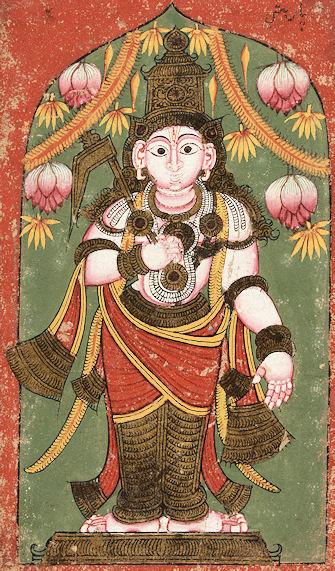
Abb.: Balarāma, 17. Jhdt. n. Chr.
[Bildquelle: Wikipedia. -- Public domain]
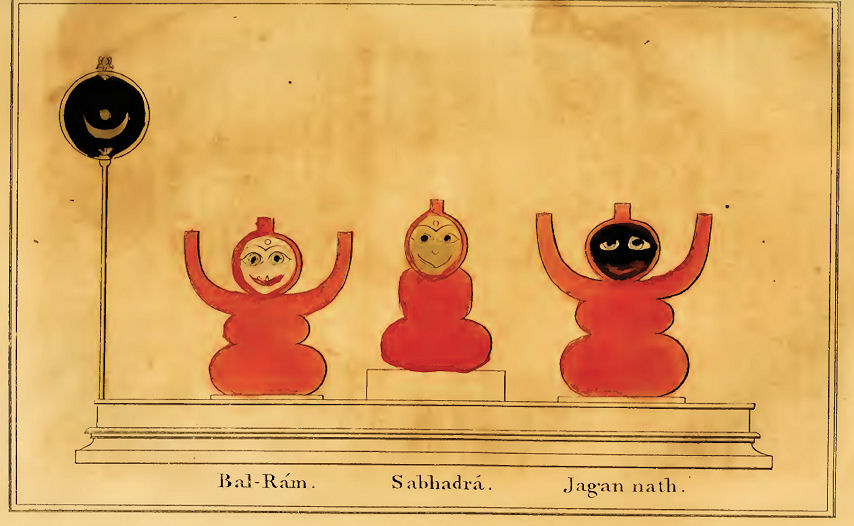
Abb.: Balarāma und Genossen
[Bildquelle: Asiatick Researches 8 (1808). -- Nach S. 62]
"BALA-RĀMA. (Bala-bhadra and Bala-deva are other forms of this name.) The elder brother of Kṛṣṇa. When Kṛṣṇa is regarded as a full manifestation of Viṣṇu, Bala-rāma is recognised as the seventh Avatāra or incarnation in his place. According to this view, which is the favourite one of the Vaiṣṇavas, Kṛṣṇa is a full divinity and Bala-rāma an incarnation ; but the story of their birth, as told in the Mahā-bhārata, places them more upon an equality. It says that Viṣṇu took two hairs, a white and a black one, and that these became Bala-rāma and Kṛṣṇa, the children of Devakī. Bala-rāma was of fair complexion, Kṛṣṇa was very dark. As soon as Bala-rāma was born, he was carried away to Gokula to preserve his life from the tyrant Kaṃsa, and he was there nurtured by Nanda as a child of Rohiṇī. He and Kṛṣṇa grew up together, and he took part in many of Kṛṣṇa's boyish freaks and adventures. His earliest exploit was the killing of the great Asura Dhenuka, who had the form of an ass. This demon attacked him, but Bala-rāma seized his assailant, whirled him round by his legs till he was dead, and cast his carcase into a tree. Another Asura attempted to carry off Bala-rāma on his shoulders, but the boy beat out the demon's brains with his fists. When Kṛṣṇa went to Mathurā, Bala-rāma accompanied him, and manfully supported him till Kaṃsa was killed. Once, when Bala-rāma was intoxicated, he called upon the Yamunā river to come to him, that he might bathe ; but his command not being heeded, he plunged his ploughshare into the river, and dragged the waters whithersoever he went, until they were obliged to assume a human form and beseech his forgiveness. This action gained for him the title Yamunā-bhid and Kālindī-karṣaṇa, breaker or dragger of the Yamunā. He killed Rukmin in a gambling brawl. When Śāmba, son of Kṛṣṇa, was detained as a prisoner at Hastināpur by Dur-yodhana, Bala-rāma demanded his release, and, being refused, he thrust his ploughshare under the ramparts of the city, and drew them towards him, thus compelling the Kauravas to give up their prisoner. Lastly, he killed the great ape Dvivida, who had stolen his weapons and derided him.
Such are some of the chief incidents of the life of Bala-rāma, as related in the Purāṇas, and as popular among the votaries of Kṛṣṇa. In the Mahā-bhārata he has more of a human character, he taught both Dur-yodhana and Bhīma the use of the mace. Though inclining to the side of the Pāṇḍavas, he refused to take an active part either with them or the Kauravas. He witnessed the combat between Dur-yodhana and Bhīma, and beheld the foul blow struck by the latter, which made him so indignant that he seized his weapons, and was with difficulty restrained by Kṛṣṇa from falling upon the Pāṇḍavas. He died just before Kṛṣṇa, as he sat under a banyan tree in the outskirts of Dvārakā.
Another view is held as to the origin of Bala-rāma. According to this he was an incarnation of the great serpent Śeṣa, and when he died the serpent is said to have issued from his mouth. The "wine-loving"; Bala-rāma (Madhu-priya or Priya-madhu) was as much addicted to wine as his brother Kṛṣṇa was devoted to the fair sex. He was also irascible in temper, and sometimes quarrelled even with Kṛṣṇa : the Purāṇas represent them as having a serious difference about the Syamantaka jewel He had but one wife, Revatī, daughter of King Raivata, and was faithful to her. By her he had two sons, Niśaṭha and Ulmuka. He is represented as of fair complexion, and, as Nīla-vastra, 'clad in a dark-blue vest'. His especial weapons are a club (khetaka or saunanda), the ploughshare (hala), and the pestle (musala), from which he is called Phāla and Hāla, also Halāyudha, 'plough-armed'; Hala-bhṛt, 'plough-bearer' ; Lāṅgali and Saṃkarṣaṇa, 'ploughman'; and Musalī, 'pestle-holder'. As he has a palm for a banner, he is called Tāla-dhvaja. Other of his appellations are Gupta-cara, 'who goes secretly'; Kāma-pāla and Saṃvartaka."
[Quelle: Dowson, John <1820-1881>: A classical dictionary of Hindu mythology and religion, geography, history, and literature. -- London, Trübner, 1879. -- s.v.]
2 Pralambaghna - प्रलम्बघ्न m.: Töter des Pralamba
"PRALAMBA. An Asura killed by Kṛṣṇa, according to the Mahā-bhārata. His story as told in the Viṣṇu Purāṇa is, that he was an Asura and a dependant of Kaṃsa. With the object of devouring the boys Kṛṣṇa and Bala-rāma, he joined them and their playmates in jumping. Pralamba was beaten by his opponent Bala-rāma, and by the rules of the game had to carry the victor back on his shoulders to the starting-place. He took up Bala-rāma and then expanded his form, and was making off with his rider when Bala-rāma called upon Kṛṣṇa for assistance. Kṛṣṇa made a long speech, and ended by telling him to suspend awhile his mortal character and do what was right. Bala-rāma laughed, squeezed Pralamba with his knees, and beat him on the head with his fists till his eyes were knocked out and his brain forced through his skull, so that he fell to the ground and expired."
[Quelle: Dowson, John <1820-1881>: A classical dictionary of Hindu mythology and religion, geography, history, and literature. -- London, Trübner, 1879. -- s.v.]
3 Revatīramaṇa - रेवतीरमण m.: Gatte der Revatī
"REVATĪ. Daughter of King Raivata and wife of Bala-rāma. She was so beautiful that her father, thinking no one upon earth worthy of her, repaired to the god Brahmā to consult him about a husband. Brahmā delivered a long discourse on the glories of Viṣṇu, and directed Raivata to proceed to Dvārakā, where a portion of Viṣṇu was incarnate in the person of Bala-rāma. Ages had elapsed while Raivata was in heaven without his knowledge. When he returned to earth, "he found the race of men dwindled in stature, reduced in vigour, and enfeebled in intellect." He went to Bala-rāma and gave him Revatī, but that hero, "beholding the damsel of excessively lofty height, he shortened her with the end of his ploughshare, and she became his wife." She had two sons. Revatī is said to have taken part with her husband in his drinking, bouts." [Quelle: Dowson, John <1820-1881>: A classical dictionary of Hindu mythology and religion, geography, history, and literature. -- London, Trübner, 1879. -- s.v.]
4 Halāyudha - हलायुध m.: der einen Pflug als Waffe hat
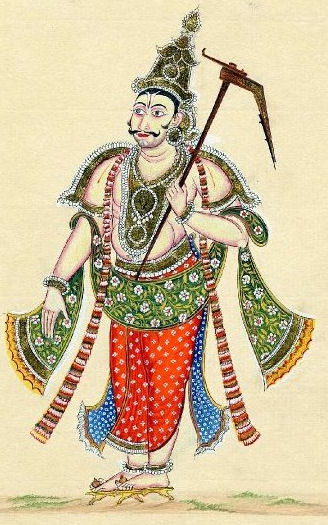
Abb.: Balarāma mit Pflug, ca. 1820
[Bildquelle: Wikipedia. -- Public domain]
5 Nīlāmbara - नीलाम्बर m.: dunkelblau Gekleideter
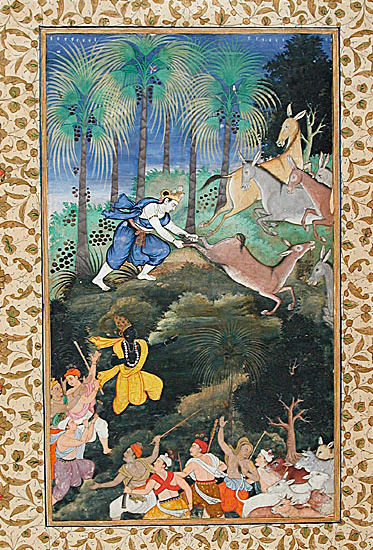
Abb.: Balarāma tötet den Asura Dhenuka, um 1590
[Bildquelle: Wikipedia. -- Public domain]
6 Rauhiṇeya - रौहिणेय m.: Sohn der Rohiṇī
"ROHIṆĪ. [...] 3. One of the wives of Vasu-deva, the father of Kṛṣṇa and mother of Bala-rāma. She was burned with her husband s corpse at Dvārakā."
[Quelle: Dowson, John <1820-1881>: A classical dictionary of Hindu mythology and religion, geography, history, and literature. -- London, Trübner, 1879. -- s.v.]
7 Tālāṅka - तालाङ्क m.: der die Palmyrapalme als Zeichen (Flagge) hat
tāla m.: Borassus flabellifer L. = Palmyrapalme
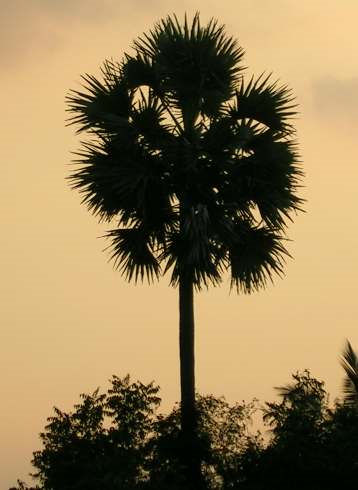
Abb.: tāla = Borassus flabellifer L. = Palmyrapalme, Palni Hills (பழனி
மலை), Tamil Nadu
[Bildquelle: L. Shyamal / Wikipedia. -- GNU FDLicense]
8 Kālindībhedana - कालिन्दीभेदन m.: Spalter der Kālindī (Yamunā)
Kālindī f. = Tochter des Kalinda (= Sonne) = Yamunā
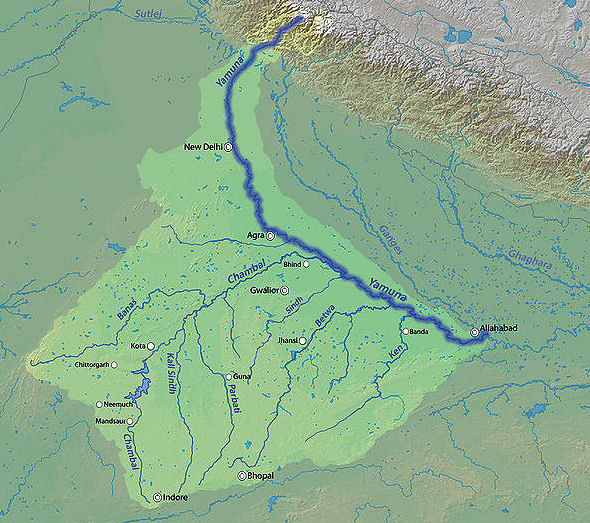
Abb.: Heutiger Lauf der Yamunā
[Bildquelle: Shannon / Wikipedia. -- GNU FDLicense]
26. madano manmatho māraḥ pradyumno mīnaketanaḥ
kandarpo darpako 'naṅgaḥ kāmaḥ pañcaśaraḥ smaraḥ
27. śambarārir manasijaḥ kusumeṣur ananyajaḥ
puṣpadhanvā ratipatir makaradhvaja ātmabhūḥ
मदनो मन्मथो मारः प्रद्युम्नो मीनकेतनः ।
कन्दर्पो दर्पको
ऽनङ्गः कामः पञ्चशरः स्मरः ॥२६॥
सम्बरारिर् मनसिजः कुसुमेषुर् अनन्यजः ।
पुष्पधन्वा रतिपतिर् मकरध्वज आत्मभूः ॥२७॥
[Bezeichnungen für den Liebesgott (Kāmadeva)1 sind:]
Erläuterungen:
1 Kāma, Kāmadeva - काम m., कामदेव m.: Liebesgott
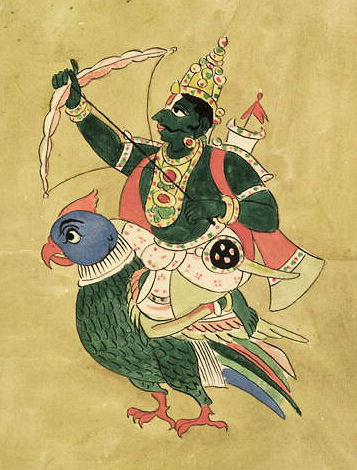
Abb.: Kāmadeva, 18./19. Jhdt. n. Chr.
[Bildquelle: Wikipedia. -- Public domain]
"KĀMA, KĀMA-DEVA. 'The god of love'. Eros, Cupid. In the Ṛg-veda (X. 129) desire is said to have been the first movement that arose in the One after it had come into life through the power of fervour or abstraction. "Desire first arose in It, which was the primal germ of mind ; (and which) sages, searching with their intellect, have discovered in their heart to be the bond which connects entity with non-entity." "It is well known," observes Dr. Muir, "that Greek mythology connected Eros, the god of love, with the creation of the universe somewhat in the same way." "This Kāma or desire, not of sexual enjoyment, but of good in general, is celebrated in a curious hymn of the Atharva-veda,"which exalts Kāma into a supreme God and Creator : "Kāma was born the first. Him neither gods, nor fathers, nor men have equalled. Thou art superior to these and for ever great." In another part of the same Veda Kāma appears to be first desire, then the power which gratifies the desire. Kāma is also in the same Veda often identified with Agni, and when "distinguished from each other, Kāma may be looked upon as a superior form of the other deity." According to the Taittirīya Brāhmaṇa, he is the son of Dharma, the god of justice, by Śraddhā, the goddess of faith; but according to the Hari-vaṃśa he is son of Lakṣmī. Another account represents him as springing from the heart of Brahmā. A fourth view is that he was born from water, wherefore he is called Irā-ja, the water-born; a fifth is that he is Ātma-bhū, 'self-existent', and therefore he is called, like other of the gods, A-ja, 'unborn', or An-anya-ja, 'born of no other'. In the Purāṇas his wife is Rati or Revā, the goddess of desire. He inspired Śiva with amorous thoughts of Pārvatī while he was engaged in penitential devotion, and for this offence the angry god reduced him to ashes by fire from his central eye. Śiva, afterwards relented and allowed Kāma to be born again as Pradyumna, son of Kṛṣṇa and Rukmiṇī or Māyā, delusion. He has a son named Aniruddha, and a daughter, Tṛṣā. He is lord of the Apsarases or heavenly nymphs. He is armed with a bow and arrows : the bow is of sugar-cane, the bowstring a line of bees, and each arrow is tipped with a distinct flower. He is usually represented as a handsome youth riding on a parrot and attended by nymphs, one of whom bears his banner displaying the Makara, or a fish on a red ground.
The mysterious origin of Kāma and the universal operation of the passion he inspires have accumulated upon him a great variety of names and epithets. Among his names are Iṣma, Kañjana and Kiṅkira, Mada, Rama or Ramaṇa, and Smara. As produced in the mind or heart he is Bhava-ja and Mano-ja. As Pradyumna, son of Kṛṣṇa, he is Karṣṇī, and as son of Lakṣmī he is Māyī or Māyā-suta and Śrī-nandana. As reduced to ashes by Śiva he is An-aṅga, 'the bodiless'. He is Abhi-rūpa, 'the beautiful'; Darpaka and Dīpaka, 'the inflamer' ; Gadayitnu, Gṛdhu, and Gṛtsa, 'lustful or sharp'; Kamana and Kharu, 'desirous' ; Kandarpa, 'the inflamer of Brahmā'; Kantu, 'the happy'; Kalākeli, 'the gay or wanton' ; Māra, 'destroyer'; Māyī, 'deluder' ; Madhu-dīpa, 'the lamp of honey or of spring'; Muhira, 'the bewilderer'; Murmura, 'the crackling fire'; Rāga-vṛnta, 'the stalk of passion' ; Rūpāstra, 'the weapon of beauty'; Rata-nārīca, 'the voluptuary'; Śamāntaka, 'destroyer of peace'; Saṃsāra-guru, 'teacher of the world'; Smara, 'remembrance'; Śṛṅgāra-yoni, 'source of love'; Titha, 'fire'; Vāma, 'the handsome'. From his bow and arrows he is called Kusumāyudha, 'armed with flowers'; Puṣpa-dhanus, 'whose bow is flowers'; and Puṣpa-śara, 'whose arrows are flowers'. From his banner he is known as Makara-ketu ; and from the flower he carries in his hand he is Puṣpa-ketana."
[Quelle: Dowson, John <1820-1881>: A classical dictionary of Hindu mythology and religion, geography, history, and literature. -- London, Trübner, 1879. -- s.v.]
2 Pradyumna प्रद्युम्न m.: Pradyumna
"PRADYUMNA. A son of Kṛṣṇa by Rukmiṇī. When a child only six days old, he was stolen by the demon Śambara and thrown into the ocean. There he was swallowed by a fish, which was afterwards caught and carried to the house of Śambara. When the fish was opened, a beautiful child was discovered, and Māyā-devī or Māyā-vatī, the mistress of Śambara's household, took him under her care. The sage Nārada informed her who the child was, and she reared him carefully. When he grew up she fell in love with him, and informed him who he was and how he had been carried off by Śambara. He defied the demon to battle, and after a long conflict slew him. Then he flew through the air with Māyāvati, and alighted in the inner apartments of his fathers palace. Kṛṣṇa presented him to his mother Rukmiṇī "with the virtuous Māyāvatī his wife," declaring her really to be the goddess Rati. Pradyumna also married Kakudmatī, the daughter of Rukmin, and had by her a son named Aniruddha. Pradyumna was killed at Dvārakā in the presence of his father during a drunken brawl. Though Pradyumna passed as the son of Kṛṣṇa, he was, according to the legend, a revival or resuscitation of Kāma, the god of love, who was reduced to ashes by the fiery glance of Śiva, and so the name Pradyumna is used for Kāma. (See Kāma.) The Viṣṇu Purāṇa puts the following words into the mouth of Nārada when he presented Pradyumna to Rukmiṇī : "When Manmatha (the deity of love) had perished, the goddess of beauty (Rati), desirous to secure his revival, assumed a delusive form, and by her charms fascinated the demon Śambara, and exhibited herself to him in various illusory enjoyments. This thy son is the descended Kāma ; and this is (the goddess) Rati, his wife. There is no occasion for any uncertainty ; this is thy daughter-in-law." In the Hari-vaṃśa he has a wife named Prabhāvatī, daughter of King Vajranābha. When he went to see her for the first time, he changed himself into a bee and lived in a garland of flowers which had been prepared for her. According to the Mahā-bhārata, he was Sanat-kumāra, the son of Brahmā."
[Quelle: Dowson, John <1820-1881>: A classical dictionary of Hindu mythology and religion, geography, history, and literature. -- London, Trübner, 1879. -- s.v.]
3 Anaṅga - अनङ्ग m.: Körperloser
anaṅga = an-aṅga = Gliedloser, Körperloser: so die in Indien allgemein akzeptierte Auflösung.
Siehe aber:
Konow, Sten: Anaṅga, the bodiless Cupid. -- In: Antdōron : Festschrift Jacob Wackernagel zur Vollendung des 70. Lebensjahres am 11. Dezember 1923 / gewidmet von Schülern, Freunden u. Kollegen. -- Göttingen : Vandenhoeck & Ruprecht , 1923. -- S. 1 - 8.
4 Pañcaśara - पञ्चशर m.: der fünf Pfeile hat
Die fünf Pfeile sind mit fünf verschiedenen Blüten bestückt:
Manche Ausgaben des Amarakośa haben hierzu folgende (interpolierten?) Verse:
aravindam aśokaṃ ca cūtaṃ ca navamallikā
nīlotpalaṃ ca pañcaite pañcabāṇasya sāyakāḥ
unmādanas tāpanaś ca śoṣaṇaḥ stambhanas tathā
saṃmohanaś ca kāmaś ca pañca bāṇāḥ prakīrtitāḥअरविन्दम् अशोकं च चूतं च नवमल्लिका ।
नीलोत्पलं च पञ्चैते पञ्चबाणस्य सायकाः ॥
उन्मादनस् तापनश् च शोषणः स्तम्भनस् तथा ।
संमोहनस्श् च कामश् च पञ्च बानाः प्रकीर्तिताः ॥Dies sind die fünf Pfeile dessen, der fünf Pfeile hat (Kāma):
- अरविन्द n.: Nelumbo nucifera Gaertn. = indische Lotusblume
- अशोक n.: Saraca indica L. =Aschokabaum
- चूत n.: Mangifera indica J. König ex L. = Echte Mango
- नवमल्लिका f.: Jasminum sambac (L.) Aiton. = arabischer Jasmin
- नीलोत्पल n.: Nymphaea nouchalii Burm. f. = Stern-Seerose, Blue Lotus
Die fünf Pfeile sind bekannt als:
- उन्मादन m.: Berauscher, Verrücktmacher
- तापन m.: Quäler
- शोषण m.: Austrockner
- स्तम्भन m.: Lähmer
- संमोहन m.: Verblender
- काम m.: Begier
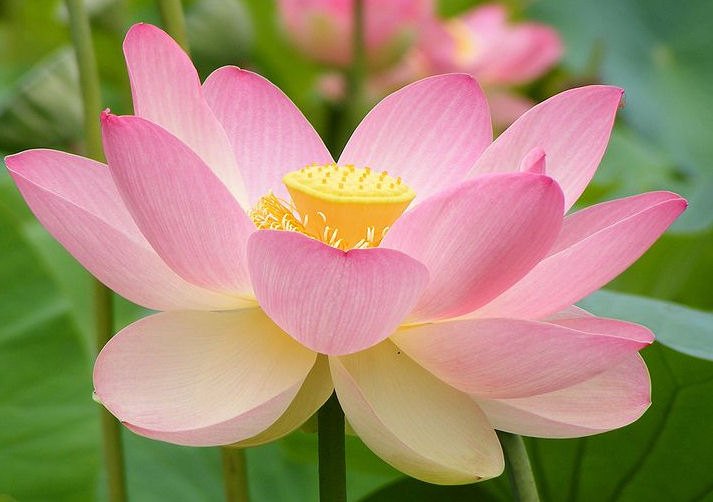
Abb.: aravinda: Nelumbo nucifera Gaertn. = indische Lotusblume
[Bildquelle: Peripitus / Wikipedia. -- GNU FDLicense]
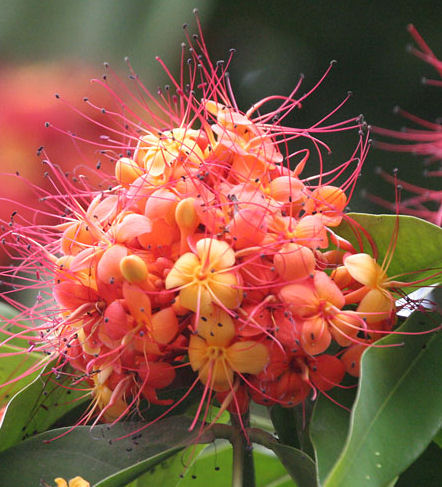
Abb.: aśoka: Saraca indica L. =Aschokabaum
[Bildquelle: J.M.Garg / Wikipmedia. -- GNU FDLicense]
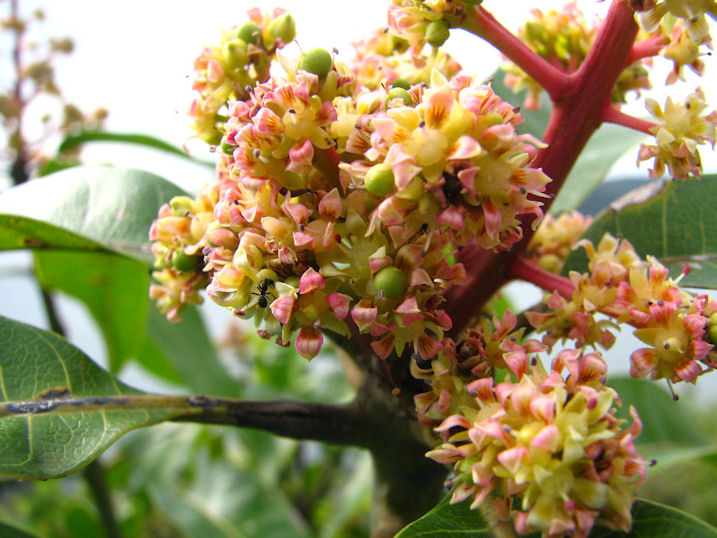
Abb.: cūta: Mangifera indica J. König ex L. = Echte Mango
[Bildquelle: Kate's Photo Diary. --
http://www.flickr.com/photos/lightcliff/3016121795/. -- Zugriff am
2010-07-01. --
Creative
Commons Lizenz (Namensnennung, keine kommerzielle Nutzung, keine
Bearbeitung)]
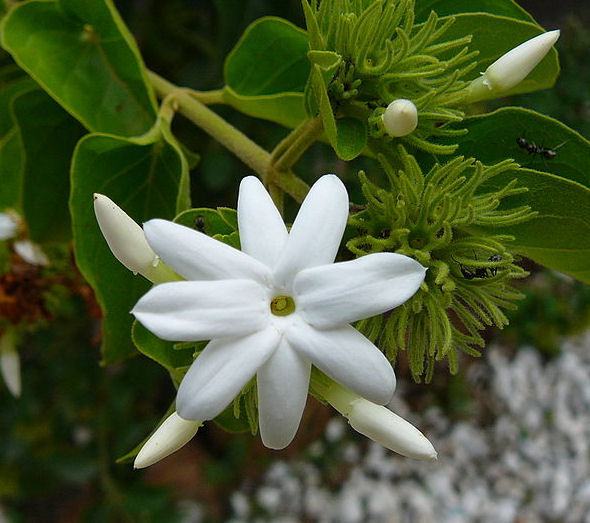
Abb.: navamallikā: Jasminum sambac (L.) Aiton. = arabischer Jasmin
[Bildquelle: Atamari / Wikipedia. --
Creative Commons
Lizenz (Namensnennung, share alike)]
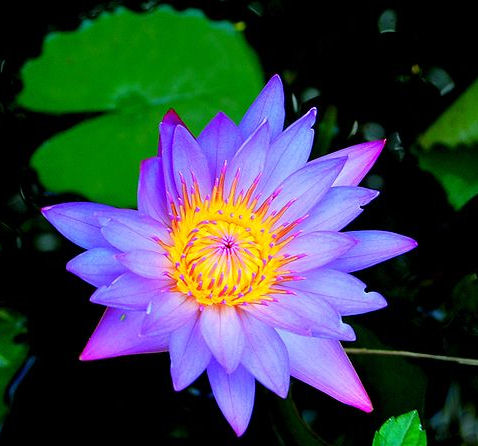
Abb.: nīlotpala: Nymphaea nouchalii Burm. f. = Stern-Seerose, Blue Lotus,
Myanmar
[Bildquelle: worak. --
http://www.flickr.com/photos/worak/908613624/. -- Zugriff am 2010-07-01. --
Creative Commons
Lizenz (Namensnennung)]
5 Śambarāri - शम्बरारि m.: Feind des Śambara
"ŚAMBARA. In the Vedas, a demon, also called a Dasyu, who fought against King Divodāsa, but was defeated and had his many castles destroyed by Indra. He appears to be a mythical personification of drought, of a kindred character to Vṛtra, or identical with him. In the Purāṇas a Daitya who carried off Pradyumna and threw him into the sea, but was subsequently slain by him. (See Pradjumna.) He was also employed by Hiraṇya-kaśipu to destroy Prahlāda." [Quelle: Dowson, John <1820-1881>: A classical dictionary of Hindu mythology and religion, geography, history, and literature. -- London, Trübner, 1879. -- s.v.]
6 Ratipati - रतिपति m.: Gatte der Rati
"RATI. 'Love, desire'. The Venus of the Hindus, the goddess of sexual pleasures, wife of Kāma the god of love, and daughter of Dakṣa. She is also called Revā, Kāmī, Prīti, Kāma-patni, 'wife of Kāma'; Kama-kalā, 'part of Kāma'; Kāmapriyā, 'beloved of Kāma' ; Rāga-lāṭā, 'vine of love' ; Māyāvatī, 'deceiver' ; Kelikilā, 'wanton' ; Śubhāṅgī, 'fair-limbed'."
[Quelle: Dowson, John <1820-1881>: A classical dictionary of Hindu mythology and religion, geography, history, and literature. -- London, Trübner, 1879. -- s.v.]
7 Makaradhvaja - मकरध्वज m.: der Makara als Flagge hat
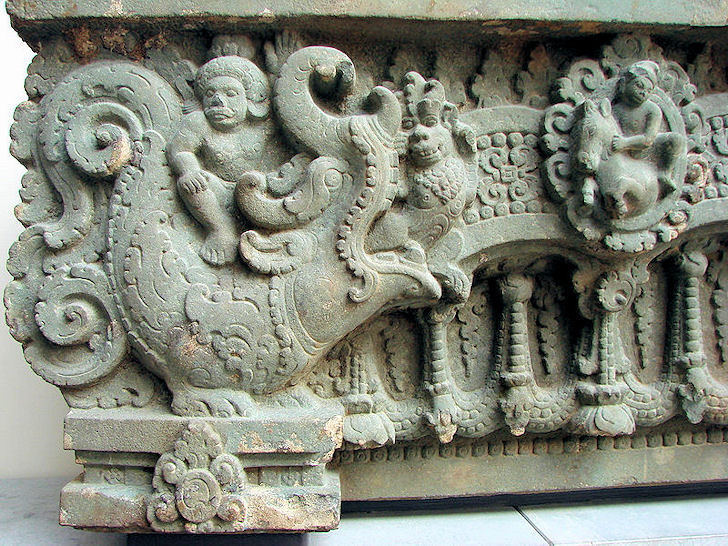
Abb.: Makara, Kompong Thom, Kambodscha, 7. Jhdt. n. Chr.
[Bildquelle: Vassil / Wikipedia. -- Public domain]
"MAKARA. A huge sea animal, which, has been taken to be the crocodile, the shark, the dolphin, etc., but is probably a fabulous animal. It represents the sign Capricornus in the Hindu zodiac, and is depicted with the head and forelegs of an antelope and the body and tail of a fish. It is the vehicle of Varuṇa, the god of the ocean, and its figure is borne on the banner of Kāma-deva, god of love. It is also called Kaṇṭaka, Asita-daṃṣṭra, 'black teeth', and Jala-rūpa, 'water form'." [Quelle: Dowson, John <1820-1881>: A classical dictionary of Hindu mythology and religion, geography, history, and literature. -- London, Trübner, 1879. -- s.v.]
28. a./b. brahmasūr viśvaketuḥ syād aniruddha uṣāpatiḥ
ब्रह्मसूर् विश्वकेतुः स्याद् अनिरुद्ध उषापतिः ॥२८ क्॥
[Der Sohn Kāmas heißt:]
- ब्रह्मसू m.: Brahma als Vater habend1
- विश्वकेतु (var. lect. ऋष्यकेतु) m.: Das All als Banner habend (var. lect.: die Ṛṣya-Antilope als Banner habend)
- अनिरुद्ध m.: Aniruddha2
- उषापति m.: Gatte der Uṣā3
Erläuterungen:
1 Brahmasū - ब्रह्मसू m.: Brahmā als Vater habend
Einige Kommentare beziehen diese Bezeichnung noch auf Kāmadeva
2 Aniruddha - अनिरुद्ध m.: Aniruddha
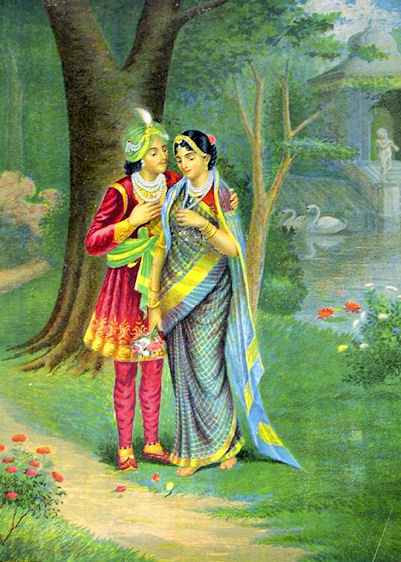
Abb.: Aniruddha mit Uṣā, Druck, Calcutta, ca. 1895
[Bildquelle: Wikipedia. -- Public domai.
"ANIRUDDHA. 'Uncontrolled'. Son of Pradyumna and grandson of Kṛṣṇa. He married his cousin, Su-bhadrā. A Daitya princess named Uṣā, daughter of Bāṇa, fell in love with him, and had him brought by magic influence to her apartments in her father's city of Sonita-pura. Bāṇa sent some guards to seize him, but the valiant youth, taking an iron club, slew his assailants. Bāṇa then brought his magic powers to bear and secured him. On discovering whither Aniruddha had been carried, Kṛṣṇa, Bala-rāma, and Pradyumna went to rescue him. A great battle wras fought ; Bāṇa was aided by Śiva and by Skanda, god of war, the former of whom was overcome by Kṛṣṇa, and the latter was wounded by Garuḍa and Pradyumna. Bāṇa was defeated, but his life was spared at the intercession of Śiva, and Aniruddha was carried home to Dvārakā with Uṣā as his wife. He is also called Jhaṣāṅka and Uṣā-pati. He had a son named Vajra."
[Quelle: Dowson, John <1820-1881>: A classical dictionary of Hindu mythology and religion, geography, history, and literature. -- London, Trübner, 1879. -- s.v.]
3 Uṣāpati - उषापति m.: Gatte der Uṣā
"UṢĀ. A Daitya princess, daughter of Bāṇa and grand daughter of Bali. She is called also Prīti-juṣā. She fell in love with a prince whom she saw in a dream, and was anxious to know if there were such a person. Her favourite companion, Citra-lekhā, drew the portraits of many gods and men, but Uṣā's choice fell upon Aniruddha, son of Pradyumna and grandson of Kṛṣṇa. Citra-lekhā, by her magic power, brought Aniruddha to Uṣā. Her father, on hearing of the youth's being in the palace, endeavoured to kill him, but he defended himself successfully. Bāṇa, however, kept Aniruddha, "binding him in serpent bonds." Kṛṣṇa, Pradyumna, and Bala-rāma went to the rescue ; and although Bāṇa was supported by Śiva and by Skanda, god of war, his party was defeated, and Aniruddha was carried back to Dvārakā with his wife Uṣā."
[Quelle: Dowson, John <1820-1881>: A classical dictionary of Hindu mythology and religion, geography, history, and literature. -- London, Trübner, 1879. -- s.v.]
28. c./d. lakṣmīḥ padmālayā padmā kamalā śrīr haripriyā
29. indirā lokamātā mā kṣīrodatanayā ramā
bhārgavī lokajananī kṣīrasāgarakanyakā
लक्ष्मीः पद्मालया पद्मा कमला श्रीर् हरिप्रिया
॥२८ ख्॥
इन्दिरा लोकमाता मा क्षीरोदतनया रमा ।
भार्गवी लोकजननी क्षीरसागरकन्यका ॥२९ क, ख॥
[Bezeichnungen für Lakṣmī sind:]
Erläuterungen:
1 Lakṣmī - लक्ष्मी f.: Lakṣmī
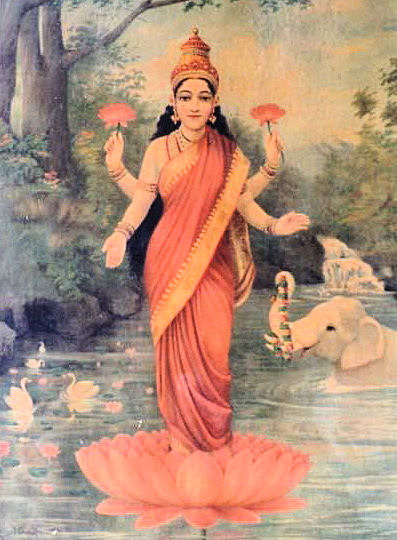
Abb.: Raja Ravi Varma (രാജാ രവി വര്മ)
<1848 - 1906>: Lakṣmī
[Bildquelle: Wikipedia. -- Public domain]
"LAKṢMĪ. The word occurs in the Ṛg-veda with the sense of good fortune, and in the Atharva-veda the idea has become personified in females both of a lucky and unlucky character. The Taittirīya Saṃhitā, as explained by the commentator, makes Lakṣmī and Śrī to be two wives of Āditya, and the Śatapatha Brāhmaṇa describes Śrī as issuing forth from Prajāpati.
Lakṣmī or Śrī in later times is the goddess of fortune, wife of Viṣṇu, and mother of Kāma. The origin ascribed to her by the Rāmāyaṇa is the one commonly received. According to this legend she sprang, like Aphrodite, from the froth of the ocean, in full beauty with a lotus in her hand, when it was churned by the gods and the Asuras. Another legend represents her as floating on the flower of a lotus at the creation. With reference to this origin, one of her names is Kṣīrābdhi-tanayā, 'daughter of the sea of milk'. From her connection with the lotus she is called Padmā. According to the Purāṇas, she was the daughter of Bhṛgu and Khyāti. The Viṣṇu Purāṇa says, "Her first birth was the daughter of Bhṛgu by Khyāti. It was at a subsequent period that she was produced from the sea at the churning of the ocean. . . . When Hari was born as a dwarf, Lakṣmī appeared from a lotus (as Padmā or Kamalā). When he was born as Rāma of the race of Bhṛgu (or Paraśu-rāma), she was Dharaṇī. When he was Rāghava (Rāma-candra), she was Sītā. And when he was Kṛṣṇa she became Rukmiṇī. In the other descents of Viṣṇu she is his associate." One version of the Rāmāyaṇa also affirms that "Lakṣmī, the mistress of the worlds, was born by her own will, in a beautiful field opened up by the plough," and received from Janaka the name of Sītā.
Lakṣmī is said to have four arms, but she is the type of beauty, and is generally depicted as having only two. In one hand she holds a lotus. "She has no temples, but being goddess of abundance and fortune, she continues to be assiduously courted, and is not likely to fall into neglect."
Other names of Lakṣmī are Hīrī, Indirā, Jaladhi-jā, 'ocean born' ; Cancalā or Lolā, 'the fickle', as goddess of fortune ; Loka-mātā, 'mother of the world'."
[Quelle: Dowson, John <1820-1881>: A classical dictionary of Hindu mythology and religion, geography, history, and literature. -- London, Trübner, 1879. -- s.v.]
2 Bhārgavī - भार्गवी f.: Tochter des Bhṛgu
"BHṚGU. A Vedic sage. He is one of the Prajāpatis and great Ṛṣis, and is regarded as the founder of the race of the Bhṛgus or Bhārgavas, in which was born Jamad-agni and Paraśu-Rāma. Manu calls him son, and says that he confides to him his Institutes. According to the Mahā-bhārata he officiated at Dakṣa's celebrated sacrifice, and had his beard pulled out by Śiva, The same authority also tells the following story : - It is related of Bhṛgu that he rescued the sage Agastya from the tyranny of King Nahuṣa, who had obtained superhuman power. Bhṛgu crept into Agastya s hair to avoid the potent glance of Nahuṣa, and when that tyrant attached Agastya to his chariot and kicked him on the head to make him move, Bhṛgu cursed Nahuṣa, and he was turned into a serpent. Bhṛgu, on Nahuṣa's supplication, limited the duration of his curse.
In the Padma Purāṇa it is related that the Ṛṣis, assembled at a sacrifice, disputed as to which deity was best entitled to the homage of a Brāhman. Being unable to agree, they resolved to send Bhrigu to test the characters of the various gods, and he accordingly went. He could not obtain access to Śiva because that deity was engaged with his wife ; "finding him, therefore, to consist of the property of darkness, Bhṛgu sentenced him to take the form of the Liṅga, and pronounced that he should have no offerings presented to him, nor receive the worship of the pious and respectable. His next visit was to Brahmā, whom he beheld surrounded by sages, and so much inflated with his own importance as to treat Bhṛgu with great inattention, betraying his being made up of foulness. The Muni therefore excluded him from the worship of the Brāhmans. Repairing next to Viṣṇu, he found the deity asleep, and, indignant at his seeming sloth, Bhṛgu stamped upon his breast with his left foot and awoke him ; instead of being offended, Viṣṇu gently pressed the Brāhman's foot and expressed himself honoured and made happy by its contact ; and Bhṛgu, highly pleased by his humility, and satisfied of his being impersonated goodness, proclaimed Viṣṇu as the only being to be worshipped by men or gods, in which decision the Munis, upon Bhṛgu's report, concurred." Wilson."
[Quelle: Dowson, John <1820-1881>: A classical dictionary of Hindu mythology and religion, geography, history, and literature. -- London, Trübner, 1879. -- s.v.]
29. e./f. śaṅkho lakṣmīpateḥ pāñcajanyaś cakraṃ sudarśanaḥ
30. kaumodakī gadā khaḍgo nandakaḥ kaustubho maṇiḥ
cāpaḥ śārṅgaṃ murāres tu śrīvatso lāñchanaṃ smṛtam
30a. aśvāś ca śaivya-sugrīva-meghapuṣpa-balāhakāḥ
sārathir dāruko mantrī hy uddhavaś cānujo gadaḥ
शङ्खो लक्ष्मीपतेः पाञ्चजन्यस् चक्रं सुदर्शनः॥२९
ग्॥
कौमोदकी गदा खड्गो नन्दकः कौस्तुभो मणिः
।
चापः शार्ङ्गं मुरारेस् तु श्रीवत्सो लाञ्छनं स्मृतम् ॥३०॥
अश्वाश् च शैव्य-सुग्रीव-मेघपुष्प-बलाहकाः ।
सारथिर् दारुको मन्त्री ह्य् उद्धवश् चानुजो गदः ॥३०a॥
Erläuterungen:
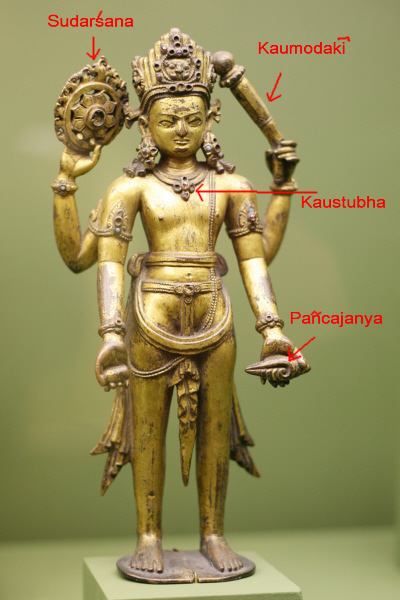
Abb.: Pañcajanya, Sudarśana, Kaumodakī, Kaustubha
Viṣṇu, 10. Jhdt. n. Chr.
[Bildquelle: katie chao and ben muessig / Wikimedia. --
Creative Commons
Lizenz (Namensnennung, share alike)]
1 Pāñcajanya - पाञ्चजन्य m.: von Pañcajana stammend
"PĀÑCAJANYA. Kṛṣṇa's conch, formed from the shell of the sea-demon Pañcajana."
[Quelle: Dowson, John <1820-1881>: A classical dictionary of Hindu mythology and religion, geography, history, and literature. -- London, Trübner, 1879. -- s.v.]
"PAÑCAJANA. Name of a demon who lived in the sea in the form of a conch-shell. He seized the son of Sāndīpani, under whom Kṛṣṇa learnt the use of arms. Kṛṣṇa rescued the boy, killed the demon, and afterwards used the conch-shell for a horn." [Quelle: Dowson, John <1820-1881>: A classical dictionary of Hindu mythology and religion, geography, history, and literature. -- London, Trübner, 1879. -- s.v.]
2 Sudarśana - सुदर्शन m.: Schöner
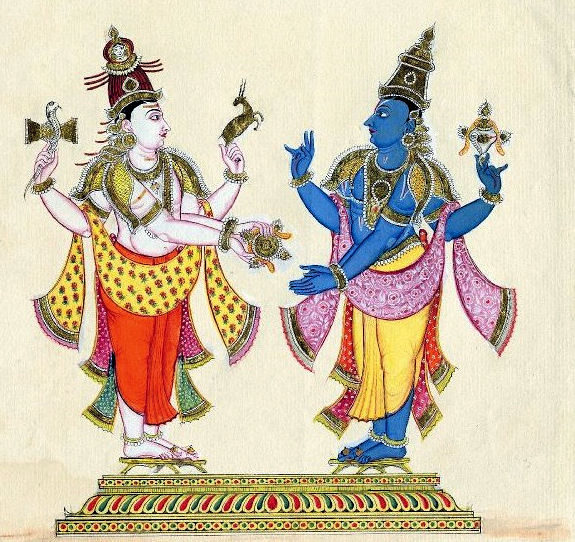
Abb.: Śiva gibt Kṛṣṇa das cakra (Wurfscheibe), ca. 1820
[Bildquelle: Wikipedia. -- Public domain]
Heißt auch Vajra-nābha:
"VAJRA-NĀBHA. The celebrated cakra (discus) of Kṛṣṇa. According to the Mahā-bhārata it was given to him by Agni for his assistance in defeating Indra and burning the Khāṇḍava forest." [Quelle: Dowson, John <1820-1881>: A classical dictionary of Hindu mythology and religion, geography, history, and literature. -- London, Trübner, 1879. -- s.v.]
3 Kaumodakī - कौमोदकी f.
"KAUMODAKĪ. The mace of Kṛṣṇa, presented to him by Agni when engaged with him in fighting against Indra and burning the Khāṇḍava forest."
[Quelle: Dowson, John <1820-1881>: A classical dictionary of Hindu mythology and religion, geography, history, and literature. -- London, Trübner, 1879. -- s.v.]
4 Nandaka - नन्दक m.
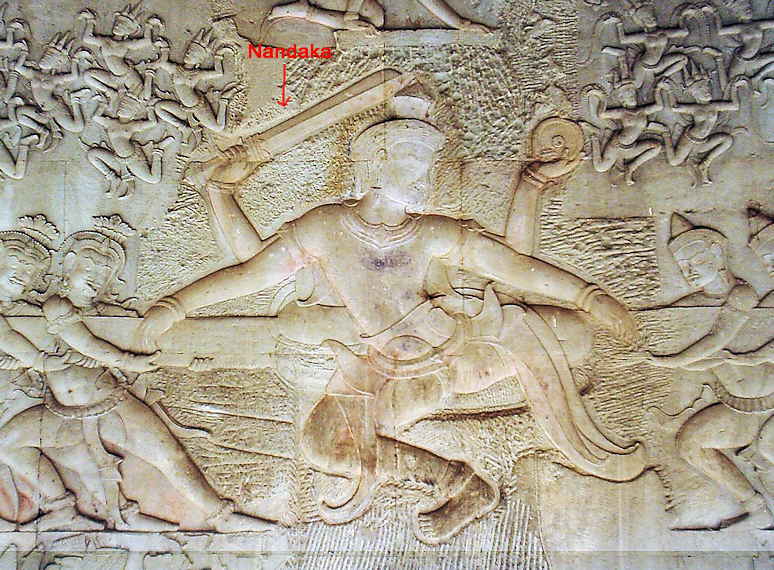
Abb.: Viṣṇu bei der Quirlung des Milchozeans, Angkor Wat (អង្គរវត្ត),
Kambodscha
[Bildquelle: Markalexander100 / Wikipedia. -- GNU FDLicense]
5 Kaustubha - कौस्तुभ m.
"KAUSTUBHA. A celebrated jewel obtained at the churning of the ocean, and worn by Viṣṇu or Kṛṣṇa on his bosom." [Quelle: Dowson, John <1820-1881>: A classical dictionary of Hindu mythology and religion, geography, history, and literature. -- London, Trübner, 1879. -- s.v.]
6 Śārṅga - शार्ङ्ग n.: Hornbogen
7 Śrīvatsa - श्रीवत्स m.
"ŚRĪ-VATSA. A particular mark, said to be a curl of hair on the breast of Viṣṇu or Kṛṣṇa, and represented by
."
[Quelle: Dowson, John <1820-1881>: A classical dictionary of Hindu mythology and religion, geography, history, and literature. -- London, Trübner, 1879. -- s.v.]
8 Śaivya, Sugrīva, Meghapuṣpa und Balāhaka - शैव्य m., सुग्रीव m., मेघपुष्प m., बलाहक m.
9 Dāruka - दारुक m.
"DĀRUKA. Kṛṣṇa's charioteer, and his attendant in his last days."
[Quelle: Dowson, John <1820-1881>: A classical dictionary of Hindu mythology and religion, geography, history, and literature. -- London, Trübner, 1879. -- s.v.]
10 Uddhava - उद्धव m.
"UDDHAVA. The friend and counsellor of Kṛṣṇa. According to some he was Kṛṣṇa's cousin, being son of Deva-bhāga, the brother of Vasu-deva. He was also called Pavana-vyādhi."
[Quelle: Dowson, John <1820-1881>: A classical dictionary of Hindu mythology and religion, geography, history, and literature. -- London, Trübner, 1879. -- s.v.]
11 Gada - गद m.
31. garutmān garuḍas tārkṣyo vainateyaḥ khageśvaraḥ
nāgāntako viṣṇurathaḥ suparṇaḥ pannagāśanaḥ
गरुत्मान् गरुडस् तार्क्ष्यो वैनतेयः खगेश्वरः ।
नागान्तको विष्णुरथः सुपर्णः पन्नगाशनः ॥३१॥
[Bezeichnungen für Garuḍa1 sind:]
Erläuterungen:
1 Garuḍa - गरुड m.: Garuḍa
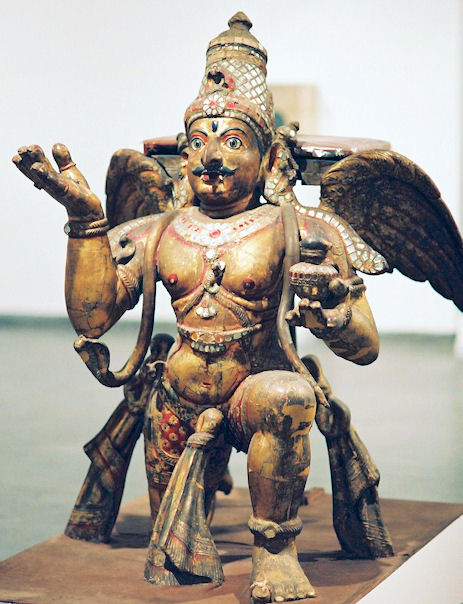
Abb.: Garuḍa
[Bildquelle: Hyougushi. -- http://www.flickr.com/photos/hyougushi/27958431/. -- Zugriff am 2010-06-28. -- Creative Commons Lizenz (Namensnennung, share alike)]
"GARUḌA. A mythical bird or vulture, half-man, half-bird, on which Viṣṇu rides. He is the king of birds, and descended from Kaśyapa and Vinatā, one of the daughters of Dakṣa. He is the great enemy of serpents, having inherited his hatred from his mother, who had quarrelled with her co-wife and superior, Kadru, the mother of serpents. His lustre was so brilliant that soon after his birth the gods mistook him for Agni and worshipped him. He is represented as having the head, wings, talons, and beak of an eagle, and the body and limbs of a man. His face is white, his wings red, and his body golden. He had a son named Sampāti, and his wife was Unnati or Vināyakā. According to the Mahā-bhārata, his parents gave him liberty to devour bad men, but he was not to touch Brāhmans. Once, however, he swallowed a Brāhman and his wife, but the Brāhman so burnt his throat that he was glad to disgorge them both.
Garuḍa is said to have stolen the Amṛta from the gods in order to purchase with it the freedom of his mother from Kadru. Indra discovered the theft and fought a tierce battle with Garuḍa. The Amṛta was recovered, but Indra was worsted in the fight, and his thunderbolt was smashed.
Garuḍa has many names and epithets. From his parents he is called Kāśyapi and Vainateya. He is the Suparṇa and the Garutmān, or chief of birds. He is also called Dakṣāya, Śalmalin, Tārkṣya, and Vināyaka, and among his epithets are the following : Sitānana, 'white faced' ; Rakta-pakṣa, 'red winged' ; Śveta-rohita, 'the white and red' ; Suvarṇa-kāya, 'golden bodied' ; Gaganeśvara, 'lord of the sky' ; Khageśvara, 'king of birds' ; Nāgāntaka, and Pannaga-nāśana, 'destroyer of serpents' ; Sarpārāti, 'enemy of serpents' ; Tarasvin, 'the swift' ; Rasāyana, 'who moves like quicksilver' ; Kāma-carin, 'who goes where he will' ; Kāmāyus, 'who lives at pleasure' ; Cirād, 'eating long' ; Viṣṇu-ratha, 'vehicle of Viṣṇu' ; Amṛtāharaṇa and Sudhā-hara, 'stealer of the Amṛta' ; Surendra-jit, 'vanquisher of Indra' ; Vajra-jit, 'subduer of the thunderbolt', &c."
[Quelle: Dowson, John <1820-1881>: A classical dictionary of Hindu mythology and religion, geography, history, and literature. -- London, Trübner, 1879. -- s.v.]
2 Vainateya - वैनतेय m.: Sohn der Vinatā
"VINATĀ. A daughter of Dakṣa, one of the wives of Kaśyapa, and mother of Garuḍa. According to the Bhāgavata Purāṇa she was the wife of Tārkṣya or Garuḍa."
[Quelle: Dowson, John <1820-1881>: A classical dictionary of Hindu mythology and religion, geography, history, and literature. -- London, Trübner, 1879. -- s.v.]
3 Nāgāntaka - नागान्तक m.: Schlangentöter ; पन्नगाशन m.: Schlangenfresser
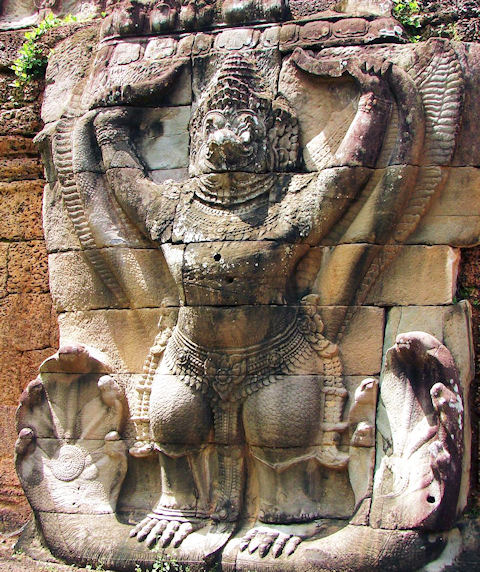
Abb.: Garuḍa mit Nāgas, Angkor(អង្គរ),
Kambodscha
[Bildquelle: The Shifted Librarian. --
http://www.flickr.com/photos/shifted/3115076450/. -- Zugriff am 2010-07-02.
-- Creative
Commons Lizenz (Namensnennung, keine kommerzielle Nutzung, share alike)]
4 Viṣṇuratha - विष्णुरथ m.: Gefährt Viṣṇus
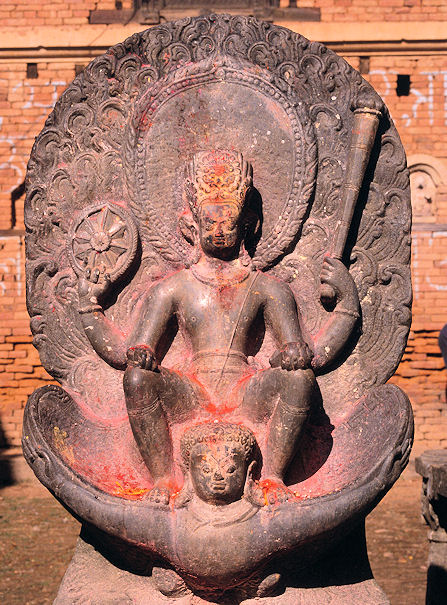
Abb.: Viṣṇu auf Garuḍa reitend, Bhaktapur (भक्तपुर),
Nepal
[Bildquelle: Till Niermann / Wikipedia. -- GNU FDLicense]
32. śambhur īśaḥ paśupatiḥ śivaḥ śūlī maheśvaraḥ
īśvaraḥ śarva īśānaḥ śaṃkaraś candraśekharaḥ
33. bhūteśaḥ khaṇḍaparaśur girīśo giriśo mṛḍaḥ
mṛtyuñjayaḥ kṛttivāsāḥ pinākī pramathādhipaḥ
34. ugraḥ kapardī śrīkaṇṭhaḥ śitikaṇṭhaḥ kapālabhṛt
vāmadevo mahādevo virūpākṣas trilocanaḥ
35. kṛśānuretāḥ sarvajño dhūrjaṭir nīlalohitaḥ
haraḥ smaraharo bhargas tryambakas tripurāntakaḥ
36. gaṅgādharo 'ndhakaripuḥ kratudhvaṃsī vṛṣadhvajaḥ
vyomakeśo bhavo bhīmaḥ sthāṇū rudra umāpatiḥ
37 a./b. ahirbudhnyo 'ṣṭamūrtiś ca gajāriś ca mahānaṭaḥ
शम्भुर् ईशः पशुपतिः शिवः शूली महेश्वरः ।
ईश्वरः शर्व ईशानः शंकरश् चन्द्रशेखरः ॥३२॥
भूतेशः खण्डपरशुर् गिरीशो गिरिशो मृडः ।
मृत्युञ्जयः कृत्तिवासाः पिनाकी प्रमथाधिपः ॥३३॥
उग्रः कपर्दी श्रीकण्ठः शितिकण्ठः कपालभृत् ।
वामदेवो महादेवो विरूपाक्षस् त्रिलोचनः ॥३४॥
कृशानुरेताः सर्वज्ञो धूर्जटिर् नीललोहितः ।
हरः स्मरहरो भर्गस् त्र्यम्बकस् त्रिपुरान्तकः ॥३५॥
गङ्गाधरो
ऽन्धकरिपुः
क्रतुध्वंसी वृषध्वजः ।
व्योमकेशो भवो भीमः स्थानू रुद्र उमापतिः ॥३६॥
अहिर्बुध्न्यो
ऽष्टमूर्तिश्
च गजारिश् च महानटः ।३७ क्।
[Bezeichnungen für Śiva1 sind:]
Erläuterungen:
1 Śiva - शिव m.: Śiva (Gnädiger)
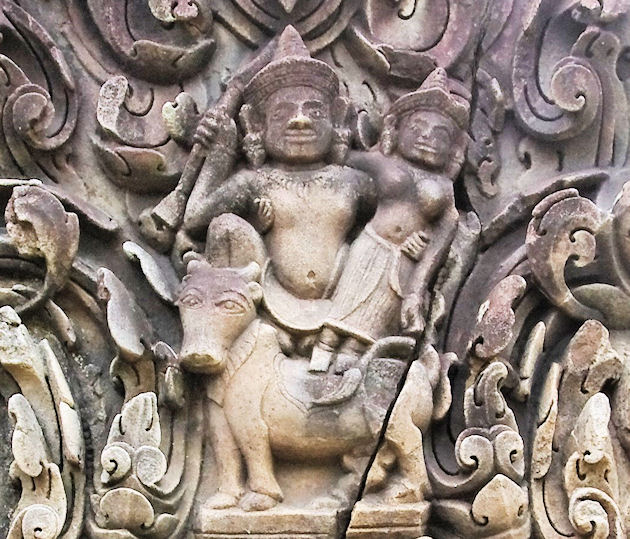
Abb.: Śiva und Pārvatī, Prang Song Phi Nong (ปรางค์สองพี่น้อง), Thailand, ca.
12. Jhdt.
[Bildquelle: Ddalbiez / Wikimedia commons. -- GNU FDLicense]
"ŚIVA. The name Śiva, is unknown to the Vedas, but Rudra, another name of this deity, and almost equally common, occurs in the Veda both in the singular and plural, and from these the great deity Śiva and his manifestations, the Rudras, have been developed. In the Ṛg-veda the word Rudra is used for Agni, and the Maruts are called his sons. In other passages he is distinct from Agni. He is lauded as "the lord of songs, the lord of sacrifices, who heals remedies, is brilliant as the sun, the best and most bountiful of gods, who grants prosperity and welfare to horses and sheep, men, women, and cows ; the lord of nourishment, who drives away diseases, dispenses remedies, and removes sin ; but, on the other hand he is the wielder of the thunderbolt, the bearer of bow and arrows, and mounted on his chariot is terrible as a wild beast, destructive and fierce." In the Yajur-veda there is a long prayer called Śatarudriya which is addressed to him and appeals to him under a great variety of epithets. He is "auspicious, not terrible" ; "the deliverer, the first divine physician" ; he is "blue-necked and red-coloured, who has a thousand eyes and bears a thousand quivers" ; and in another hymn he is called "Tryambaka, the sweet-scented increaser of prosperity" ; "a medicine for kine and horses, a medicine for men, and a (source of) ease to rams and ewes." In the Atharva-veda he is still the protector of cattle, but his character is fiercer. He is "dark, black, destroying, terrible." He is the "fierce god," who is besought to betake himself elsewhere, "and not to assail mankind with consumption, poison, or celestial fire."
The Brāhmaṇas tell that when Rudra was born he wept, and his father, Prajāpati, asked the reason, and on being told that he wept because he had not received a name, his father gave him the name of Rudra (from the root rud, 'weep'). They also relate that at the request of the gods he pierced Prajāpati because of his incestuous intercourse with his daughter. In another place he is said to have applied to his father eight successive times for a name, and that he received in succession the names Bhava, Śarva, Paśupati, Ugradeva, Mahādeva, Rudra, Īśāna, and Aśani.
In the Upaniṣads his character is further developed. He declares to the inquiring gods, "I alone was before (all things), and I exist and I shall be. No other transcends me. I am. eternal and not eternal, discernible and undiscernible, I am Brahma and I am not Brahma." Again it is said, "He is the only Rudra, he is Īśāna, he is divine, he is Maheśvara, he is Mahādeva." "There is only one Rudra, there is no place for a second. He rules this fourth world, controlling and productive ; living beings abide with him, united with him. At the time of the end he annihilates all worlds, the protector." "He is without beginning, middle, or end ; the one, the pervading, the spiritual and blessed, the wonderful, the consort of Umā, the supreme lord, the three-eyed, the blue-throated, the tranquil. . . . He is Brahmā, he is Śiva, he is Indra; he is undecaying, supreme, self-resplendent ; he is Viṣṇu, he is breath, he is the spirit, the supreme lord ; he is all that hath been or that shall be, eternal. Knowing him, a man overpasses death. There is no other way to liberation."
In the Rāmāyṇa Śiva is a great god, but the references to him have more of the idea of a personal god than of a supreme divinity. He is represented as fighting with Viṣṇu, and as receiving worship with Brahmā, Viṣṇu, and Indra, but he acknowledges the divinity of Rāma, and holds a less exalted position than Viṣṇu.
The Mahā-bhārata also gives Viṣṇu or Kṛṣṇa the highest honour upon the whole. But it has many passages in which Śiva occupies the supreme place, and receives the homage and worship of Viṣṇu and Kṛṣṇa. "Mahā-deva," it says, "is an all-pervading god yet is nowhere seen; he is the creator and the lord of Brahma, Viṣṇu, and Indra, whom the gods, from Brahmā to the Piśācas, worship." The rival claims of Śiva and Viṣṇu to supremacy are clearly displayed in this poem ; and many of those powers and attributes are ascribed to them which were afterwards so widely developed in the Purāṇas. Attempts also are made to reconcile their conflicting claims by representing Śiva, and Viṣṇu, Śiva and Kṛṣṇa, to be one, or, as it is expressed at a later time in the Hari-vaṃśa, there is "no difference between Śiva who exists in the form of Viṣṇu, and Viṣṇu who exists in the form of Śiva."
The Purāṇas distinctly assert the supremacy of their particular divinity, whether it be Śiva or whether it be Viṣṇu, and they have developed and amplified the myths and allusions of the older writings into numberless legends and stories for the glorification and honour of their favourite god.
The Rudra of the Vedas has developed in the course of ages into the great and powerful god Śiva, the third deity of the Hindu triad, and the supreme god of his votaries. He is shortly described as the destroying principle, but his powers and attributes are more numerous and much wider. Under the name of Rudra or Mahā-kāla, he is the great destroying and dissolving power. But destruction in Hindu belief implies reproduction ; so as Śiva or Śaṅkara, 'the auspicious', he is the reproductive power which is perpetually restoring that which has been dissolved, and hence he is regarded as Īśvara, 'the supreme lord', and Mahā-deva, 'the great god'. Under this character of restorer he is represented by his symbol the Liṅga or phallus, typical of reproduction ; and it is under this form alone, or combined with the Yoni, or female organ, the representative of his Śakti, or female energy, that he is everywhere worshipped. Thirdly, he is the Mahā-yogī, 'the great ascetic', in whom is centred the highest perfection of austere penance and abstract meditation, by which the most unlimited powers are attained, marvels and miracles are worked, the highest spiritual knowledge is acquired, and union with the great spirit of the universe is eventually gained. In this character he is the naked ascetic Dig-ambara, 'clothed with the elements', or Dhūr-jaṭi, 'loaded with matted hair', and his body smeared with ashes. His first or destructive character is sometimes intensified, and he becomes Bhairava, 'the terrible destroyer', who takes a pleasure in destruction. He is also Bhūteśvara, the lord of ghosts and goblins. In these characters he haunts cemeteries and places of cremation, wearing serpents round his head and skulls for a necklace, attended by troops of imps and trampling on rebellious demons. He sometimes indulges in revelry, and, heated with drink, dances furiously with his wife Devi the dance called Tāṇḍava, while troops of drunken imps caper around them. Possessed of so many powers and attributes, he has a great number of names, and is represented under a variety of forms. One authority enumerates a thousand and eight names, but most of these are descriptive epithets, as Tri-locana, 'the three-eyed', Nīla-kantha, 'the blue-throated', and Pañc-ānana, 'the five-faced'. Śiva is a fair man with five faces and four arms. He is commonly represented seated in profound thought, with a third eye in the middle of his forehead, contained in or surmounted by the moon's crescent ; his matted locks are gathered up into a coil like a horn, which bears upon it a symbol of the river Ganges, winch he caught as it fell from heaven ; a necklace of skulls (muṇḍa-mālā), hangs round his neck, and serpents twine about his neck as a collar (nāga-kuṇḍala); his neck is blue from drinking the deadly poison which would have destroyed the world, and in his hand he holds a triśūla or trident called Pināka. His garment is the skin of a tiger, a deer, or an elephant, hence he is called Kṛtti-vāsas ; sometimes he is clothed in a skin and seated upon a tiger-skin, and he holds a deer in his hand. He is generally accompanied by his bull Nandī. He also carries the bow Ajagava, a drum (ḍamaru) in the shape of an hour-glass, the Khaṭvāṅga or club with a skull at the end, or a cord (pāśa) for binding refractory offenders. His Pramathas or attendants are numerous, and are imps and demons of various kinds. His third eye has been very destructive. With it he reduced to ashes Kāma, the god of love, for daring to inspire amorous thoughts of his consort Pārvatī while he was engaged in penance ; and the gods and all created beings were destroyed by its glance at one of the periodical destructions of the universe. He is represented to have cut off one of the heads of Brahmā for speaking disrespectfully, so that Brahmā has only four heads instead of five. Śiva is the great object of worship at Benares under the name of Viśveśvara. His heaven is on Mount Kailāsa.
There are various legends respecting Śiva's garments and weapons. It is said that "he once visited a forest in the form of a religious mendicant, and the wives of the Ṛṣis residing there fell in love with his great beauty, which the Ṛṣis, perceiving, resented ; in order, therefore, to overpower him, they first dug a pit, and by magical arts caused a tiger to rush out of it, which he slew, and taking his skin wore it as a garment ; they next caused a deer to spring out upon him, which he took up in his left hand and ever after retained there. They then produced a red-hot iron, but this too he took up and kept in his hand as a weapon. . . . The elephant's skin belonged to an Asura named Gaya, who acquired such power that he would have conquered the gods, and would have destroyed the Munis had they not fled to Benares and taken refuge in a temple of Śiva, who then destroyed the Asura, and, ripping up his body, stripped off the (elephant) hide, which he cast over his shoulders for a cloak." Williams.
Other names or epithets of Śiva are Aghora, 'horrible'; Babhru, Bhagavat, 'divine'; Candra-śekhara, 'moon-crested'; Gaṅgā-dhara, 'bearer of the Ganges'; Girīśa, 'mountain lord' ; Hara, 'seizer'; Īśāna, 'ruler'; Jaṭā-dhara, 'wearing matted hair'; Jala-mūrti, 'whose form is water'; Kāla, 'time'; Kālañ-jara; Kapāla-mālin, 'wearing a garland of skulls'; Mahā-kāla, 'great time'; Maheśa, 'great lord'; Mṛtyuñ-jaya, 'vanquisher of death'; Paśu-pati, 'lord of animals'; Śankara, Śarva, Sadāśiva or Śambhu, 'the auspicious'; Sthānu, 'the firm'; Tryambaka, 'three-eyed' ; Ugra, 'fierce' ; Virūpākṣa, 'of misformed eyes' ; Viśvanātha, 'lord of all'."
[Quelle: Dowson, John <1820-1881>: A classical dictionary of Hindu mythology and religion, geography, history, and literature. -- London, Trübner, 1879. -- s.v.]
2 Śūlin - शूलिन् m.: durch einen Spieß (śūla) Gekennzeichneter
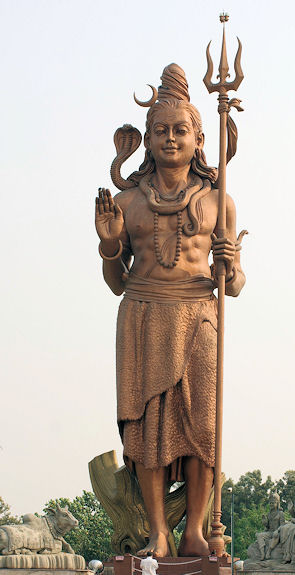
Abb.: Śiva mit Dreispieß (triśūla), Delhi
[Bildquelle: Arjuna Filips / Wikipedia. -- GNU FDLicense]
3 Īśāna - ईशान m.: Herrscher
"ĪŚĀNA. A name of Śiva or Rudra, or of one of his manifestations. (See Rudra.) He is guardian of the north-east quarter."
[Quelle: Dowson, John <1820-1881>: A classical dictionary of Hindu mythology and religion, geography, history, and literature. -- London, Trübner, 1879. -- s.v.]
4 Candraśekhara - चन्द्रशेखर m.: Monddiadem-Träger
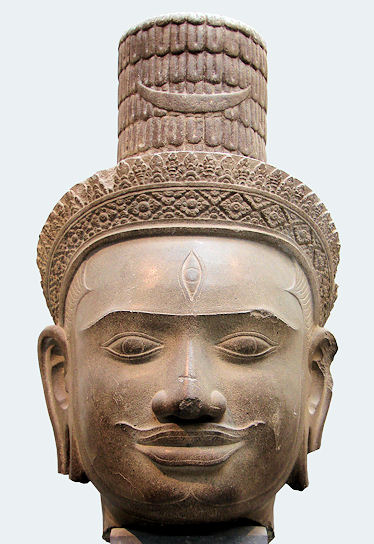
Abb.: Śiva candraśekhara, Phnom Bok (ប្រាសាទភ្នំបូក)
, Kambodscha, 9. Jhdt. n. Chr.
[Bildquelle: Vassil / Wikimedia commons. -- Public domain]
5 Girīśa - गिरीश m.: Herr der Berge / Herr auf dem Berg (Kailāsa)
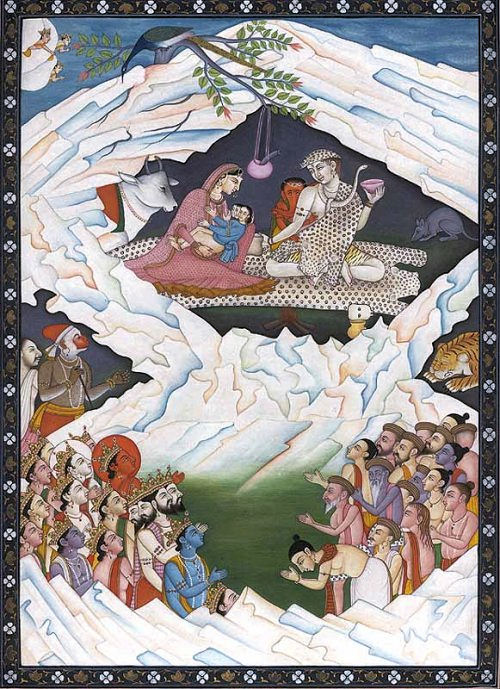
Abb.: Śiva und seine Familie auf dem Berg Kailāsa, 18. Jhdt. n. Chr.
[Bildquelle: Wikipedia. -- Public domain]
6 Kṛttivāsas - कृत्तिवासस् m.: Fellbekleideter
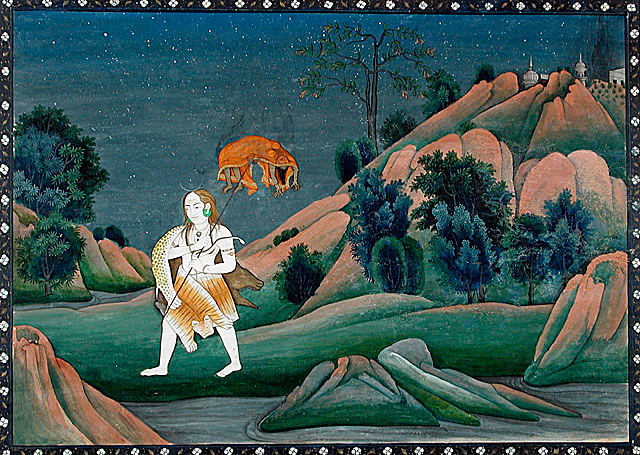
Abb.: Der mit Fellen bekleidete Śiva trägt Satī auf seinem Dreispieß, Kangra,
Himachal Pradesh, ca. 1800
[Bildquelle: Wikipedia. -- Public domain]
7 Pramathādhipa - प्रमथाधिप m.: Herr der Pramathas
"PRAMATHAS. A class of demi-gods or fiends attendant upon Śiva."
[Quelle: Dowson, John <1820-1881>: A classical dictionary of Hindu mythology and religion, geography, history, and literature. -- London, Trübner, 1879. -- s.v.]
8 Kapardin - कपर्दिन् m.: Haarflechtenträger
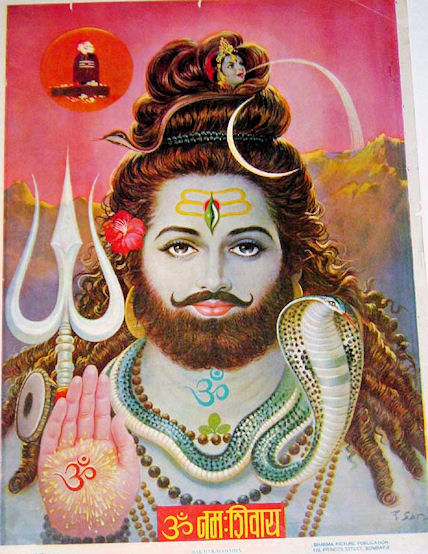
Abb.: Haarflechtenträger Śiva, 1940er-Jahre
[Bildquelle: WIkimedia commons. -- Public domain]
9 Trilocana - त्रिलोचन m.: Dreiäugiger
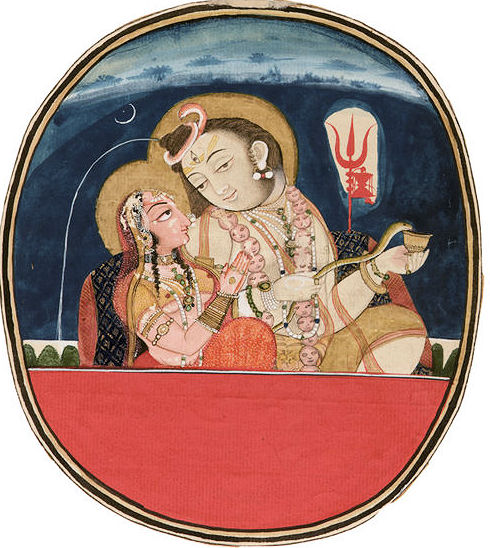
Abb.: Śiva (mit drei Augen) und Pārvatī
[Bildquelle: Wikipedia. -- Public domain]
"TRI-LOCANA. 'Three-eyed', ie., Śiva. The Mahā-bhārata relates that the third eye burst from Śiva's forehead with a great flame when his wife playfully placed her hands over his eyes after he had been engaged in austerities in the Himalaya. This eye has been very destructive. It reduced Kāma, the god of love, to ashes." [Quelle: Dowson, John <1820-1881>: A classical dictionary of Hindu mythology and religion, geography, history, and literature. -- London, Trübner, 1879. -- s.v.]
10 Tripurāntaka - त्रिपुरान्तक m.: Vernichter (des Asura) Tripura
"TRI-PURA. 'Triple city'. [...] A name of the demon Bāṇa, because he received in gift three cities from Śiva, Brahmā, and Viṣṇu. He was killed by Śiva. His name at full length is Tripurāsura. The name is also applied to Śiva."
[Quelle: Dowson, John <1820-1881>: A classical dictionary of Hindu mythology and religion, geography, history, and literature. -- London, Trübner, 1879. -- s.v.]
11 Gaṅgādhara - गङ्गाधर m.: Festhalter der Gaṅgā (des Ganges)
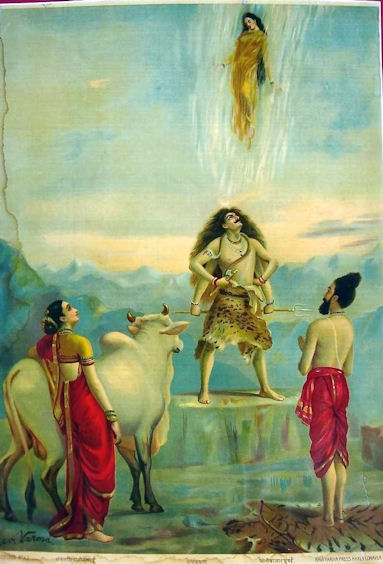
Abb.: Raja Ravi Varma (രാജാ രവി വര്മ)
<1848 - 1906>: Śiva fängt den Fall der Gaṅgā auf
[Bildquelle: Wikipedia. -- Public domain]
"GAṄGĀ. The sacred river Ganges. It is said to be mentioned only twice in the Ṛg-veda. The Purāṇas represent the Viyad-gaṅgā, or heavenly Ganges, to flow from the toe of Viṣṇu, and to have been brought down from heaven, by the prayers of the saint Bhagīratha, to purify the ashes of the sixty thousand sons of King Sagara, who had been burnt by the angry glance of the sage Kapila. From this earthly parent the river is called Bhāgīrathī. Gaṅgā was angry at being brought down from heaven, and Śiva, to save the earth from the shock of her fall, caught the river on his brow, and checked its course with his matted locks. From this action he is called Gaṅgā-dhara, 'upholder of the Ganges'. The river descended from Śiva's brow in several streams, four according to some, and ten according to others, but the number generally accepted is seven, being the Sapta-sindhava, the seven sindhus or rivers. The Ganges proper is one of the number. The descent of the Ganges disturbed the sage Jahnu as he was performing a sacrifice, and in his anger he drank up the waters, but he relented and allowed the river to flow from his ear, hence the Ganges has the name of Jāhnavī. Personified as a goddess, Gaṅgā is the eldest daughter of Himavat and Menā, and her sister was Umā. She became the wife of King Śāntanu and bore a son, Bhīṣma; who is also known by the metronymic Gāṅgeya. Being also, in a peculiar way, the mother of Kārtikeya (q.v.), she is called Kumāra-sū. Gold, according to the Mahā-bhārata, was borne by the goddess Gaṅgā to Agni, by whom she had been impregnated. Other names and titles of the Ganges are Bhadra-somā, Gāndinī, Kirātī, Deva-bhūti, 'produced in heaven'; Hara-śekharā, 'crest of Śiva' ; Khāpagā, 'flowing from heaven'; Mandākinī, 'gently flowing' ; Tri-patha-ga or Tri-śrotaḥ, 'triple flowing', running in heaven, earth, and hell." [Quelle: Dowson, John <1820-1881>: A classical dictionary of Hindu mythology and religion, geography, history, and literature. -- London, Trübner, 1879. -- s.v.]
12 Andhakaripu - अन्धकरिपु m.: Feind des (Asura) Andhaka
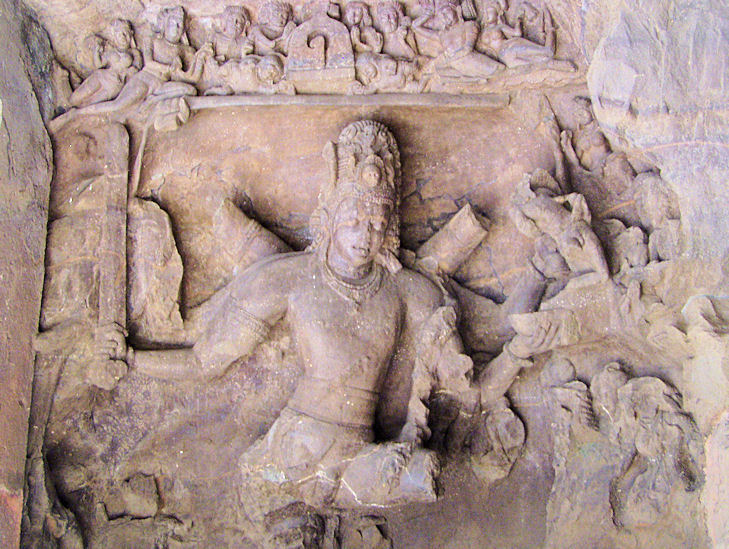
Abb.: Śiva als Bhairava tötet den Asura Andhaka, Elephanta (घारापुरीच्या
लेण्या)
[Bildquelle: Sivaraj D / Wikimedia commons. -- GNU FDLicense]
"ANDHAKA. A demon, son of Kaśyapa and Diti, with a thousand arms and heads, two thousand eyes and feet, and called Andhaka because he walked like a blind man, although he saw very well. He was slain by Śiva when he attempted to carry off the Pārijāta tree from Svarga. From this feat Śiva obtained the appellation Andhaka-ripu, 'foe of Andhaka'."
[Quelle: Dowson, John <1820-1881>: A classical dictionary of Hindu mythology and religion, geography, history, and literature. -- London, Trübner, 1879. -- s.v.]
14 Kratudhvaṃsin - क्रतुध्वंसिन् m.: Vernichter des Opfers (des Dakṣa)
"An important event in the life of Dakṣa, and very frequently referred to, is " Dakṣa s sacrifice," which was violently interrupted and broken up by Śiva, The germ of this story is found in the Taittirīya Saṃhitā, where it is related that the gods, having excluded Rudra from a sacrifice, he pierced the sacrifice with an arrow, and that Pūṣan, attempting to eat a portion of the oblation, broke his teeth. The story is found both in the Rāmāyaṇa and Mahā-bhārata. According to the latter, Dakṣa was engaged in sacrifice, when Śiva in a rage, and shouting loudly, pierced the offering with an arrow. The gods and Asuras were alarmed and the whole universe quaked. The Ṛṣis endeavoured to appease the angry god, but in vain. "He ran up to the gods, and in his rage knocked out the eyes of Bhaga with a blow, and, incensed, assaulted Pūṣan with his foot and knocked out his teeth as he was eating the offering." The gods and Ṛṣis humbly propitiated him, and when he was appeased" they apportioned to him a distinguished share in the sacrifice, and through fear resorted to him as their refuge."
In another part of the same work the story is again told with considerable variation. Dakṣa instituted a sacrifice and apportioned no share to Rudra (śiva). Instigated by the sage Dadhīci, the god hurled his blazing trident, which destroyed the sacrifice of Dakṣa and fell with great violence on the breast of Nārāyaṇa (Viṣṇu). It was hurled back with violence to its owner, and a furious battle ensued between the two gods, which was not intermitted till Brahmā prevailed upon Rudra to propitiate Nārāyaṇa. That god was gratified, and said to Rudra, "He who knows thee knows me ; he who loves thee loves me."
The story is reproduced in the Purāṇas with many embellishments. Dakṣa instituted a sacrifice to Viṣṇu, and many of the gods repaired to it, but Śiva was not invited, because the gods had conspired to deprive him of sacrificial offerings. The wife of Śiva, the mountain goddess Umā, perceived what was going on. Umā was a second birth of Satī, daughter of Dakṣa, who had deprived herself of life in consequence of her father's quarrel with herself and her husband, Śiva. Umā urged her husband to display his power and assert his rights. So he created Vīra-bhadra, "a being like the fire of fate," and of most terrific appearance and powers. He also sent with him hundreds and thousands of powerful demigods whom he called into existence. A terrible catastrophe followed ; "the mountains tottered, the earth shook, the winds roared, and the depths of the sea were disturbed." The sacrifice is broken up, and, in the words of Wilson, "Indra is knocked down and trampled on, Yama has his staff broken, Sarasvatī and the Mātṛs have their noses cut off, Mitra or Bhaga has his eyes pulled out, Pūṣan has his teeth knocked down his throat, Candra (the moon) is pummelled, Vahni's (fire's) hands are cut off, Bhṛgu loses his beard, the Brāhmaṇs are pelted with stones, the Prajāpatis are beaten, and the gods and demigods are run through with swords or stuck with arrows." Dakṣa then, in great terror, propitiated the wrathful deity and acknowledged his supremacy. According to some versions, Dakṣa himself was decapitated and his head thrown into the fire. Śiva subsequently restored him and the other dead to life, and as Dakṣa's head could not be found, it was replaced by that of a goat or ram. The Hari-vaṃśa, in its glorification of Viṣṇu, gives a different finish to the story. The sacrifice was destroyed and the gods fled in dismay, till Viṣṇu intervened, and seizing Śiva by the throat, compelled him to desist and acknowledge his master."
This," says Wilson, " is a legend of some interest, as it is obviously intended to intimate a struggle between the worshippers of Śiva and Viṣṇu, in which at first the latter, but finally the former, acquired the ascendancy.""
[Quelle: Dowson, John <1820-1881>: A classical dictionary of Hindu mythology and religion, geography, history, and literature. -- London, Trübner, 1879. -- s.v.]
15 Rudra - रुद्र m.: Heuler
"RUDRA. 'A howler or roarer; terrible'. In the Vedas Rudra has many attributes and many names. He is the howling terrible god, the god of storms, the father of the Rudras or Maruts, and is sometimes identified with the god of fire. On the one hand he is a destructive deity who brings diseases upon men and cattle, and upon the other he is a beneficent deity supposed to have a healing influence. These are the germs which afterwards developed into the god Śiva. It is worthy of note that Rudra is first called Mah-deva in the White Yajurveda.
As applied to the god Śiva, the name of Rudra generally designates him in his destructive character. In the Bhṛhad-āraṇyaka Upaniṣad the Rudras are ten vital breaths (prāṇa) with the heart (manas) as eleventh." In the Viṣṇu Purāṇa the god Rudra is said to have sprung from the forehead of Brahmā, and at the command of that god to have separated his nature into male and female, then to have multiplied each of these into eleven persons, some of which were white and gentle, others black and furious. Elsewhere it is said that the eleven rudras were sons of Kaśyapa and Surabhi, and in another chapter of the same Purāṇa it is represented that Brahmā desired to create a son, and that rudra came into existence as a youth. He wept and asked for a name. Brahmā gave him the name of rudra; but he wept seven times more, and so he obtained seven other names : Bhava, Śarva, Īśāna, Paśupati, Bhīma, Ugra, and Mahā-deva. Other of the Purāṇas agree in this nomenclature. These names are sometimes used for Rudra or Śiva himself, and at others for the seven manifestations of him, sometimes called his sons. The names of the eleven Rudras vary considerably in different books."
[Quelle: Dowson, John <1820-1881>: A classical dictionary of Hindu mythology and religion, geography, history, and literature. -- London, Trübner, 1879. -- s.v.]
16 Umāpati - उमापति m.: Gatte der Umā
siehe unten!
17 Mahānaṭa - महानट m.: großer Tänzer
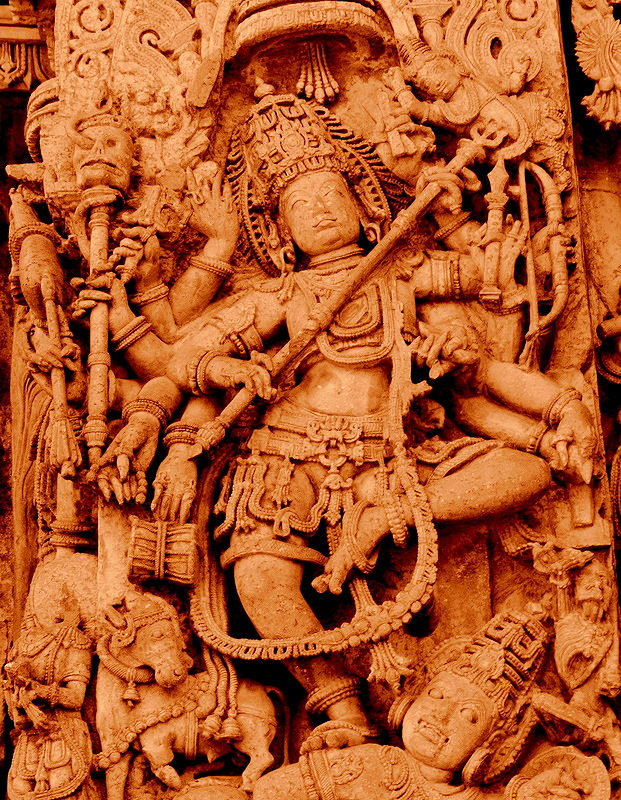
Abb.: Naṭarājā, Halebidu (ಹಳೆಬೀಡು),
Karnataka
[Bildquelle: soham_pablo. --
http://www.flickr.com/photos/75879414@N00/2894536141. -- Zugriff am
2010-07-03. --
Creative Commons Lizenz (Namensnennung)]
Siehe auch:
Amarasiṃha <6./8. Jhdt. n. Chr.>: Nāmaliṅgānuśāsana (Amarakośa) / übersetzt von Alois Payer <1944 - >. -- 1. Prathamam kāṇḍam. -- 1. svargavargaḥ. -- Anhang 1: Jogendra Nath Bhattacharya [যোগেন্দ্রনাথ ভট্টাচার্য্য] über Śaivas (1896). -- Fassung vom 2017-05-08. -- URL: http://www.payer.de/amarakosa/amara101Anhang1.htm
37. kapardo 'sya jaṭājūṭaḥ pināko 'jagavaṃ dhanuḥ
pramathā: syuḥ pāriṣadā brāhmītyādyās tu mātaraḥ
38 a./b. vibhūtir bhūtir aiśvaryam aṇimādikam aṣṭadhā
कपर्दो
ऽस्य
जटाजूटः पिनाको
ऽजगवं
धनुः ।
प्रमथाः स्युः पारिषदा ब्राह्मीत्याद्यास् तु मातरः ॥३७॥
विभूतिर् भूतिर् ऐश्वर्यम् अणिमादिकम् अष्टधा ।३८ क्।
[Bezeichnungen für Śivas Macht sind:]
Diese Macht ist achtfach und besteht aus aṇimā usw.4
Erläuterungen:
1 Ajagava - अजगव n.: Ajagava
"AJAGAVA. The primitive bow of Śiva, which fell from heaven at the birth of Pṛthu."
[Quelle: Dowson, John <1820-1881>: A classical dictionary of Hindu mythology and religion, geography, history, and literature. -- London, Trübner, 1879. -- s.v.]
2 sein Gesinde sind die Pramatha - प्रमथ m.
"PRAMATHAS. A class of demi-gods or fiends attendant upon Śiva."
[Quelle: Dowson, John <1820-1881>: A classical dictionary of Hindu mythology and religion, geography, history, and literature. -- London, Trübner, 1879. -- s.v.]
3 seine 'Mütter' sind Brāhmī - ब्राह्मी f. und die übrigen
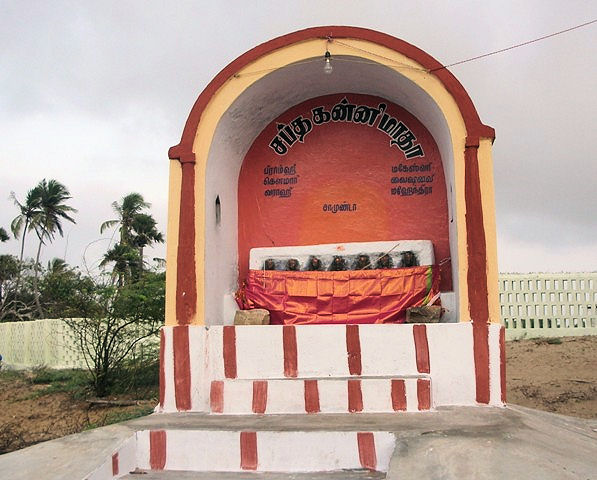
Abb.: Schrein für die sieben Mütter (saptamātṛkā), Ramanathapuram district (இராமநாதபுரம்
மாவட்டம்), Tamil Nadu
[Bildquelle: Mohonu / Wikipedia. -- Public domain]
Jātarūpa nennt als die sieben Mütter: Brāmaṇī, Vaiṣṇavī, Aindrī, Vārāhī, Kauverī, Raudrī, Kaumārī
"MĀTṚS. 'Mothers'. The divine mothers. These appear to have been originally the female energies of the great gods, as Brāhmaṇī of Brahmā, Maheśvarī of Śiva, Vaiṣṇavī of Viṣṇu, Indrāṇī or Aindrī of Indra, &c. The number of them was seven or eight or sixteen, but in the later mythology they have increased out of number. They are connected with the Tantra worship, and are represented as worshipping Śiva and attending upon his son Kārtikeya."
[Quelle: Dowson, John <1820-1881>: A classical dictionary of Hindu mythology and religion, geography, history, and literature. -- London, Trübner, 1879. -- s.v.]
4 Diese Macht ist achtfach und besteht aus aṇimā usw.
Hier haben manche Ausgaben den Vers eingeschoben:
aṇimā mahimā caiva garimā laghimā tathā
prāptiḥ prākāmyam īśitvaṃ vaśitvaṃ cāṣṭa siddhayaḥअणिमा महिमा चैव गरिमा लघिमा तथा ।
प्राप्तिः प्राकाम्यम् ईशित्वं वशित्वं चाष्ट सिद्धयः ॥Die acht übernatürlichen Fähigkeiten sind
- अणिमा : die Fähigkeit, sich unendlich klein zu machen
- महिमा : die Fähigkeit, sich unendlich groß zu machen
- गरिमा : die Fähigkeit, sich unendlich schwer zu machen
- लघिमा : die Fähigkeit, sich unendlich leicht zu machen
- प्राप्ति : die Fähigkeit, überall hin zu kommen
- प्राकाम्य : die Fähigkeit, zu realisieren, was immer man wünscht
- ईशित्व : absolute Herrschaft
- वशित्व : die Fähigkeit, allem seinen Willen aufzuzwingen
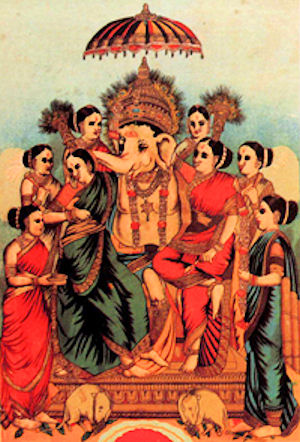
Abb.: Raja Ravi Varma (രാജാ രവി വര്മ)
<1848 - 1906>: Gaṇeśa mit den acht Siddhis
[Bildquelle: Wikipedia. -- Public domain.]
38. c./d. umā kātyāyanī gaurī kālī haimavatīśvarī
39. śivā bhavānī rudrāṇī śarvāṇī sarvamaṅgalā
aparṇā pārvatī durgā mṛḍānī caṇḍikāmbikā
40 a./b. āryā dākṣāyaṇī caiva girijā menakātmajā
उमा कात्यायनी गौरी काली हैमवतीश्वरी ॥३८ ख्॥
शिवा भवानी रुद्राणी शर्वाणी सर्वमङ्गला ।
अपर्णा पार्वती दुर्गा मृडानी चण्डिकाम्बिका ॥३९॥
आर्या दाक्षायनी चौव गिरिजा
मेनकात्मजा ।४० क्।
[Bezeichnungen für Pārvatī1 sind:]
Erläuterungen:
1 Pārvatī - पार्वती f.: Tochter des Berges (Himālaya), Pārvatī
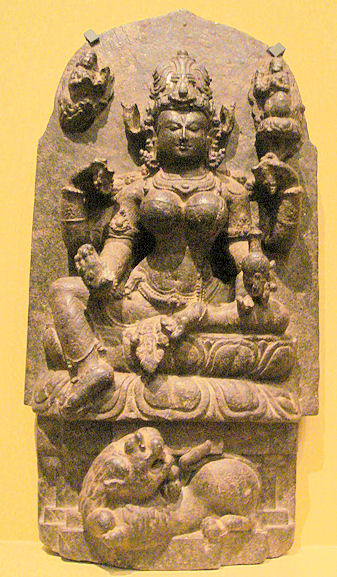
Abb.: Pārvatī, Orissa, 12. Jhdt. n. Chr.
[Bildquelle: Wikipedia Loves Art
participant "ARTiFACTS". --
Creative Commons
Lizenz (Namensnennung, share alike)]
"DEVĪ. 'The goddess', or Mahā-devī, 'the great goddess', wife of the god Śiva, and daughter of Himavat, i.e., the Himālaya mountains. She is mentioned in the Mahā-bhārata under a variety of names, and with several of her peculiar characteristics, but she owes her great distinction to the Purāṇas and later works. As the Śakti or female energy of Śiva she has two characters, one mild, the other fierce; and it is under the latter that she is especially worshipped. She has a great variety of names, referable to her various forms, attributes, and actions, but these names are not always used accurately and distinctively. In he milder form she is Umā, 'light', and a type of beauty ; Gaurī, 'the yellow or brilliant' ; Pārvatī, 'the mountaineer' ; and Haimavatī, from her parentage ; Jagan-mātā, the mother of the world ; and Bhavānī. In her terrible form she is Durgā, 'the inaccessible' ; Kālī and Śyāma, 'the black' ; Caṇḍī and Caṇḍikā, 'the fierce'; and Bhairavī, the terrible. It is in this character that bloody sacrifices are offered to her, that the barbarities of the Durgā-pūjā and Carak-pūjā are perpetrated in her honour, and that the indecent orgies of the Tāntrikas are held to propitiate her favours and celebrate her powers. She has ten arms, and in most of her hands there are weapons. As Durgā she is a beautiful yellow woman, riding on a tiger in a fierce and menacing attitude. As Kālī or Kālikā, 'the black', "she is represented with a black skin, a hideous and terrible countenance, dripping with blood, encircled with snakes, hung round with skulls and human heads, and in all respects resembling a fury rather than a goddess." As Vindhya-vāsinī, 'the dweller in the Vindhyas', she is worshipped at a place of that name where the Vindhyas approach the Ganges, near Mirzapur, and it is said that there the blood before her image is never allowed to get dry. As Mahā-māyā she is the great illusion.
The Caṇḍī-mahātmya, which celebrates the victories of this goddess over the Asuras, speaks of her under the following names :
Durgā, when she received the messengers of the Asuras.
Daśa-bhujā. 'Ten-armed', when she destroyed part of their army.
Siṃha-vāhinī. 'Riding on a lion', when she fought with the Asura general Rakta-vīja.
Mahiṣa-mardinī. 'Destroyer of Mahiṣa', an Asura in the form of a buffalo.
Jagad-dhātṛ. 'Fosterer of the world', when she again defeated the Asura army.
Kālī. 'The black'. She killed Rakta-vīja.
Mukta-keśī. 'With dishevelled hair'. Again defeats the Asuras.
Tārā. 'Star'. She killed Kumbha.
Chinna-mastakā. 'Decapitated', the headless form in which she killed Niśumbha.
Jagad-gaurī. 'World's fair one', as lauded by the gods for her triumphs.
The names which Devī obtains from her husband are : Babhravī (Babhru), Bhagavatī, Īśānī, Īśvarī, Kālañjarī, Kapālinī, Kauśikī, Kirātī, Maheśvarī, Mṛḍā, Mṛḍānī, Rudrāṇī, Śarvāṇī, Śivā, Tryambakī.
From her origin she is called Adri-jā and Giri-jā, 'mountain-born' ; Ku-jā, 'earth-born' ; 'Dakṣa-jā', 'sprung from Dakṣa'.
She is Kanyā, 'the virgin' ; Kanyā-kumārī, 'the youthful virgin'; and Ambikā, 'the mother' ; Avarā, 'the youngest' ; Anantā and Nityā, 'the ever lasting'; Āryā, 'the revered'; Vijayā, 'victorious'; Ṛddhi, 'the rich' ; Satī, 'virtuous' ; Dakṣiṇā, 'right-handed' ; Piṅgā, 'tawny, dark' ; Karburī, 'spotted' ; Bhramarī, 'the bee' ; Koṭarī, 'the naked' ; Karṇa-motī, 'pearl-eared' ; Padma-lāñchanā, 'distinguished by a lotus' ; Sarva-maṅgalā, 'always auspicious' ; Śākam-bharī, 'nourisher of herbs' ; Śiva-dūtī, 'Śiva's messenger'; Siṃha-rathī, 'riding on a lion'.
As addicted to austerities she is Aparṇā and Kātyāyanī.
As Bhūta-nāyakī she is chief or leader of the goblins, and as Gaṇa-nāyakī, the leader of the Gaṇas.
She is Kāmākṣī, 'wanton-eyed'; and Kāmākhyā, 'called by the name of Kāma', desire.
Other names, most of them applicable to her terrible forms, are Bhadra-kālī, Bhīma-devī, Cāmuṇḍā, Mahā-kālī, Mahāmārī, Mahāsurī, Mātaṅgī, Rajasī, 'the fierce'; and Rakta-dantī, 'red or bloody toothed'."
[Quelle: Dowson, John <1820-1881>: A classical dictionary of Hindu mythology and religion, geography, history, and literature. -- London, Trübner, 1879. -- s.v.]
2 Umā - उमा f.: Umā
"UMĀ. 'Light'. A name of the consort of Śiva. The earliest known mention of the name is in the Kena Upaniṣad, where she appears as a mediatrix between Brahmā and the other gods, and seems to be identified with Vāc. See Devī."
[Quelle: Dowson, John <1820-1881>: A classical dictionary of Hindu mythology and religion, geography, history, and literature. -- London, Trübner, 1879. -- s.v.]
3 Gaurī - गौरी f.: die rötlich Glänzende, Gaurī
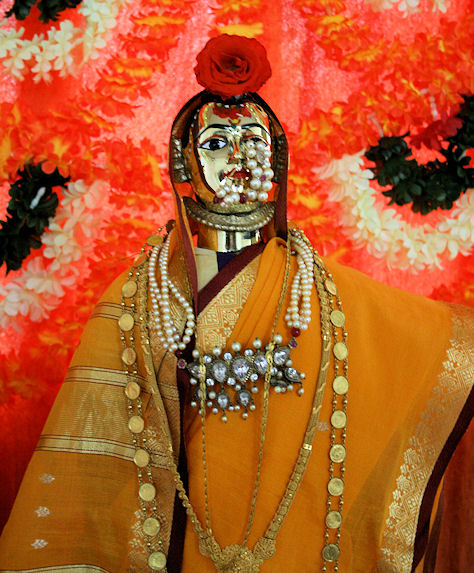
Abb.: Gaurī, Nasik (नाशिक), Masharashtra
[Bildquelle: dhan911. --
http://www.flickr.com/photos/dhan/1449799489/in/set-72157602188684535/. --
Zugriff am 2010-07-03. --
Creative Commons
Lizenz (Namensnennung, share alike)]
4 Kālī - काली f.: die Schwarze, Kālī
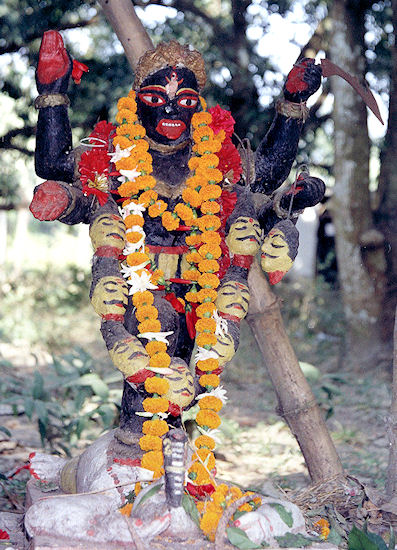
Abb.: Kālī, Westbengalen
[Bildquelle: Christina Kundu / Wikipedia. -- Public domain]
5 Bhavānī - भवानी f.: Bhavānī, Gattin des Bhava (Śiva)
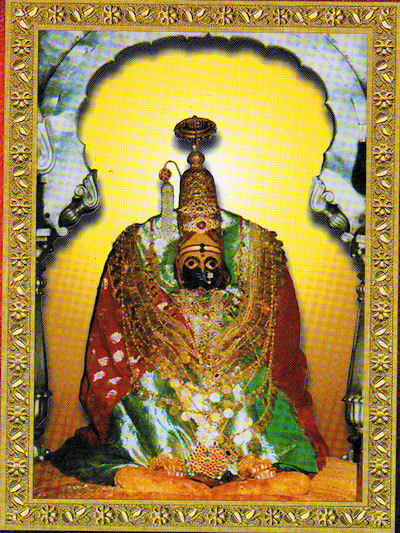
Abb.: Bhavānī, Tuljapur (तुळजापूर), Maharashtra
[Bildquelle: Vishal Prakash Dudhane / Wikipedia. -- GNU
FDLicense]
7 Aparṇā - अपर्णा f.: Blattlose
"APARṆĀ. According to the Hari-vaṃśa, the eldest daughter of Himavat and Menā. She and her two sisters, Eka-parṇā and Eka-pāṭala, gave themselves up to austerity and practised extraordinary abstinence ; but while her sisters lived, as their names denote, upon one leaf or on one pāṭala (Bignonia) respectively, A-parṇā managed to subsist upon nothing, and even lived without a leaf (a-parṇa). This so distressed her mother that she cried out in deprecation, U-mā, 'Oh, don't!' Aparṇā thus became the beautiful Umā, the wife of Śiva."
[Quelle: Dowson, John <1820-1881>: A classical dictionary of Hindu mythology and religion, geography, history, and literature. -- London, Trübner, 1879. -- s.v.]
8 Durgā - दुर्गा f.: schwer Zugängliche, Durgā
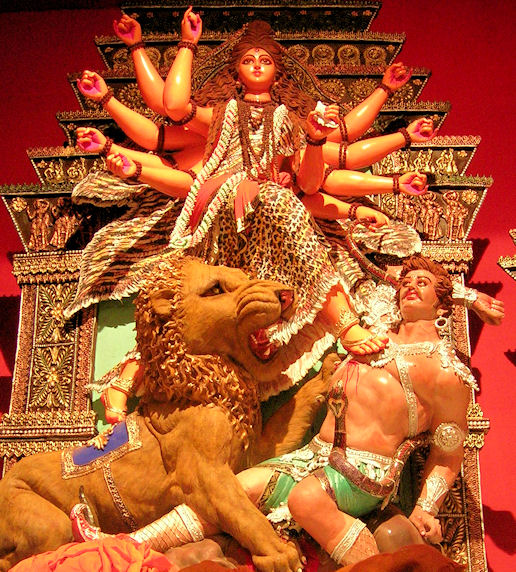
Abb.: Durgā, Kolkata
[Bildquelle: Mukerjee / Wikimedia commons. -- Public domain]
9 Caṇḍikā - चण्डिका f.: die Zornige, Caṇḍikā
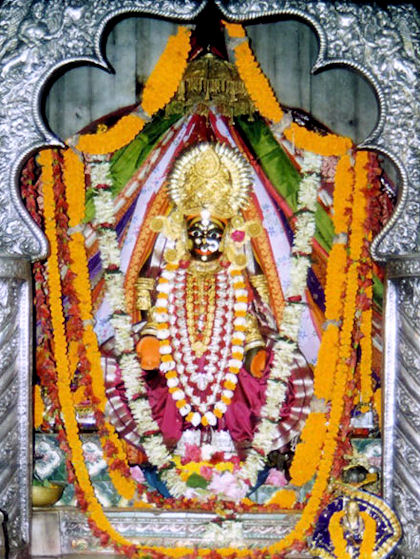
Abb.: Caṇḍikā, Cuttack (କଟକ), Orissa
[Bildquelle: Sankarrukku / Wikipedia. -- GNU FDLicense]
"CAṆḌĀ, CAṆḌĪ. The goddess Durgā, especially in the form she assumed for the destruction of the Asura called Mahiṣa."
[Quelle: Dowson, John <1820-1881>: A classical dictionary of Hindu mythology and religion, geography, history, and literature. -- London, Trübner, 1879. -- s.v.]
10 Menakātmajā - मेनकात्मजा f.: Tochter der Menakā
"MENĀ, MENAKĀ. In the Ṛg-veda, a daughter of Vṛṣan-aśvaa. A Brāhmaṇa tells a strange story of Indra having assumed the form of Menā and then fallen in love with her. In the Purāṇas, wife of Himavat and mother of Umā and Gaṅgā, and of a son named Mainaka."
[Quelle: Dowson, John <1820-1881>: A classical dictionary of Hindu mythology and religion, geography, history, and literature. -- London, Trübner, 1879. -- s.v.]
Siehe auch:
Amarasiṃha <6./8. Jhdt. n. Chr.>: Nāmaliṅgānuśāsana (Amarakośa) / übersetzt von Alois Payer <1944 - >. -- 1. Prathamam kāṇḍam. -- 1. svargavargaḥ. -- Anhang 2: Jogendra Nath Bhattacharya [যোগেন্দ্রনাথ ভট্টাচার্য্য] über Śāktas (1896). -- URL: http://www.payer.de/amarakosa/amara101Anhang2.htm
40. c./d. vināyako vighnarāja-dvaimātura-gaṇādhipāḥ
41. a./b. apy ekadanta-heramba-lambodara-gajānanāḥ
विनायको विघ्नराज-द्वैमातुर-गणाधिपाः ॥४० ख्।
अप्य् एकदन्त-हेरम्ब-लम्बोदर-गजाननाः ।४१ क्।
[Bezeichnungen für Gaṇeśa1 sind:]
Erläuterungen:
1 Gaṇeśa - Herr der Scharen (gaṇa)
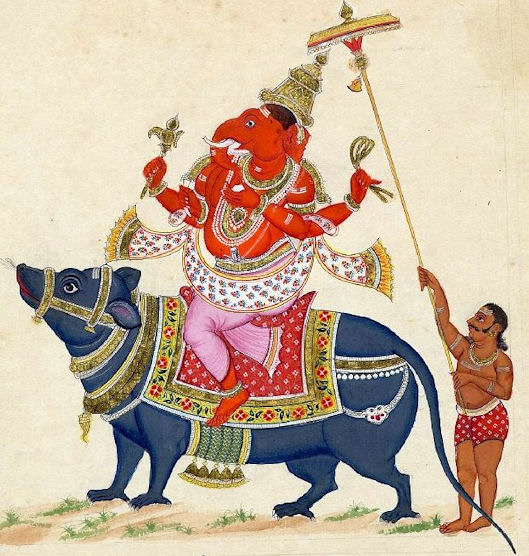
Abb.: Gaṇeśa, Thanjavur (தஞ்சாவூர்), Tamil Nadu, um 1820 n. Chr.
[Bildquelle: Wikimedia. -- Public domain]
"GAṆEŚA (Gaṇa + Īśa), GAṆA-PATI. 'Lord of the Gaṇas' or troops of inferior deities, especially those attendant upon Śiva. Son of Śiva and Pārvatī, or of Pārvatī only. One legend represents that he sprang from the scurf of Pārvatī's body. He is the god of wisdom and remover of obstacles ; hence he is invariably propitiated at the beginning of any important undertaking, and is invoked at the commencement of books. He is said to have written down the Mahā-bhārata from the dictation of Vyāsa. He is represented as a short fat man of a yellow colour, with a protuberant belly, four hands, and the head of an elephant, which has only one tusk. In one hand he holds a shell, in another a discus, in the third a club or goad, and in the fourth a water-lily. Sometimes he is depicted riding upon a rat or attended by one ; hence his appellation Akhu-ratha. His temples are very numerous in the Dakhin. There is a variety of legends accounting for his elephant head. One is that his mother Pārvatī, proud of her offspring, asked Śani (Saturn) to look at him, forgetful of the effects of Śani's glance. Śani looked and the child's head was burnt to ashes. Brahmā told Pārvatī in her distress to replace the head with the first she could find, and that was an elephant's. Another story is that Pārvatī went to her bath and told her son to keep the door. Śiva wished to enter and was opposed, so he cut off Gaṇesa's head. To pacify Pārvatī he replaced it with an elephant's, the first that came to hand. Another version is that his mother formed him so to suit her own fancy, and a further explanation is that Śiva slew Āditya the sun, but restored him to life again. For this violence Kaśapa doomed Śiva's son to lose his head ; and when he did lose it, the head of Indra's elephant was used to replace it. The loss of one tusk is accounted for by a legend which represents Paraśu-rāma as coming to Kailāsa on a visit to Śiva. The god was asleep and Gaṇeśa opposed the entrance of the visitor to the inner apartments. A wrangle ensued, which ended in a fight. Gaṇeśa had at first the advantage, seizing Paraśu-rāma with his trunk and giving him a twirl that left him sick and senseless. On recovering, Paraśu-rāma threw his axe at Gaṇeśa, who, recognising it as his father's weapon (Śiva, having given it to Paraśu-rāma), received it with all humility on one of his tusks, which it immediately severed ; hence Gaṇeśa has but one tusk, and is known by the name of Eka-danta or Eka-daṃṣṭra ('the single-tusked'). These legends are narrated at length in the Brahma Vaivartta Purāṇa.
Gaṇeśa is also called Gajānana, Gaja-vadana, and Kari-mukha, 'elephant-faced'; Heramba; 'boastfu'; Lamba-karṇa, 'long-eared' ; Lambodara, 'pendant - bellied' ; Dvi-deha, 'double-bodied'; Vighneśa, Vighna-hari, 'remover of obstacles'. A peculiar appellation is Dvai-matura, 'having two mothers', in allusion, it is said, to his birth from the scurf of Pārvatī's body."
[Quelle: Dowson, John <1820-1881>: A classical dictionary of Hindu mythology and religion, geography, history, and literature. -- London, Trübner, 1879. -- s.v.]
2 Vināyaka -विनायक m.: Führer
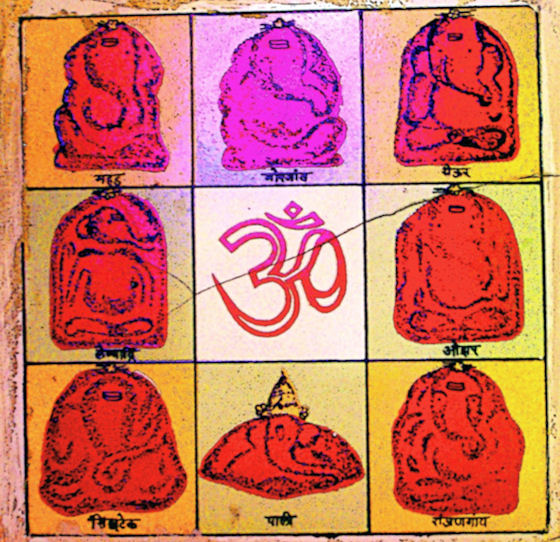
Abb.: Aṣṭa-vināyaka-yantra, Pune (पुणे)
[Bildquelle: Shrimaitreya. --
http://www.flickr.com/photos/47892806@N00/3313664753. -- Zugriff am
2010-07-04. --
Creative Commons Lizenz (Namensnennung)]
3 Gaṇādhipa - गणाधिप m.: Oberherr über die Gaṇas
zu den Gaṇa-devatā siehe oben!
4 Ekadanta - एकदन्त m.: Einzähniger
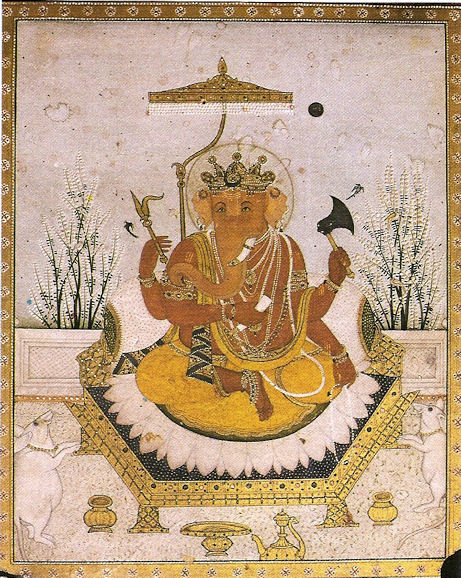
Abb.: Gaṇeśa, Nurpur, ca. 1810 n. Chr.
[Bildquelle: Wikipedia. -- Public domain]
5 Lambodara - लम्बोदर m.: Hängebauch

Abb.: Gaṇeśa, Chola. 13. Jhdt. n. Chr.
[Bildquelle: Jen / Wikipedia. --
Creative Commons
Lizenz (Namensnennung)]
41. c./d. kārtikeyo mahāsenaḥ śarajanmā ṣaḍānanaḥ
42. pārvatīnandanaḥ skandaḥ senānīr agnibhūr guhaḥ
bāhuleyas tārakajid viśākhaḥ śikhivāhanaḥ
43 a./b. ṣāṇmāturaḥ śaktidharaḥ kumāraḥ krauñcadāraṇaḥ
कार्तिकेयो महासेनः शरजन्मा षडाननः ॥४१ ख्॥
पार्वतीनन्दनः स्कन्दः सेनानीर् अग्निभूर् गुहः ।
बाहुलेयस् तारकजिद् विशाखः शिखिवाहनः ॥४२॥
षाण्मातुरः शक्तिधरः कुमारः क्रौञ्चदारणः ॥४३ क्॥
[Bezeichnungen für Kārtrikeya1 sind:]
Erläuterungen:
1 Kārtikeya / Kārttikeya - कार्तिकेय / कार्त्तिकेय m.: (Pflege-)Sohn der Plejaden (Kṛttikā)
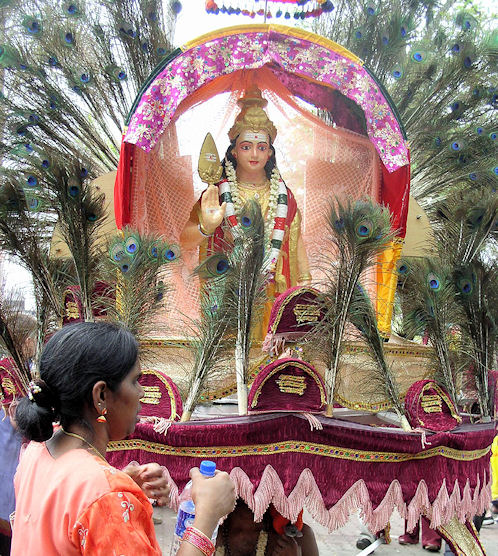
Abb.: Kārtikeya, Malaysia
[Bildquelle: tajai. -- Zugriff am
2010-06-28. --
Creative Commons Lizenz (Namensnennung)]
"KĀRTTIKEYA. The god of war and the planet Mars, also called Skanda. He is said in the Mahā-bhārata and Rāmāyaṇa to be the son of Śiva or Rudra, and to have been produced without the intervention of a woman. Śiva cast his seed into fire, and it was afterwards received by the Ganges : Kārttikeya was the result ; hence he is called Agni-bhū and Gaṅga-ja. He was fostered by the Pleiades (Kṛttikā), and hence he has six heads and the name Kārttikeya. His paternity is some times assigned to Agni (fire) ; Gaṅgā (the Ganges) and Pārvatī are variously represented to be his mother. He was born for the purpose of destroying Tāraka, a Daitya whose austerities had made him formidable to the gods. He is represented riding on a peacock called Paravāṇi, holding a bow in one hand and an arrow in the other. His wife is Kaumarī or Senā.
He has many titles : as a warrior he is called Mahā-sena, Senā-pati ; Siddha-sena, 'leader of the Siddhas' ; and Yudha-raṅga ; also Kumāra, 'the boy' ; Guha, 'the mysterious one' ; Śakti-dhara, 'spear-holder' ; and in the south he is called Su-brahmaṇya. He is Gaṅgā-putra, 'son of the Ganges' ; Śara-bhū, 'born in the thicket' ; Tāraka-jit, 'vanquisher of Tāraka' ; Dvādaśa-kara and Dvādaśākṣa, 'twelve-handed' and 'twelve-eyed' ; Ṛju-kāya, 'straight-bodied'. See Krauñca."
[Quelle: Dowson, John <1820-1881>: A classical dictionary of Hindu mythology and religion, geography, history, and literature. -- London, Trübner, 1879. -- s.v.]
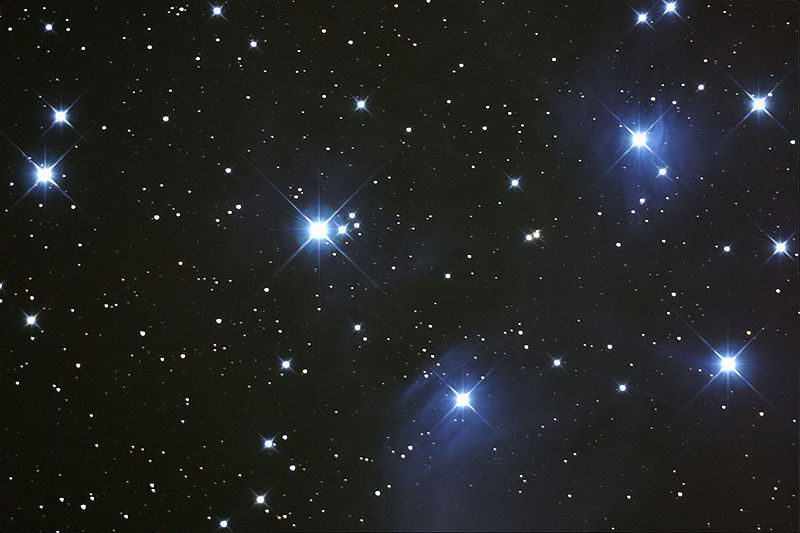
Abb.: Plejaden (Siebengestirn)
[Bildquelle: Rochus Hess / Wikimedia commons. -- Public
domain]
"Da die Plejaden bereits lange vor Erfindung des Teleskops als Sterngruppe bekannt waren, werden traditionell auch oft nur die hellsten Hauptsterne als Plejaden bezeichnet. In manchen Kulturen und historischen Darstellungen werden nur sechs Sterne zu den Plejaden gerechnet. Der Grund dafür ist Pleione, der ein veränderlicher Stern ist. Seine scheinbare Helligkeit schwankt langsam, aber unregelmäßig zwischen der von Taygeta und Celaeno, so dass Pleione manchmal erst dann gesehen wird, wenn Celaeno auch schon erkannt werden kann. Mit bloßem Auge sind daher, je nach Sichtbedingungen, sechs bis neun Sterne zu erkennen."
[Quelle: http://de.wikipedia.org/wiki/Plejaden. -- Zugriff am 2010-07-04]
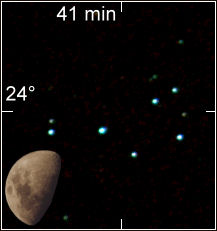
Abb.: Mond und Plejaden im Größenvergleich
[Bildquelle: Anton (rp) Winter / Wikipedia. -- GNU FDLicense]
"KṚTTIKĀS. The Pleiades. The six nurses of Kārttikeya, the god of war. They were daughters of a king according to one legend, wives of Ṛṣis according to another."
[Quelle: Dowson, John <1820-1881>: A classical dictionary of Hindu mythology and religion, geography, history, and literature. -- London, Trübner, 1879. -- s.v.]
2 Ṣaḍānana - षडानन m.: Sechsgesichtriger
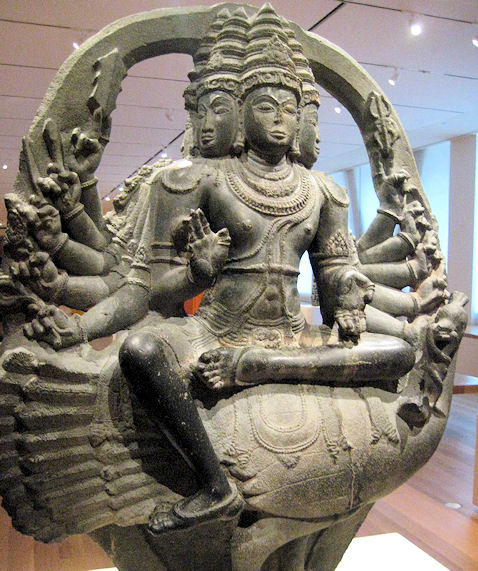
Abb.: Kārttikeya ṣaḍānana, Madanapalle (మదనపల్లె),
Andhra Pradesh, ca. 12. Jhdt n. Chr.
[Bildquelle: unforth. --
http://www.flickr.com/photos/8435962@N06/4224093182. -- Zugriff am
2010-07-04. --
Creative Commons Lizenz (Namensnennung, share alike)]
3 Tārakajit - तारकजित् m.: Besieger des Tāraka
"TĀRAKA. Son of Vajrānaka. A Daitya whose austerities made him formidable to the gods, and for whose destruction Skanda, the god of war, was miraculously born." [Quelle: Dowson, John <1820-1881>: A classical dictionary of Hindu mythology and religion, geography, history, and literature. -- London, Trübner, 1879. -- s.v.]
4 Śikhivāhana - शिखिवाहन m.: der einen Pfau als Gefährt hat
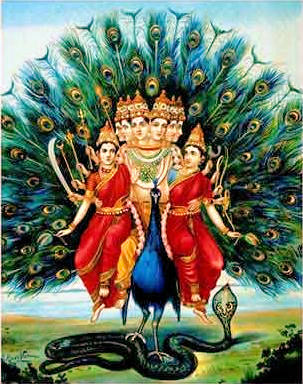
Abb.: Raja Ravi Varma (രാജാ രവി വര്മ)
<1848 - 1906>: Kārttikeya
[Bildquelle: Wikipedia. -- Public domain.]
5 Krauñcadāraṇa - क्रौञ्चदारण m.: der den Krauñca-Pass auseinandergerrissen hat
"KRAUÑCA. A pass situated somewhere in the Himālayas, said to have been opened by Paraśu-rāma with his arrows to make a passage from Kailāsa to the southwards. The Vāyu Purāṇa attributes the splitting of the mountain to Kārttikeya. Indra and Kārttikeya had a dispute about their respective powers, and agreed to decide it by running a race round the mountain. They disagreed as to the result, and therefore appealed to the mountain, who untruly decided in favour of Indra. "Karttikeya hurled his lance at the mountain and pierced at once it and the demon Mahiṣa."" [Quelle: Dowson, John <1820-1881>: A classical dictionary of Hindu mythology and religion, geography, history, and literature. -- London, Trübner, 1879. -- s.v.]
43. c./d. śṛṅgī bhṛṅgī riṭis tuṇḍī nandiko nandikeśvaraḥ
शृङ्गी भृङ्गी रिटिस् तुण्डी नन्दिको नन्दिकेश्वरः ॥४३ ख॥
[Bezeichnungen für Nandin1 sind:]
Erläuterungen:
1 Nandin - नन्दिन् m.: Erfreuender
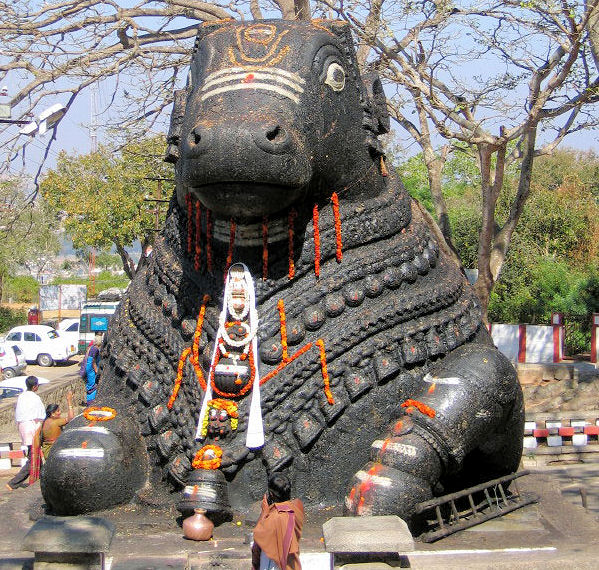
Abb.: Nandin, Chamundi hills bei Mysore (ಮೈಸೂರು)
[Bildquelle: Rohith Ajjampur / Wikipedia.
-- GNU FDLicense]
"NANDĪ. The bull of Śiva. The Vāyu Purāṇa makes him the son of Kaśyapa and Surabhi. His image, of a milky white colour, is always conspicuous before the temples of Śiva. He is the chamberlain of Śiva, chief of his personal attendants (gaṇas), and carries a staff of office. He is guardian of all quadrupeds. He is also called Śālaṅkāyana, and he has the appellations of Nādi-deha and Tāṇḍava-tālika, because he accompanies with music the tāṇḍava dance of his master."
[Quelle: Dowson, John <1820-1881>: A classical dictionary of Hindu mythology and religion, geography, history, and literature. -- London, Trübner, 1879. -- s.v.]
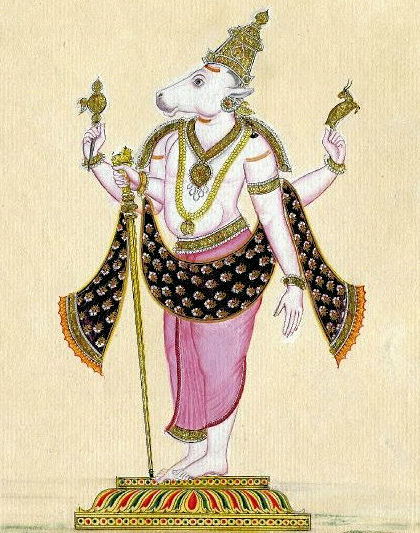
Abb.: Nandī, ca. 1820
[Bildquelle: Wikipedia. -- Public domain]
44. a./b. karmamoṭī tu cāmuṇḍā carmamuṇḍā tu carcikā
कर्ममोटी तु चामुण्डा चर्ममुण्डा तु चर्चिका ।४४ क्।
[Bezeichnungen für Cāmuṇdā1 sind:]
Erläuterungen:
1 Cāmuṇḍā - चामुण्डा f.: Cāmuṇḍā
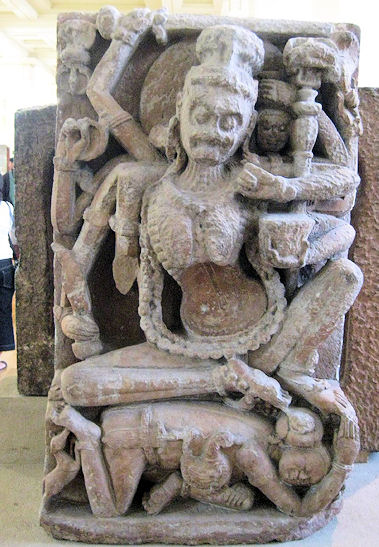
Abb.: Cāmuṇḍā, Orissa, 8./9. Jhdt. n. Chr.
[Bildquelle: unforth. --
http://www.flickr.com/photos/8435962@N06/2686750029. -- Zugriff am
2010-07-04. --
Creative Commons Lizenz (Namensnennung, share alike)]
"CĀMUṆḌĀ. An emanation of the goddess Durgā, sent forth from her forehead to encounter the demons Caṇḍa and Muṇḍa. She is thus described in the Mārkaṇḍeya Purāṇa :
"From the forehead of Ambikā (Durgā), contracted with wrathful frowns, sprang swiftly forth a goddess of black and formidable aspect, armed with a scimitar and noose, bearing a ponderous mace, decorated with a garland of dead corpses, robed in the hide of an elephant, dry and withered and hideous, with yawning mouth, and lolling tongue, and bloodshot eyes, and filling the regions with her shouts." When she had killed the two demons, she bore their heads to Durgā, who told her that she should henceforth be known, by a contraction of their names, as Cāmuṇḍā."
[Quelle: Dowson, John <1820-1881>: A classical dictionary of Hindu mythology and religion, geography, history, and literature. -- London, Trübner, 1879. -- s.v.]
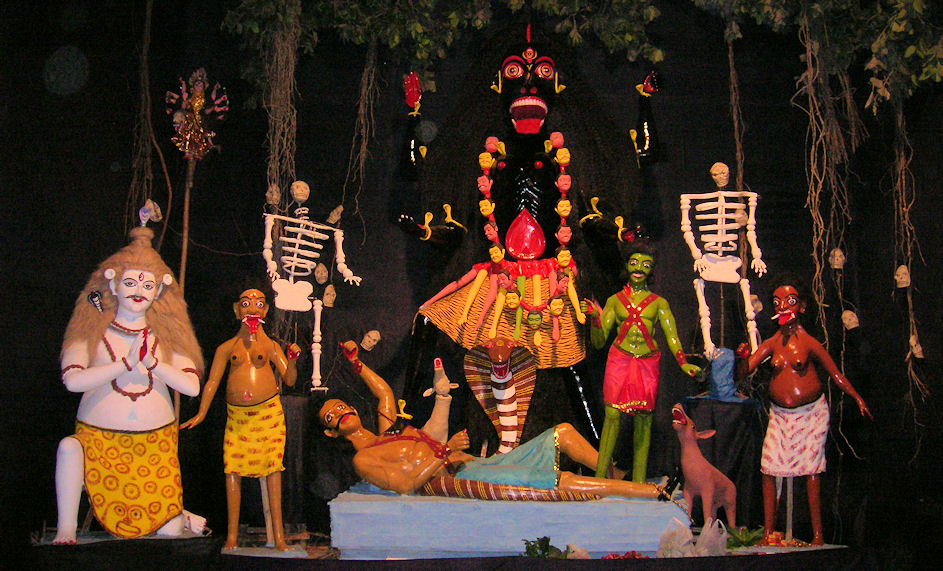
Abb.: Cāmuṇḍā, Alipore (আলিপুর), Westbengalen
[Bildquelle: Jonoikobangali / Wikimedia commons. --
Creative Commons
Lizenz (Namensnennung, share alike)]
44. indro marutvān maghavā biḍaujāḥ pākaśāsanaḥ
vṛddhaśravāḥ sunāsīraḥ puruhūtaḥ purandaraḥ
45. jiṣṇur lekharṣabhaḥ śakraḥ śatamanyur divaspatiḥ
sutrāmā gotrabhid vajrī vāsavo vṛtrahā vṛṣā
46. bāstoṣpatiḥ surapatir balārātiḥ śacīpatiḥ
jambhabhedī harihayaḥ svārāṇ namucisūdanaḥ
47. saṃkrandano duścyavanas turāṣāṇ meghavāhanaḥ
ākhaṇḍalaḥ sahasrākṣa ṛbhukṣās
(tasya tu priyā)
इन्द्रो मरुत्वान् मघवा बिडौजाः पाकशासनः ।
वृद्धश्रवाः सुनासीरः पुरुहूतः पुरन्दरः ॥४४॥
जिष्णुर् लेखर्षभः शक्रः शतमन्युर् दिवस्पतिः ।
सुत्रामा गोत्रभिद् वज्री वासवो वृत्रहा वृषा ॥४५॥
बास्तोष्पतिः सुरपतिर् बलारातिः शचीपतिः ।
जम्भभेदी हरिहयः स्वाराण् नमुचिसूदनः ॥४६॥
संक्रन्दनो दुश्चयवनस् तुराषाण् मेघवाहनः ।
आखण्डलः सहस्राक्ष ऋभुक्षास् तस्य तु प्रिया
॥४७॥
[Bezeichnungen für Indra1 sind:]
Erläuterungen:
1 Indra - इन्द्र m.: Indra (Fürst)
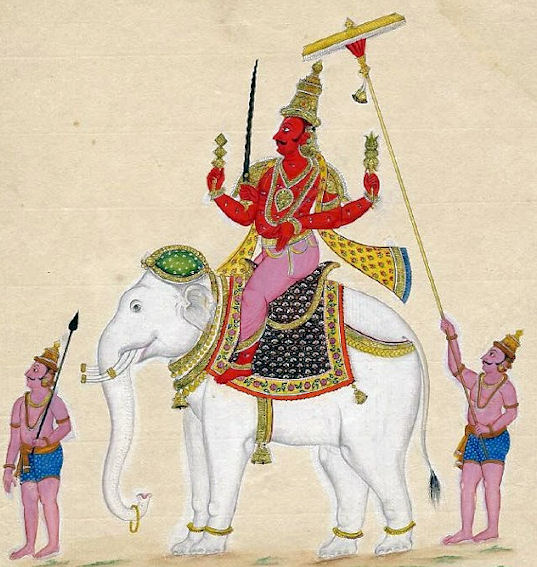
Abb.: Indra, ca. 1820
[Bildquelle: Wikipedia. -- Public domain]
"INDRA. The god of the firmament, the personified atmosphere. In the Vedas he stands in the first rank among the gods, but he is not uncreate, and is represented as having a father and mother : "a vigorous god begot him ; a heroic female brought him forth." He is described as being of a ruddy or golden colour, and as having arms of enormous length ; "but his forms are endless, and he can assume any shape at will." He rides in a bright golden car, drawn by two tawny or ruddy horses with flowing manes and tails. His weapon is the thunderbolt, which he carries in his right hand ; he also uses arrows, a great hook, and a net, in which he is said to entangle his foes. The soma juice is his especial delight; he takes enormous draughts of it, and, stimulated by its exhilarating qualities, he goes forth to war against his foes, and to perform his other duties. As deity of the atmosphere, he governs the weather and dispenses the rain; he sends forth his lightnings and thunder, and he is continually at war with Vṛtra or Ahi, the demon of drought and inclement weather, whom he overcomes with his thunderbolts, and compels to pour down the rain. Strabo describes the Indians as worshipping Jupiter Pluvius, no doubt meaning Indra, and he has also been compared to Jupiter Tonans. One myth is that of his discovering and rescuing the cows of the priests or of the gods, which had been stolen by an Asura named Paṇi or Vala, whom he killed, and he is hence called Vala-bhid. He is frequently represented as destroying the "stone-built cities" of the Asuras or atmospheric demons, and of the Dasyus or aborigines of India. In his warfare he is sometimes represented as escorted by troops of Maruts, and attended by his comrade Viṣṇu. More hymns are addressed to Indra than to any other deity in the Vedas, with the exception of Agni. For he was reverenced in his beneficent character as the bestower of rain and the cause of fertility, and he was feared as the awful ruler of the storm and director of the lightning and thunder. In many places of the Ṛg-veda the highest divine functions and attributes are ascribed to him. There was a triad of gods Agni, Vāyu, and Sūrya which held a pre-eminence above the rest, and Indra frequently took the place of Vāyu. In some parts of the Veda, as Dr. Muir remarks, the ideas expressed of Indra are grand and lofty; at other times he is treated with familiarity, and his devotion to the soma juice is dilated upon, though nothing debasing is perceived in his sensuality. Indra is mentioned as having a wife, and the name of Indrāṇī or Aindrī is invoked among the goddesses. In the Śatapatha Brāhmaṇa she is called Indra's beloved wife.
In the later mythology Indra has fallen into the second rank. He is inferior to the triad, but he is the chief of all the other gods. He is the regent of the atmosphere and of the east quarter of the compass, and he reigns over Svarga, the heaven of the gods and of beatified spirits, which is a region of great magnificence and splendour. He retains many of his Vedic characteristics, and some of them are intensified. He sends the lightning and hurls the thunderbolt, and the rainbow is his bow. He is frequently at war with the Asuras, of whom he lives in constant dread, and by whom he is often worsted. But he slew the demon Vṛtra, who, being regarded as a Brāhman, Indra had to conceal himself and make sacrifice until his guilt was purged away. His continued love for the soma juice is shown by a legend in the Mahā-bhārata, which represents him as being compelled by the sage Cyavana to allow the Aśvins to partake of the soma libations, and his sensuality has now developed into an extreme lasciviousness. Many instances are recorded of his incontinence and adultery, and his example is frequently referred to as an excuse in cases of gallantry, as by King Nahuṣa when he tried to obtain Indra's wife while the latter was hiding in fear for having killed the Brāhman in the person of the demon Vṛtra. According to the Mahā-bāarata he seduced, or endeavoured to seduce, Ahalyā, the wife of the sage Gautama, and that sage's curse impressed upon him a thousand marks resembling the female organ, so he was called Sa-yoni; but these marks were afterwards changed to eyes, and he is hence called Netra-yoni, and Sahasrākṣa 'the thousand-eyed'. In the Rāmāyaṇa it is related that Rāvaṇa, the Rākṣasa king of Laṅkā or Ceylon, warred against Indra in his own heaven, and that Indra was defeated and carried off to Laṅkā by Rāvaṇa's son Megha-nāda, who for this exploit received the title of Indra-jit (q.v.), 'conqueror of Indra'. Brahmā and the gods had to sue for the release of Indra, and to purchase it with the boon of immortality to the victor. Brahmā then told the humiliated god that his defeat was a punishment for the seduction of Ahalyā. The Taittirīya Brāhmaṇa states that he chose Indrāṇī to be his wife in preference to other goddesses because of her voluptuous attractions, and later authorities say that he ravished her, and slew her father, the Daitya Puloman, to escape his curse. Mythologically he was father of Arjuna (q.v.), and for him he cheated Kāma of his divine coat of mail, but gave Kāma in recompense a javelin of deadly effect. His libertine character is also shown by his frequently sending celestial nymphs to excite the passions of holy men, and to beguile them from the potent penances which he dreaded.
In the Purāṇas many stories are told of him, and he appears especially in rivalry with Kṛṣṇa. He incurred the wrath of the choleric sage Dur-vāsas by slighting a garland of flowers which that sage presented to him, and so brought upon himself the curse that his whole dominion should be whelmed in ruin. He was utterly defeated by the Daityas, or rather by their ally, Raja, son of Āyus, and grandson of Purūravas, and he was reduced to such a forlorn condition that he, "the god of a hundred sacrifices," was compelled to beg for a little sacrificial butter. Puffed up by their victory, his conquerors neglected their duties, and so they became the easy prey of Indra, who recovered his dominion. The Bhāgavata Purāṇa represents him as having killed a Brāhman, and of being haunted by that crime, personified as a Cāṇḍālī.
Indra had been an object of worship among the pastoral people of Vraja, but Kṛṣṇa persuaded them to cease this worship. Indra was greatly enraged at this, and sent a deluge of rain to overwhelm them; but Kṛṣṇa lifted up the mountain, Govardhana on his finger to shelter them, and so held it for seven days, till Indra was baffled and rendered homage to Kṛṣṇa. Again, when Kṛṣṇa went to visit Svarga, and was about to carry off the Parijāta tree, Indra resented its removal, and a fierce fight ensued, in which Indra was worsted, and the tree was carried off. Among the deeds of Indra recorded in the Purāṇas is that of the destruction of the offspring of Diti in her womb, and the production there-from of the Maruts (see Diti) ; and there is a story of his cutting off the wings of the mountains with his thunderbolts, because they were refractory and troublesome. Indra is represented as a fair man riding on a white horse or an elephant, and bearing the vajra or thunderbolt in his hand. His son is named Jayanta. Indra is not the object of direct worship, but he receives incidental adoration, and there is a festival kept in his honour called Śakra-dhvajotthāna, 'the raising of the standard of Indra'.
Indra's names are many, as Mahendra, Śakra, Maghavān, Ṛbhukṣa, Vāsava, Arha, Datteya. His epithets or titles also are numerous. He is Vṛtra-han, 'the destroyer of Vṛtra '; Vajra-pāṇi, 'of the thunderbolt hand' ; Megha-vāhana, 'borne upon the clouds' ; Pāka-śāsana, 'the subduer of Pāka' ; Śata-kratu, 'of a hundred sacrifices' ; Deva-pati and Surādhipa, 'chief of the gods '; Divas-pati, 'ruler of the atmosphere' ; Marutvān, 'lord of the winds' ; Svarga-pati, 'lord of paradise' ; Jiṣṇu, 'leader of the celestial host' ; Puran-dara, 'destroyer of cities' ; Ulūka, 'the owl' ; Ugra-dhanvan, 'of the terrible bow', and many others. The heaven of Indra is Svarga; its capital is Amarāvatī; his palace, Vaijayanta ; his garden, Nandana, Kandasāra, or Paruṣya ; his elephant is Airavata; his horse, Uccaiḥ-śravas ; his chariot, Vimāna ; his charioteer, Mātali ; his bow, the rainbow, Śakradhanus ; and his sword, Paran-ja."
[Quelle: Dowson, John <1820-1881>: A classical dictionary of Hindu mythology and religion, geography, history, and literature. -- London, Trübner, 1879. -- s.v.]
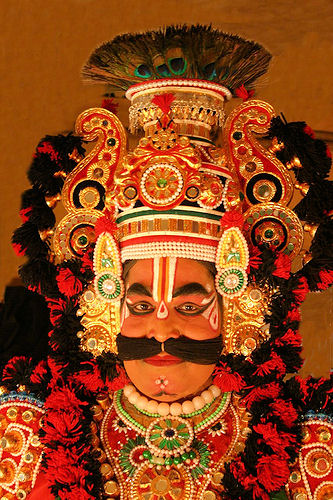
Abb.: Indra, dargestellt im Yakshagana (ಯಕ್ಷಗಾನ),
Karnataka
[Bildquelle: Manohara Upadhya / Wikipedia. -- GNU FDLicense]
2 Marutvant - मरुत्वन्त् m.: von den Sturmgöttern (marut) Begleiteter
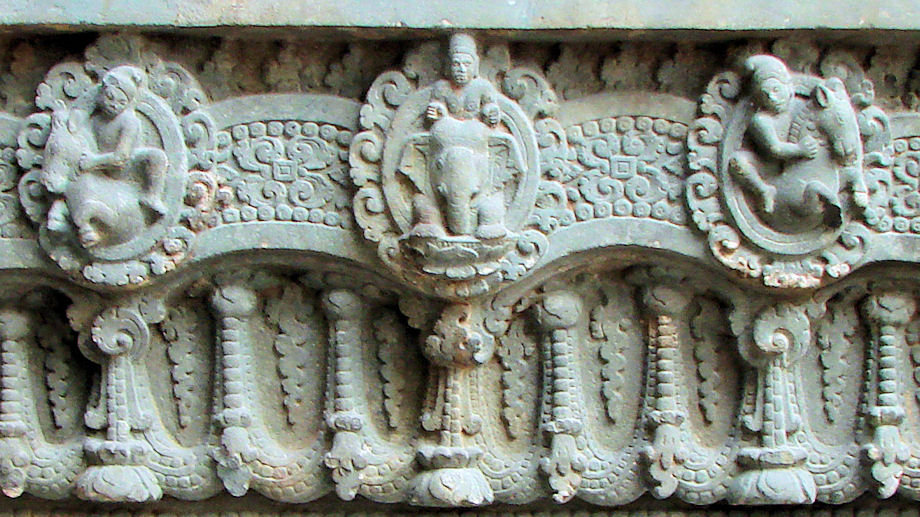
Abb.: Indra mit Maruts, Sambor Prei Kuk, Kampong Thom (កំពង់ធំ),
Kambodscha, 7. Jhdt. n. Chr.
[Bildquelle: Vassil / Wikimedia commons. -- Public domain]
3 Vajrin - वज्रिन् m.: Donnerkeil-Besitzer
"VAJRA. The thunderbolt of Indra, said to have been made of the bones of the Ṛṣi Dadhīci. It is a circular weapon, with a hole in the centre, according to some, but others represent it as consisting of two transverse bars. It has many names: Aśani, Abhrottha, 'sky-born'; Bahu-dāra, much 'cleaving'; Bhidira or Chidaka, 'the splitter'; Dambholi and Jasuri, 'destructive'; Hrādin, 'roaring'; Kuliśa, 'axe'; Pavi, 'pointed'; Phena-vāhin, 'foam-bearing'; Ṣaṭ-kona, 'hexagon' ; Śambha and Svaru."
[Quelle: Dowson, John <1820-1881>: A classical dictionary of Hindu mythology and religion, geography, history, and literature. -- London, Trübner, 1879. -- s.v.]
4 Vāsava - वासव m.: zu den Vasus gehörig
"Vasu. The Vasus are a class of deities, eight in number, chiefly known as attendants upon Indra. They seem to have been in Vedic times personifications of natural phenomena. They are
- Āpa (water)
- Dhruva (pole-star)
- Soma (moon)
- Dhara (earth)
- Anila (wind)
- Anala (fire)
- Prabhāsa (dawn), and
- Pratyuṣa (light).
According to the Rāmāyana they were children of Aditi."
[Quelle: Dowson, John <1820-1881>: A classical dictionary of Hindu mythology and religion, geography, history, and literature. -- London, Trübner, 1879. -- s.v. ]
5 Vṛtrahan - वृत्रहन m.: Töter des Vṛtra
"VṚTRA. In the Vedas he is the demon of drought and ungenial weather, with whom Indra, the god of the firmament, is constantly at war, and whom he is constantly overpowering, and releasing the rain. Sometimes called Vṛtrāsura."
[Quelle: Dowson, John <1820-1881>: A classical dictionary of Hindu mythology and religion, geography, history, and literature. -- London, Trübner, 1879. -- s.v. ]
6 Vāstoṣpati - बास्तोष्पति m.: Herr des Haushalts
"VASTOṢ-PATI. 'House protector'. One of the later gods of the Veda, represented as springing from Brahmā's dalliance with his daughter. He was the protector of sacred rites and guardian of houses."
[Quelle: Dowson, John <1820-1881>: A classical dictionary of Hindu mythology and religion, geography, history, and literature. -- London, Trübner, 1879. -- s.v. ]
7 Jambhabhedin - जम्भभेदिन् m.: Zerspalter des Jambha
"JAMBHA. Name of several demons. Of one who fought against the gods and was slain by Indra, who for this deed was called Jambha-bhedin. Also of one who fought against Arjuna and was killed by Kṛṣṇa."
[Quelle: Dowson, John <1820-1881>: A classical dictionary of Hindu mythology and religion, geography, history, and literature. -- London, Trübner, 1879. -- s.v. ]
8 Namucisūdana - नमुचिसूदन m.: Vernichter des Namuci
"NAMUCI. A demon slain by Indra with the foam of water. The legend of Namuci first appears in the Ṛg-veda, where it is said that Indra ground "the head of the slave Namuci like a sounding and rolling cloud," but it is amplified by the commentator and also in the Śatapatha Brāhmaṇa and Mahā-bhārata. When Indra conquered the Asuras there was one Namuci who resisted so strongly that he overpowered Indra and held him. Namuci offered to let Indra go on promise not to kill him by day or by night, with wet or with dry. Indra gave the promise and was released, but he cut off Namuci's head at twilight, between day and night, and with foam of water, which was, according to the authorities, neither wet nor dry. The Mahā-bh|rata adds that the dissevered head followed Indra calling out 'wicked slayer of thy friend.'"
[Quelle: Dowson, John <1820-1881>: A classical dictionary of Hindu mythology and religion, geography, history, and literature. -- London, Trübner, 1879. -- s.v. ]
9 Ṛbhukṣin - ऋभुक्षिन् m.: der erste der Ṛbhu
Die einheimischen Grammatiker setzen den Stamm als ṛbhikṣin an, der aber unregelmäßig dekliniert wird: z.B. Nom. sg. ṛbhukṣās.
"ṚBHUS. Three sons of Su-dhanvan, a descendant of Aṅgiras, severally named Ṛbhu, Vibhu, and Vāja. Through their assiduous performance of good works they obtained divinity, exercised superhuman powers, and became entitled to receive praise and adoration. They are supposed to dwell in the solar sphere, and there is an indistinct identification of them with the rays of the sun ; but, whether typical or not, they prove the admission, at an early date, of the doctrine that men might become divinities. - Wilson.. They are celebrated in the Ṛg-veda as skilful workmen, who fashioned Indra's chariot and horses, and made their parents young again. By command of the gods, and with a promise of exaltation to divine honours, they made a single new sacrificial cup into four. They are also spoken of as supporters of the sky."
[Quelle: Dowson, John <1820-1881>: A classical dictionary of Hindu mythology and religion, geography, history, and literature. -- London, Trübner, 1879. -- s.v. ]
47. d. (ākhaṇḍalaḥ sahasrākṣa ṛbhukṣās) tasya tu priyā
48.
pulomajā śacīndrāṇī nagarī tv amarāvatī
haya uccaiḥśravā sūto mātalir nandanaṃ vanam
49. syāt prāsādo vaijayanto jayantaḥ pākaśāsaniḥ
airāvato 'bhramātaṅgairāvaṇābhramuvallabhāḥ
50. hrādinī vajram astrī syāt kuliśaṃ bhiduraṃ paviḥ
śatakoṭiḥ svaruḥ śambo dambholir aśanir dvayoḥ
आखन्दलः सहस्राक्ष ऋभुक्षास्
तस्य तु प्रिया ॥४७ ख्॥
पुलोमजा शचीन्द्राणी नगरी त्व् अमरावती ।
हय उच्चैःश्रवा सूतो मातलिर् नन्दनम् वनम् ॥४८॥
स्यात् प्रसादो वैजयन्तो जयन्तः पाकशासनिः ।
ऐरावतो
ऽभ्रमातङ्गैरावणाभ्रमुवल्लभाः
॥४९॥
ह्रादिनी वज्रम् अस्त्री स्यात् कुलिशं भिदुरं पविः ।
शतकोटिः स्वरुः शम्बो दम्भोलिर् अशनिर् द्वयोः ॥५०॥
Seine (Indras) Geliebte heißt
Seine Stadt heißt अमरावती f.: Amarāvatī ("Stadt der Unsterblichen")4.
Sein Pferd heißt उच्चैःश्रवस् m.: Uccaiḥ-śravas ("der mit den erhobenen Ohren", "laut Schreiender") 5.
Sein Wagenlenker heißt मातलि m.: Mātali.
Sein Wald heißt नन्दन n.: Nandana ("Freude")6.
Sein Palast heißt
[Sein Elefant heißt:]
Sein Donnerkeil / seine Wurfscheibe (vajra)8 heißt:
Erläuterungen:
1 Pulomajā - पुलोमजा f.: Tochter des Puloman
"PULOMAN. A Dānava and father of Śacī, wife of Indra. He was killed by Indra when he wished to curse that deity for having ravished his daughter."
[Quelle: Dowson, John <1820-1881>: A classical dictionary of Hindu mythology and religion, geography, history, and literature. -- London, Trübner, 1879. -- s.v. ]
2 Śacī - शची f.: Śacī ('hilfreiche Kraft')
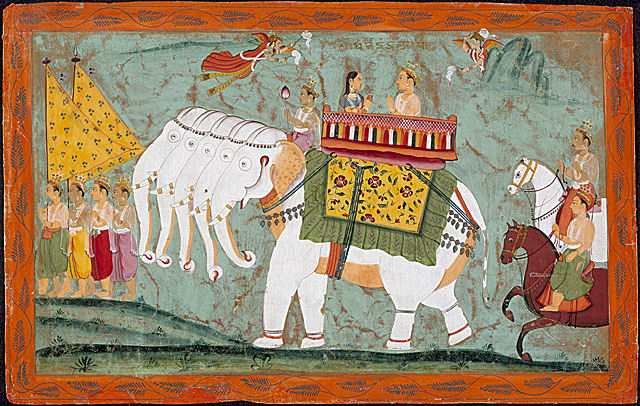
Abb.: Indra und Śacī auf Airāvata, ca. 1670-1680 n. Chr.
[Bildquelle: Wikipedia. -- Public domain]
3 Indrāṇī - इन्द्राणी f.: Indrāṇī ('Gattin des Indra')
"INDRĀṆĪ. Wife of Indra, and mother of Jayanta and Jayantī She is also called Śacī and Aindrī. She is mentioned a few times in the Ṛg-veda, and is said to be the most fortunate of females, "for her husband shall never die of old age."" The Taittirīya Brāhmaṇa states that Indra chose her for his wife from a number of competing goddesses, because she surpassed them all in voluptuous attractions. In the Rāmāyaṇa and Purāṇas she appears as the daughter of the Daitya Puloman, from whom she has the patronymic Paulomī. She was ravished by Indra, who killed her father to escape his curse. According to the Mahā-bhārata, King Nahuṣa became enamoured of her, and she escaped from him with difficulty. Indrāṇī has never been held in very high esteem as a goddess."
[Quelle: Dowson, John <1820-1881>: A classical dictionary of Hindu mythology and religion, geography, history, and literature. -- London, Trübner, 1879. -- s.v. ]
4 Amarāvatī अमरावती f.: Amarāvatī ("Stadt der Unsterblichen")
"AMARĀVATĪ. The capital of Indra's heaven, renowned for its greatness and splendour. It is situated somewhere in the vicinity of Meru. It is sometimes called Deva-pura, 'city of the gods', and Pūṣa-bhāsā, 'sun-splendour'."
[Quelle: Dowson, John <1820-1881>: A classical dictionary of Hindu mythology and religion, geography, history, and literature. -- London, Trübner, 1879. -- s.v. ]
5 Uccaiḥ-śravas - उच्चैःश्रवस् m.: Uccaiḥ-śravas ("der mit den erhobenen Ohren", "laut Schreiender")
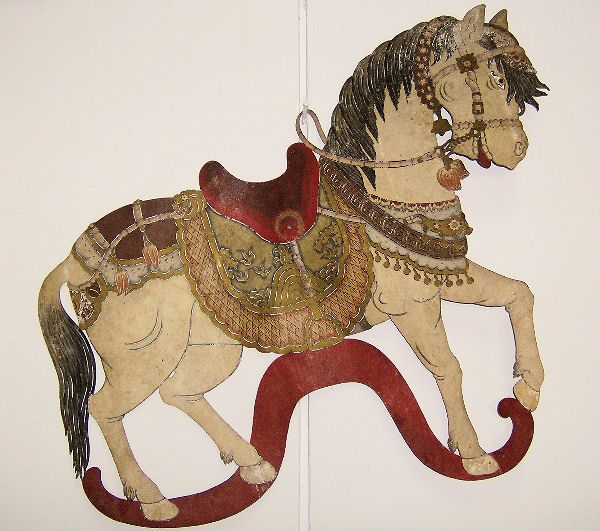
Abb.: Uccaiḥśravas, Schattenspielfigur
[Bildquelle: Meursault2004 / Wikipedia. -- GNU FDLicense]
"UCCAIḤ-ŚRAVAS. The model horse. The white horse of Indra, produced at the churning of the ocean. It is fed on ambrosia, and is held to be the king of horses." [Quelle: Dowson, John <1820-1881>: A classical dictionary of Hindu mythology and religion, geography, history, and literature. -- London, Trübner, 1879. -- s.v. ]
6 Nandana - नन्दन n.: Nandana ("Freude")
"NANDANA. The grove of Indra, lying to the north of Meru." [Quelle: Dowson, John <1820-1881>: A classical dictionary of Hindu mythology and religion, geography, history, and literature. -- London, Trübner, 1879. -- s.v. ]
7 Airāvata - ऐरावत m.: Airāvata
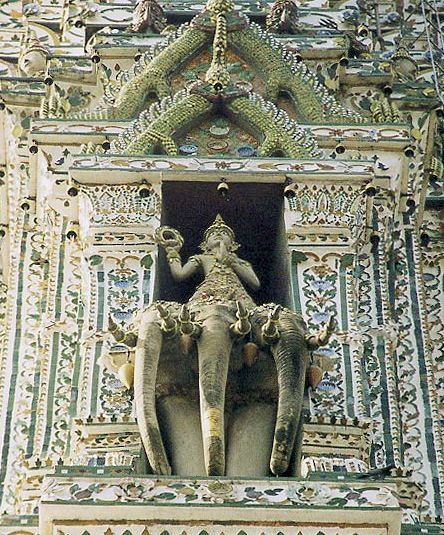
Abb.: Indra auf Airāvata, Wat Arun (วัดอรุณ),
Bangkok, Thailand
[Bildquelle: Manfred Werner / Wikimedia commons. -- GNU FDLicense]
"AIRĀVATA. 'A fine elephant'. An elephant produced at the churning of the ocean, and appropriated by the god Indra. The derivation of this name is referred to the word Irāvat, signifying produced from water. He is guardian of one of the points of the compass. See Loka-pāla."
[Quelle: Dowson, John <1820-1881>: A classical dictionary of Hindu mythology and religion, geography, history, and literature. -- London, Trübner, 1879. -- s.v. ]
8 Vajra - वज्र m., n.: Donnerkeil / Wurfscheibe
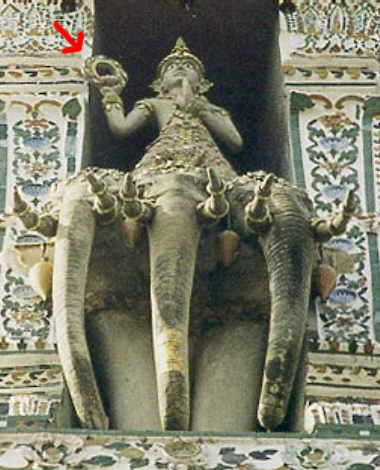
Abb.: Vajra, Wat Arun (วัดอรุณ),
Bangkok, Thailand
[Bildquelle: Manfred Werner / Wikimedia commons. -- GNU FDLicense]
"VAJRA. The thunderbolt of Indra, said to have been made of the bones of the Ṛṣi Dadhīci. It is a circular weapon, with a hole in the centre, according to some, but others represent it as consisting of two transverse bars. It has many names: Aśani, Abhrottha, 'sky-born'; Bahu-dāra, much 'cleaving'; Bhidira or Chidaka, 'the splitter'; Dambholi and Jasuri, 'destructive'; Hrādin, 'roaring'; Kuliśa, 'axe'; Pavi, 'pointed'; Phena-vāhin, 'foam-bearing'; Ṣaṭ-kona, 'hexagon' ; Śambha and Svaru."
[Quelle: Dowson, John <1820-1881>: A classical dictionary of Hindu mythology and religion, geography, history, and literature. -- London, Trübner, 1879. -- s.v.]
51. vyomayānaṃ vimāno 'strī nāradādyāḥ surarṣayaḥ
syāt sudharmā devasabhā pīyūṣam amṛtaṃ sudhā
52. mandākinī viyadgaṅgā svarṇadī suradīrghikā
meruḥ sumerur hemādrī ratnasānuḥ surālayaḥ
53. pañcaite devataravo mandāraḥ pārijātakaḥ
santānaḥ kalpavṛkṣaś ca puṃsi vā haricandanam
54. sanatkumāro vaidhātraḥ svarvaidyāv aśvinīsutau
nāsatyāv aśvinau dasrāv āśvineyau ca tāv ubhau
55, striyāṃ bahuṣv apsarasaḥ svarveśyā urvaśīmukhāḥ
hāhā hūhūś caivamādyā gandharvās tridivaukasām
व्योमयानं विमानो
ऽस्त्री
नारदाद्याः सुरर्षयः ।
स्यात् सुधर्मा देवसभा पीयूषम् अमृतं सुधा ॥५१॥
मन्दाकिनी वियद्गङ्गा स्वर्नादी सुरदीर्घिका ।
मेरुः सुमेरुर् हेमाद्री रत्नसानुः सुरालयः ॥५२॥
पञ्चैते देवतरवो मन्दारः पारिजातकः ।
सन्तानः कल्पवृक्षश् च पुंसि वा हरिचन्दनम् ॥५३॥
सनत्कुमारो वैधात्रः स्वर्वैद्याव् अश्विनीसुतौ ।
नासत्याव् अश्विनौ दस्राव् आश्विनेयौ च तौ उभौ ॥५४॥
स्त्रियां बहुष्व् अप्सरसः स्वर्वेश्या उर्वशीमुखाः ।
हाहा हूहूश् चैवमाद्या गन्धर्वास् त्रिदिवौकसाम् ॥५५॥
[Bezeichnungen für Himmelsfahrzeuge sind:]
Götter-ṛṣis2 sind नारद m. - Nārada3 und die übrigen.
Die Götterversammlungshalle heißt सुधर्मा f. - Sudharmā4.
[Der Unsterblichkeitstrank heißt:]
[Bezeichnungen für den Himmelsfluss sind:]
Bezeichnungen für den Berg Meru6 sind:
Das sind die fünf Götterbäume (devataru):
[Bezeichnungen für Söhne Brahmās:]
[Oder: Sohn Brahmās ist Sanatkumāra]
[Bezeichnungen für die beiden Aśvin10:]
[Bezeichnungen für Apsarase11]
Gandharvas13 unter den Himmelsbewohnern sind Hāhā, Hūhū usw.
Erläuterungen:
1 Vimāna - विमान m., n.: Vimāna
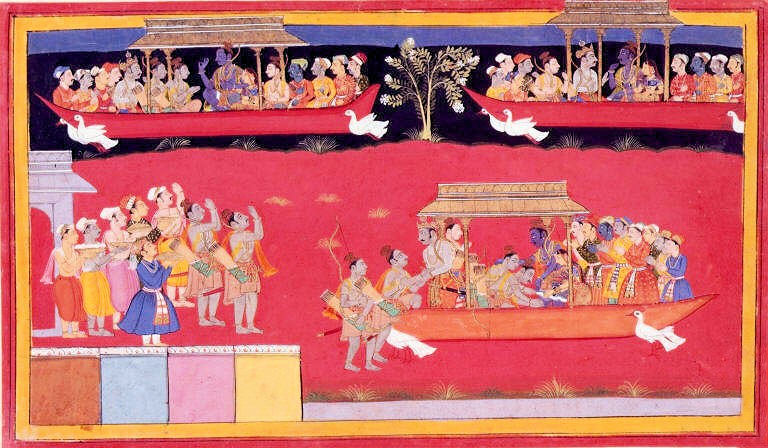
Abb.: Vimāna (Flugschiff): Rāma im Puṣpaka-Vimāna
[Bildquelle: Wikipedia. -- Public domain]
2 Devarṣi - देवर्षि - Götter-ṛṣis
"DEVARṢIS. (Deva-ṛṣis.) Ṛṣis or saints of the celestial class, who dwell in the regions of the gods, such as Nārada. Sages who have attained perfection upon earth and have been exalted as demigods to heaven."
[Quelle: Dowson, John <1820-1881>: A classical dictionary of Hindu mythology and religion, geography, history, and literature. -- London, Trübner, 1879. -- s.v.]
Götter-ṛṣis sind z.B.: Nārada, Asita, Devala, Tumburu, Bharata, Parvata
3 Nārada - नारद m. - Nārada
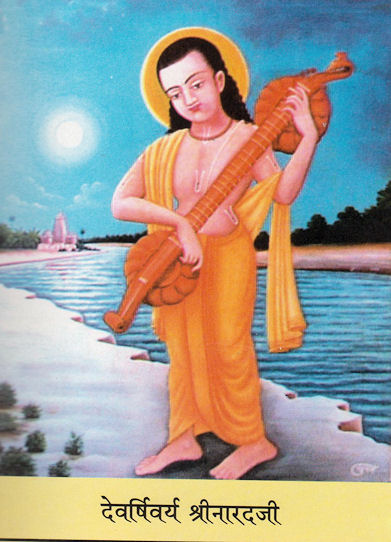
Abb.: Nārada
[Bildquelle: Sri Vasudeva Sarana Upadhyaya / Wikipedia. --
GNU FDLIcense]
"NĀRADA. A Ṛṣi to whom some hymns of the Ṛg-veda are ascribed. He is one of the Prajāpatis, and also one of the seven great Ṛṣis. The various notices of him are somewhat inconsistent. The Ṛg-veda describes him as "of the Kaṇva family." Another authority states that he sprang from the forehead of Brahmā, and the Viṣṇu Purāṇa makes him a son of Kaśyapa and one of Dakṣa's daughters. The Mahā-bhārata and some Purāṇas state that he frustrated the scheme which Dakṣa had formed for peopling the earth, and consequently incurred that patriarch's curse to enter again the womb of a woman and be born. Dakṣa, however, relented at the solicitation of Brahmā, and consented that Nārada should be born again of Brahmā and one of Dakṣa's daughters ;he was hence called Brahmā and Deva-brahmā. In some respects he bears a resemblance to Orpheus. He is the inventor of the vīṇā (lute), and was chief of the Gandharvas or heavenly musicians. He also went down to the infernal regions (Pātāla), and was delighted with what he saw there. In later times he is connected with the legend of Kṛṣṇa. He warned Kaṃsa of the imminent incarnation of Viṣṇu, and he afterwards became the friend and associate of Kṛṣṇa.
The Nārada-pañca-rātra relates that Brahmā advised his son Nārada to marry, but Nārada censured his father as a false teacher, because devotion to Kṛṣṇa was the only true means of felicity. Brahma then cursed Nārada to lead a life of sensuality, in subjection to women, and Nārada retorted the curse, condemning Brahmā to lust after his own daughter, and to be an object unworthy of adoration.
Nārada has the appellations, Kali-kāraka, 'strife-maker'; Kapi-vaktra, 'monkey-faced'; Piśuna, 'messenger' or 'spy'.
Nārada was also one of the great writers upon law. His text-book, called "Nāradīya Dharma-śāstra," has been translated into English by Dr. Jolly."
[Quelle: Dowson, John <1820-1881>: A classical dictionary of Hindu mythology and religion, geography, history, and literature. -- London, Trübner, 1879. -- s.v.]
4 Sudharmā - सुधर्मा f. - Sudharmā
"SU-DHARMĀ, SU-DHARMAN. The hall of Indra, "the unrivalled gem of princely courts," which Kṛṣṇa commanded Indra to resign to Ugrasena, for the assemblage of the race of Yadu. After the death of Kṛṣṇa it returned to Indra's heaven."
[Quelle: Dowson, John <1820-1881>: A classical dictionary of Hindu mythology and religion, geography, history, and literature. -- London, Trübner, 1879. -- s.v.]
5 Mandākinī - मन्दाकिनी f.: Mandākinī
"MANDĀKINĪ. The heavenly Ganges. The Ganges. An arm of the Ganges which flows through Kedāra-nātha. A river near the mountain Citra-kūṭa (q.v.) in Bundelkhand. It was near the abode of Rāma and Sītā, and is mentioned both in the Rāmāyaṇa and Mahā-bhārata. It would seem to be the modern Pisuni."
[Quelle: Dowson, John <1820-1881>: A classical dictionary of Hindu mythology and religion, geography, history, and literature. -- London, Trübner, 1879. -- s.v.]
6 Meru - मेरु m: Meru
"MERU. A fabulous mountain in the navel or centre of the earth, on which is situated Svarga, the heaven of Indra, containing the cities of the gods and the habitations of celestial spirits. The Olympus of the Hindus. Regarded as a terrestrial object, it would seem to be some mountain north of the Himalayas. It is also Su-meru, Hemādri, 'golden mountain' ; Ratna-sānu, 'jewel peak'; Karṇīkācala, 'lotus mountain'; and Amarādri and Deva-parvata, 'mountain of the gods'."
[Quelle: Dowson, John <1820-1881>: A classical dictionary of Hindu mythology and religion, geography, history, and literature. -- London, Trübner, 1879. -- s.v.]
7 Mandāra - मन्दार m.: Mandāra (Indischer Korallenbaum - Erythrina variegata L.)
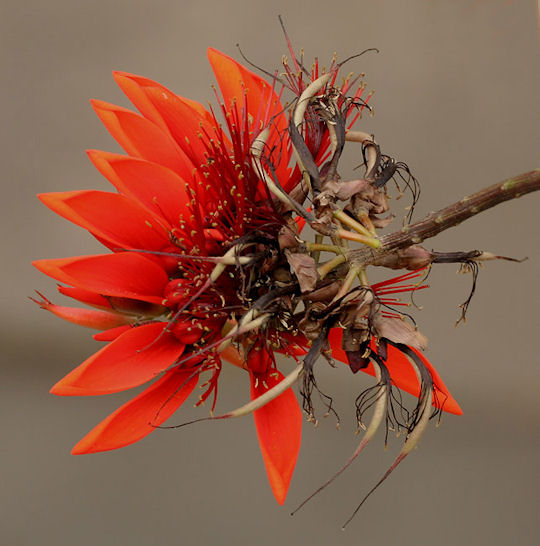
Abb.: Blüte des Indischen Korallenbaums - Erythrina variegata L.
[Bildquelle: J. M. Garg / Wikipedia. -- GNU FDLicense]
8 Kalpavṛkṣa - कल्पवृक्ष m.: Wunschbaum
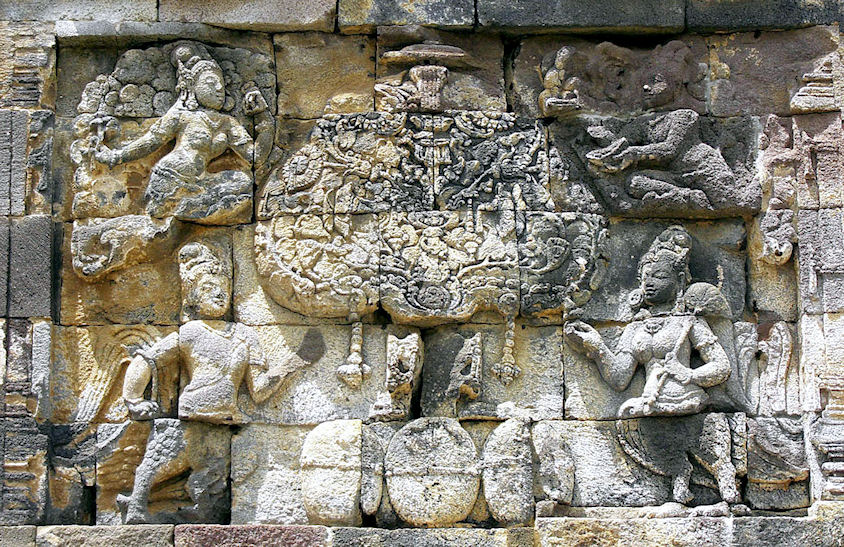
Abb.: Kalpavṛkṣa, Candi Pawon, Jawa, Indonesien, 8. Jhdt. n. Chr.
[Bildquelle: Gunkarta / Wikipedia. -- GNU FDLicense]
8 Haricandana - हरिचन्दन m., n.: Haricandana (gelber Sandelbaum - Santalum album L.)
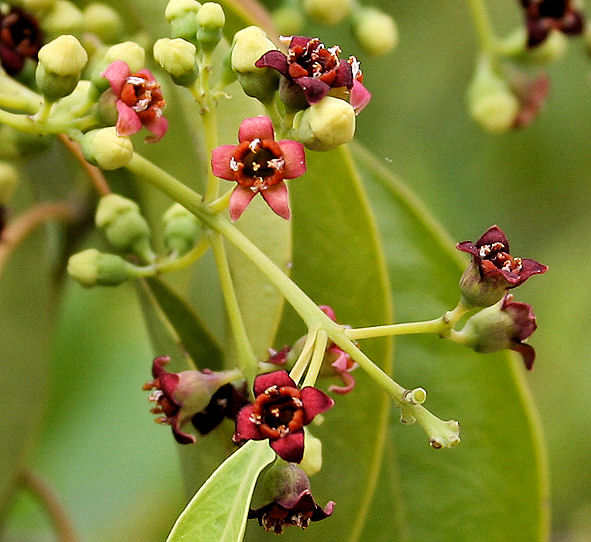
Abb.: Blüte des gelben Sandelbaums - - Santalum album L., Hyderabad
(హైదరాబాదు;
حیدر آباد ) Indien
[Bildquelle: J. M. Garg / Wikipedia. -- GNU FDLicense]
9 Sanatkumāra . सनत्कुमार m.: ewiger Junge
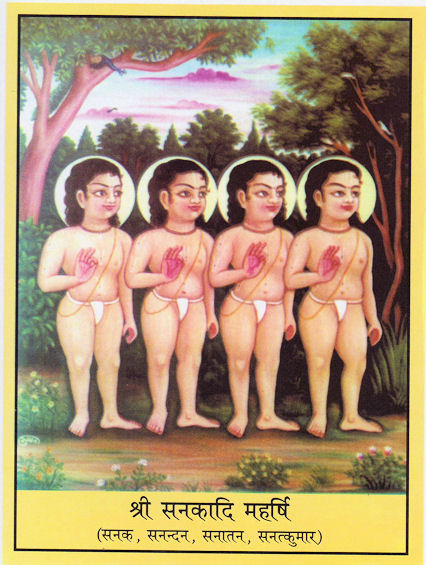
Abb.: Sanatkumāra und die drei anderen Kumāras
[Bildquelle: Sri Vasudeva Sarana Upadhyaya / Wikipedia. --
GNU FDLicense]
"KUMĀRAS. Mind-born sons of Brahmā, who, declining to create progeny, remained ever boys and ever pure and innocent. There were four of them, Sanat-kumāra, Sananda, Sanaka, and Sanātana ; a fifth, Ṛbhu, is sometimes added. See Viṣṇu Purāṇa."
[Quelle: Dowson, John <1820-1881>: A classical dictionary of Hindu mythology and religion, geography, history, and literature. -- London, Trübner, 1879. -- s.v.]
10 Aśvin - अश्विन m.: Aśvin (Pferdehalter)
"AŚVINS, AŚVINAU (dual), AŚVINĪ KUMARAS. "Horsemen". Dioskouroi. Two Vedic deities, twin sons of the sun or the sky. They are ever young and handsome, bright, and of golden brilliancy, agile, swift as falcons, and possessed of many forms ; and they ride in a golden car drawn by horses or birds, us harbingers of Uṣas, the dawn. "They are the earliest bringers of light in the morning sky, who in their chariot hasten onwards before the dawn and prepare the way for her." Roth. As personifications of the morning twilight, they are said to be children of the sun by a nymph who concealed herself in the form of a mare ; hence she was called Aśvinī and her sons Aśvin's. But inasmuch as they precede the rise of the sun, they are called his parents in his form Pūṣan. Mythically they are the parents of the Pāṇḍu princes Nakula and Sahadeva. Their attributes are numerous, but relate mostly to youth and beauty, light and speed, duality, the curative power, and active benevolence. The number of hymns addressed to them testify to the enthusiastic worship they received. They were the physicians of Svarga, and in this character are called Dasras and Nāsatyas, Gadāgadau and Svar-vaidyau ; or one was Dasra and the other Nāsatya. Other of their appellations are Abdhi-jau, 'ocean born' ; Puṣkara-srajau, 'wreathed with lotuses'; Bāḍaveyau, sons of the submarine fire, Bāḍava, Many instances are recorded of their benevolence and their power of healing. They restored the sage Cyavana to youth, and prolonged his life when he had become old and decrepit, and through his instrumentality they were admitted to partake of the libations of soma, like the other gods, although Indra strongly opposed them. (See Cyavana.) The Aśvins, says Muir, "have been a puzzle to the oldest commentators," who have differed widely in their explanations. According to different interpretations quoted in the Nirukta, they were "heaven and earth," "day and night," "two kings, performers of holy acts." The following is the view taken of them by the late Professor Goldstücker, as printed in Muir's Texts, vol. v. :
"The myth of the Aśvins is, in my opinion, one of that class of myths in which two distinct elements, the cosmical and the human or historical, have gradually become blended into one. It seems necessary, therefore, to separate these two elements in order to arrive at an understanding of the myth. The historical or human element in it, I believe, is represented by those legends which refer to the wonderful cures effected by the Aśvins, and to their performances of a kindred sort ; the cosmical element is that relating to their luminous nature. The link which connects both seems to be the mysteriousness of the nature and effects of the phenomena of light and of the healing art at a remote antiquity. That there might have been some horsemen or warriors of great renown, who inspired their contemporaries with awe by their wonderful deeds, and more especially by their medical skill, appears to have been also the opinion of some old commentators mentioned by Yāska [in the Nirukta], for some legendary writers, he says, took them for 'two kings, performers of holy acts', and this view seems like wise borne out by the legend in which it is narrated that the gods refused the Aśvins admittance to a sacrifice on the ground that they had been on too familiar terms with men. It would appear, then, that these Aśvins, like the Ṛbhus, were originally renowned mortals, who, in the course of time, were translated into the companionship of the gods. . . .
"The luminous character of the Aśvins can scarcely be matter of doubt, for the view of some commentators, recorded by Yāska, according to which they are identified with heaven and earth, appears not to be countenanced by any of the passages known to us. Their very name, it would seem, settles this point, since Aśva, the horse, literally the pervader, is always the symbol of the luminous deities, especially of the sun. . . .
"It seems to be the opinion of Yaska that the Aśvins represent the transition from darkness to light, when the intermingling of both produces that inseparable duality expressed by the twin nature of these deities. And this interpretation, I hold, is the best that can be given of the character of the cosmical Aśvins. It agrees with the epithets by which they are invoked, and with the relationship in which they are placed. They are young, yet also ancient, beautiful, bright, swift, &c. ; and their negative character, the result of the alliance of light with darkness, is, I believe, expressed by dasra, the destroyer, and also by the two negatives in the compound nāsatya (na + a-satya) ; though their positive character is again redeemed by the ellipsis of enemies, or diseases to dasra, and by the sense of nāsatya, not untrue, i.e., truthful."
[Quelle: Dowson, John <1820-1881>: A classical dictionary of Hindu mythology and religion, geography, history, and literature. -- London, Trübner, 1879. -- s.v.]
11 Apsaras - अप्सरस् f. pl.: Apsaras
siehe oben!
12 Urvaśīmukhā - उर्वशीमुखा f. pl.: Urvaśī und die übrigen
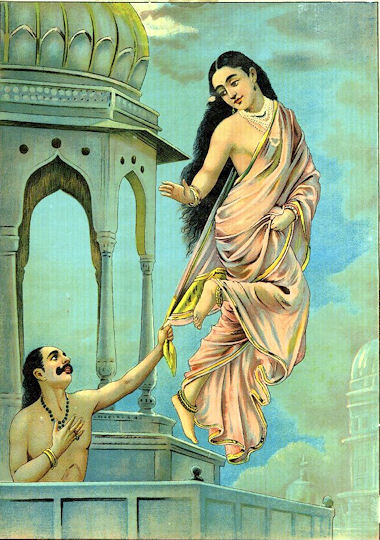
Abb.: Raja Ravi Varma (രാജാ രവി വര്മ)
<1848 - 1906>: Purūravas und Urvaśī
[Bildquelle: Wikipedia. -- Public domain.]
"URVAŚĪ. A celestial nymph, mentioned first in the Ṛgveda. The sight of her beauty is said to have caused the generation, in a peculiar way, of the sages Agastya and Vasiṣṭha by Mitra and Varuṇa. A verse says, "And thou, Vasiṣṭha, art a son of Mitra and Varuṇa." She roused the anger of these two deities and incurred their curse, through which she came to live upon the earth, and became the wife or mistress of Purū-ravas. The story of her amour with Purū-ravas is first told in Śatapatha Brāhmaṇa. The loves of Purū-ravas, the Vikrama or hero, and of Urvaśi, the nymph, are the subject of Kālidāsa's drama called Vikramorvaśī. See Purū-ravas."
[Quelle: Dowson, John <1820-1881>: A classical dictionary of Hindu mythology and religion, geography, history, and literature. -- London, Trübner, 1879. -- s.v.]
13 Gandharva - गन्धर्व m.: Gandharvas
Siehe oben!
56. agnir vaiśvānaro vahnir vītihotro dhanañjayaḥ
kṛpīṭayonir jvalano jātavedās tanūnapāt
57.
barhiḥ śuṣmā kṛṣṇavartmā śociṣkeśa uṣarbudhaḥ
āśrayāśo bṛhadbhānuḥ kṛśānuḥ pāvako 'nalaḥ
58. rohitāśvo vāyusakhaḥ śikhāvān āśuśukṣaṇiḥ
hiraṇyaretā hutabhug dahano havyavāhanaḥ
59. saptārcir damunāḥ śukraś citrabhānur vibhāvasuḥ
śucir appittam aurvas tu vāḍavo vaḍavānalaḥ
अग्निर् वैश्वानरो वह्निर् वीतिहोत्रो धनञ्जयः ।
कृपीटयोनिर् ज्वलनो जातवेदास् तनूनपात् ॥५६॥
बर्हिः शुष्मा कृष्णवर्त्मा शोचिष्केश उषर्बुधः ।
आश्रयाशो बृहद्भानुः कृशानुः पावको
ऽनलः
॥५७॥
रोहिताश्वो वायुसखः शिखावान् आशुशुक्षणिः ।
हिरण्यरेता हुतभुग् दहनो हव्यवाहनः ॥५८॥
सप्तार्चिर् दमुनाः शुक्रश् चित्रभानुर् विभावसुः ।
शुचिर् अप्पित्तम् और्वस् तु वाडवो वाडवानलः ॥५९॥
[Bezeichnungen für Agni1 bzw. Feuer sind:]
Erläuterungen:
1 Agni - अग्नि m.: Feuer, Agni
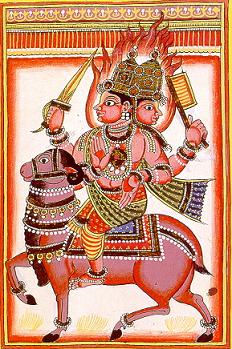
Abb.: Agni, 18. Jhdt. n. Chr.
[Bildquelle: Wikipedia. -- Public domain]
"AGNI. (Nom. Agnis = Ignis.) 'Fire', one of the most ancient and most sacred objects of Hindu worship. He appears in three phases in heaven as the sun, in mid-air as lightning, on earth as ordinary fire. Agni is one of the chief deities of the Vedas, and great numbers of the hymns are addressed to him, more indeed than to any other god. He is one of the three great deities Agni, Vāyu (or Indra), and Sūrya who respectively preside over earth, air, and sky, and are all equal in dignity. "He is considered as the mediator between men and gods, as protector of men and their homes, and as witness of their actions ; hence his invocation at all solemn occasions, at the nuptial ceremony, &c. Fire has ceased to be an object of worship, but is held in honour for the part it performs in sacrifices." Agni is represented as having seven tongues, each of which has a distinct name, for licking up the butter used in sacrifices. He is guardian of the south-east quarter, being one of the eight lokapālas (q.v.), and his region is called Pura-jyotis.
In a celebrated hymn of the Ṛg-veda attributed to Vasiṣṭha, Indra and other gods are called upon to destroy the Kravyāds 'the flesh-eaters', or Rakṣas enemies of the gods. Agni himself is also a Kravyād, and as such he takes an entirely different character. He is represented under a form as hideous as the beings he is invoked to devour. He sharpens his two iron tusks, puts his enemies into his mouth and swallows them. He heats the edges of his shafts and sends them into the hearts of the Rakṣas.
"He appears in the progress of mythological personification as a son of Aṅgiras, as a king of the Pitṛs or Manes, as a Marut, as a grandson of Saṇḍila, as one of the seven sages or Ṛṣis, during the reign of Tāmasa the fourth Manu," and as a star. In the Mahā-bhārata Agni is represented as having exhausted his vigour by devouring too many oblations, and desiring to consume the whole Khāṇḍava forest as a means of recruiting his strength. He was prevented by Indra, but having obtained the assistance of Kṛṣṇa and Arjuna, he baffled Indra and accomplished his object. In the Viṣṇu Purāṇa he is called Abhimānī, and the eldest son of Brahmā. His wife was Svāhā; by her he had three sons, Pāvaka, Pavamāna, and Śuci, and these had forty-five sons; altogether forty-nine persons, identical with the forty-nine fires, which forty-nine fires the Vāyu Purāṇa endeavours to discriminate. He is described in the Hari-vaṃśa as clothed in black, having smoke for his standard and head-piece, and carrying a flaming javelin. He has four hands, and is borne in a chariot drawn by red horses, and the seven winds are the wheels of his car. He is accompanied by a ram, and sometimes he is represented riding on that animal. The representations of him vary.
The names and epithets of Agni are many - Vahni, Anala, Pāvaka, Vaiśvānara, son of Viśvānara, the sun; Abja-hasta, 'lotus in hand' ; Dhūma-ketu, 'whose sign is smoke' ; Hutāśa or Huta-bhuj, 'devourer of offerings' ; Śuci or Śukra, 'the bright' ; Rohitāśva, 'having red horses' ; Chāga-ratha, 'ram-rider' ; Jātavedas (q.v.); Sapta-jihva, 'seven-tongued' ; Tomara-dhara, 'javelin-bearer'."
[Quelle: Dowson, John <1820-1881>: A classical dictionary of Hindu mythology and religion, geography, history, and literature. -- London, Trübner, 1879. -- s.v.]
2 Hutabhuj - हुतभुज् m.: Opferverzehrer
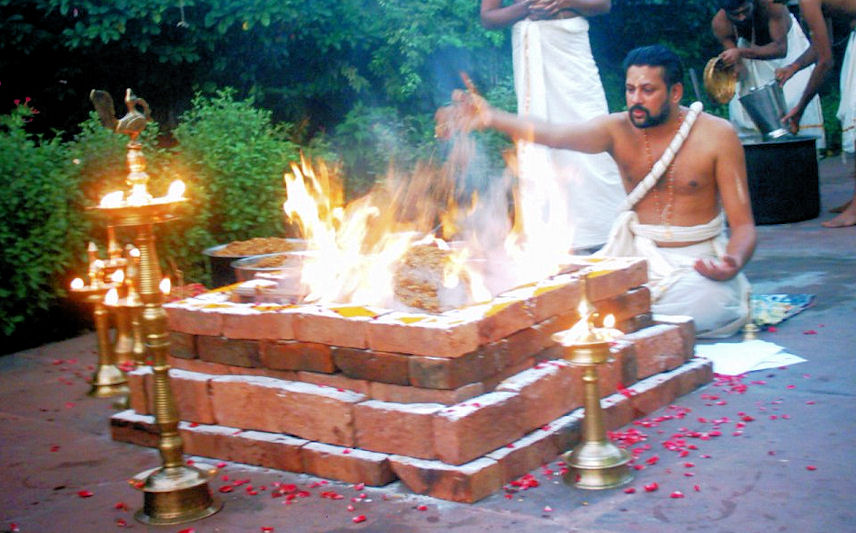
Abb.: Opferverzehrer: Opfer (yajña) eine Nambudiri-Brahmanen (നമ്പൂതിരി),
Kerala
[Bildquelle: आशीष भटनागर / Wikipedia. -- Public domain]
59. c./d. śucir appittam aurvas tu vāḍavo vaḍavānalaḥ
60. vahner dvayor jvālakīlāv arcir hetiḥ śikhā striyām
triṣu sphuliṅgo 'gnikaṇaḥ saṃtāpaḥ saṃjvaraḥ samau
61. ulkā syāt nirgatajvālā bhūtir bhasitabhasmanī
kṣāro rakṣā ca dāvas tu davo vanahutāśanaḥ
शुचिर् अप्पित्तम् और्वस् तु वाडवो वाडवानलः ॥५९॥
वह्नेर् द्वयोर् ज्वालकीलाव् अर्चिर् हेतिः शिखा
स्त्रियाम् ।
त्रिषु स्फुलिङ्गो
ऽग्निकणः संतापः संज्वरः समौ ॥६०॥
उल्का स्यात् निर्गतज्वाला भूतिर् भसितभस्मनी ।
क्षारो रक्षा च दावस् तु दवो वनहुताशनः ॥६१॥
[Bezeichnungen für das unterirdische Feuer sind:]
[Bezeichnungen für Flamme sind:]
[Bezeichnungen für Funken sind:]
[Bezeichnungen für Glut sind:]
[Bezeichnungen für Meteor sind:]
Bezeichnungen für verlöschtes Feuer sind:
[Bezeichnungen für Waldbrand sind:]
Erläuterungen:
1 Aurva - और्व m.: Aurva (Nachfahre des Ūrva)
"AURVA. A Ṛṣi, son of Ūrva and grandson of Bhṛgu.
He is described in the Mahā-bhārata as son of the sage Cyavana by his wife Āruṣī. From his race he is called Bhārgava. The Mahā-bhārata relates that a king named Kṛta-vīrya was very liberal to his priests of the race of Bhṛgu, and that they grew rich upon his munificence. After his death, his descendants, who had fallen into poverty, begged help from the Bhrigus, and met with no liberal response. Some of them buried their money, and when this was discovered the impoverished Kṣatriyas were so exasperated that they slew all the Bhṛgus down to the children in the womb. One woman concealed her unborn child in her thigh, and the Kṣatriyas being informed of this, sought the child to kill it, but the child "issued forth from its mother's thigh with lustre and blinded the persecutors. From being produced from the thigh (uru), the child received the name of Aurva, The sage's austerities alarmed both gods and men, and he for a long time refused to mitigate his wrath against the Kṣatriyas, but at the persuasion of the Pitṛs, he cast the lire of his anger into the sea, where it became a being with the face of a horse called Haya-śiras. While he was living in the forest he prevented the wife of King Bāhu from burning herself with her husband's corpse. Thus he saved the life of her son, with whom she had been pregnant seven years. When the child was born he was called Sagara (ocean) ; Aurva was his preceptor, and bestowed on him the Āgneyāstra, or fiery weapon with which he conquered the barbarians who invaded his country. Aurva had a son named Ṛcīka, who was father of Jamadagni.
The Hari-vaṃśa gives another version, of the legend, about the offspring of Aurva. The sage was urged by his friends to beget children. He consented, but he foretold that his progeny would live by the destruction of others. Then he produced from his thigh a devouring fire, which cried out with, a loud voice, "I am hungry; let me consume the world." The various regions were soon in flames, when Brahmā interfered to save his creation, and promised the son of Aurva a suitable abode and maintenance. The abode was to be at Baḍavā-mukha, the mouth of the ocean ; for Brahmā was born and rests in the ocean, and he and the newly produced fire were to consume the world together at the end of each age, and at the end of time to devour all things with the gods, Asuras, and Rākṣasas. The name Aurva thus signifies, shortly, the submarine fire. It is also called Baḍavānala and Samvarttaka. It is represented as a flame with a horse s head, and is also called Kāka-dhvaja, from carrying a banner on which there is a crow."
[Quelle: Dowson, John <1820-1881>: A classical dictionary of Hindu mythology and religion, geography, history, and literature. -- London, Trübner, 1879. -- s.v.]
2 Bāḍava - वाडवो m.: Bāḍava
"BAḌAVĀ. A mare, the submarine fire. In mythology it is a flame with the head of a horse, called also Haya-śiras, 'horse-head'. See Aurva."
[Quelle: Dowson, John <1820-1881>: A classical dictionary of Hindu mythology and religion, geography, history, and literature. -- London, Trübner, 1879. -- s.v.]
3 Kṣāra - क्षार m.: Ätzendes, Holzasche (als Grundlage für Pottasche / kohlensaures Kali)
"Pottasche, mehr oder weniger reines kohlensaures Kali K2CO3 (s. d.), wurde früher ausschließlich aus Holzasche, besonders in Rußland, Siebenbürgen, Illyrien, Ungarn und Nordamerika dargestellt. Die Pflanzen nehmen aus dem Boden als Nahrungsstoffe Salze auf, deren Basen in der Pflanze zum Teil an organische Säuren gebunden werden. Diese Salze organischer Säuren werden beim Verbrennen der Pflanzensubstanz in Kohlensäuresalze umgewandelt, und so erklärt sich das Vorkommen von kohlensaurem Kali in der Asche, das in der lebenden Pflanze nicht vorhanden ist." [Quelle: Meyers großes Konversations-Lexikon. -- DVD-ROM-Ausg. Faksimile und Volltext der 6. Aufl. 1905-1909. -- Berlin : Directmedia Publ. --2003. -- 1 DVD-ROM. -- (Digitale Bibliothek ; 100). -- ISBN 3-89853-200-3. -- s.v.]
61. dharmarājaḥ pitṛpatiḥ samavartī paretarāṭ
kṛtānto yamunābhrātā śamano yamarāḍ yamaḥ
62. a./b. kālo daṇḍadharaḥ śrāddhadevo vaivasvato 'ntakaḥ
धर्मराजः पितृपतिः समवर्ती परेतराट् ।
कृतान्तो यमुनाभ्राता शमनो यमराड् यमः ॥६१॥
कालो दण्डधरः श्राद्धदेवो वैवस्वतो
ऽन्तकः
॥६१ क्॥
[Bezeichnungen für Yama1 sind:]
Erläuterungen:
1 Yama - यम m.: Yama ("Bändiger")
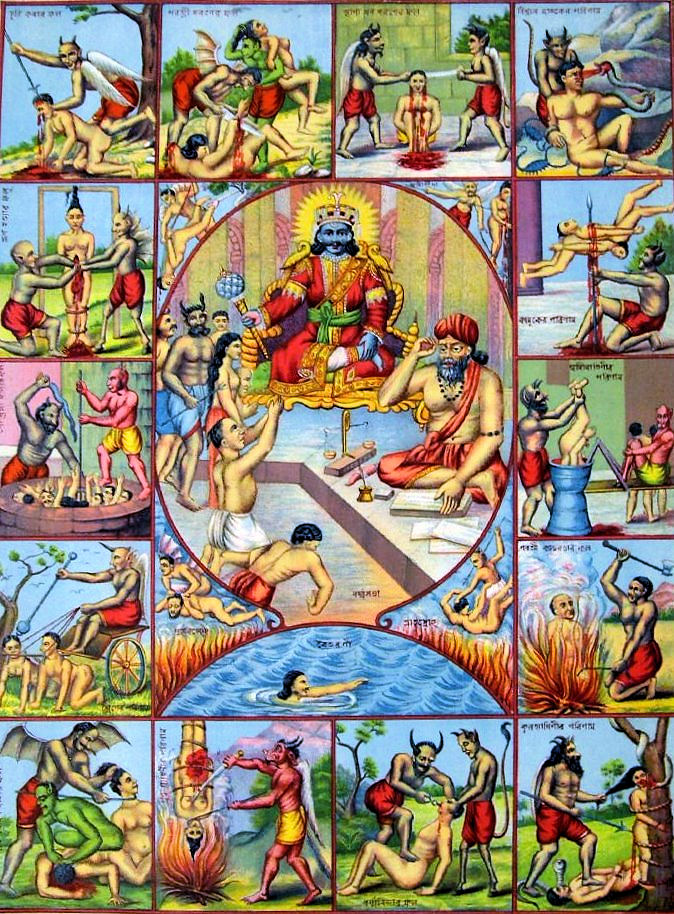
Abb.: Yama, ca. 1895
"Album of popular prints mounted on cloth pages. Colour lithograph, lettered, inscribed and numbered 11. A large central panel portrays Yama the god of death (often referred to as Dharma) seated on a throne; to the left stands a demon. To the right of Yama sits Citragupta, assigned with keeping detailed records of every human being and upon their death deciding how they are to be reincarnated, depending on their previous actions. A woman and two men await their judgement. The rest of the print is compartmentalised into fourteen smaller panels, and each image portrays a different way demons torture sinners. These vary from being pierced by a spear, to having your entrails removed. Bengali inscriptions detail each occurrence."
[Bildquelle: Wikipedia. -- Public domain
"YAMA. 'Restrainer'. Pluto, Minos. In the Vedas Yama is god of the dead, with whom the spirits of the departed dwell, lie was the son of Vivasvat (the Sun), and had a twin-sister named Yamī or Yamunā. These are by some looked upon as the first human pair, the originators of the race ; and there is a remarkable hymn, in the form of a dialogue, in which the femal urges their cohabitation for the purpose of perpetuating the species. Another hymn says that Yama "was the first of men that died, and the first that departed to the (celestial) world." He it was who found out the way to the home which cannot be taken away : "Those who are now born (follow) by their own paths to the place whither our ancient fathers have departed." says Dr. Muir, "Yama is nowhere represented in the Ṛg-veda as having anything to do with the punishment of the wicked." So far as is yet known, "the hymns of that Veda contain no prominent mention of any such penal retribution. . . . Yama is still to some extent an object of terror. He is represented as having two insatiable dogs with four eyes and wide nostrils, which, guard the road to his abode, and which the departed are advised to hurry past with all possible speed. These dogs are said to wander about among men as his messengers, no doubt for the purpose of summoning them to their master, who is in another place identified with death, and is described as sending a bird as the herald of doom."
In the epic poems Yama is the son of the Sun by Sanjñā (conscience), and brother of Vaivasvata (Manu). Mythologically he was the father of Yudhi-ṣṭhira. He is the god of departed spirits and judge of the dead. A soul when it quits its mortal form repairs to his abode in the lower regions ; there the recorder, Citra-gupta, reads out his account from the great register called Agra-sandhānī, and a just sentence follows, when the soul either ascends to the abodes of the Pitṛs (Manes), or is sent to one of the twenty-one hells according to its guilt, or it is born again on earth in another form. Yama is regent of the south quarter, and as such is called Dakṣiṇāśā-pati. He is represented as of a green colour and clothed with red. He rides upon a buffalo, and is armed with a ponderous mace and a noose to secure his victims.
In the Purāṇas a legend is told of Yama having lifted his foot to kick Chāyā, the handmaid of his father. She cursed him to have his leg affected with sores and worms, but his father gave him a cock which picked off the worms and cured the discharge. Through this incident he is called Śīṛṇa-pada, 'shrivelled foot'.
Yama had several wives, as Hemamālā, Su-śīlā, and Vijayā. He dwells in the lower world, in his city Yama-pura. There, in his palace called Kālīcī, he sits upon his throne of judgment, Vicāra-bhū. He is assisted by his recorder and councillor, Citra-gupta, and waited upon by his two chief attendants and custodians, Canda or Mahā-canda, and Kāla-puruṣa. His messengers, Yama-dūtas, bring in the souls of the dead, and the door of his judgment-hall is kept by his porter, Vaidhyata.
Yama has many names descriptive of his office. He is Mṛtyu, Kāla, and Antaka, 'death' ; Kṛtānta, 'the finisher' ; Śamana, 'the settler' ; } Daṇḍī or Daṇḍa-dhara, 'the rod-bearer' ; Bhīma-śāsana, 'of terrible decrees' ; Pāśī, 'the noose-carrier' ; Pitṛ-pati, 'lord of the manes' ; Preta-rāja, 'king of the ghosts' ; Śrāddha-deva, 'god of the exequial offerings'; and especially Dharma-rāja, 'king of justice'. He is Audumbara, from Udumbara, 'the fig-tree', and from his parentage he is Vaivasvata. There is a Dharma-śāstra which bears the name of Yama."
[Quelle: Dowson, John <1820-1881>: A classical dictionary of Hindu mythology and religion, geography, history, and literature. -- London, Trübner, 1879. -- s.v.]
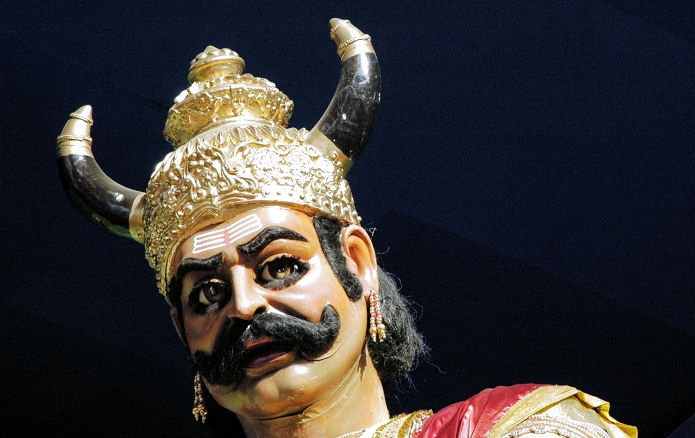
Abb.: Yama
[Bildquelle: JoVivek. -- http://www.flickr.com/photos/80667779@N00/1274386095. -- Zugriff am 2010-06-28. -- Creative Commons Lizenz (Namensnennung)]
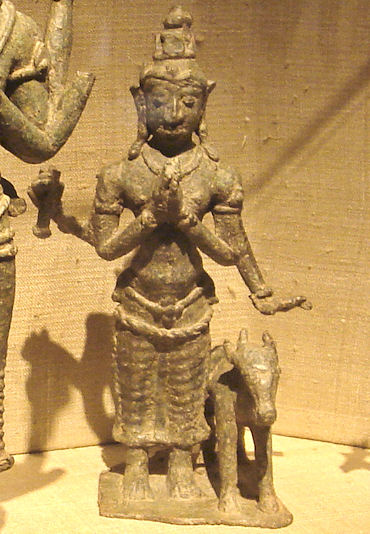
Abb.: Yama als Dakṣiṇāśā-pati
[Bildquelle: shibainu. --
http://www.flickr.com/photos/50576994@N00/1413044344. -- Zugriff am
2010-07-07. --
Creative Commons Lizenz (Namensnennung)]
2 Yamunābhrātṛ - यमुनाभ्रातृ m.: Bruder der Yamunā
"YAMUNĀ. The river Jumna, which rises in a mountain called Kalinda (Sun). The river Yamunā is personified as the daughter of the Sun by his wife Saṃjñā. So she was sister of Yama. Bala-rāma, in a state of inebriety, called upon her to come to him that he might bathe, and as she did not heed, he, in a great rage, seized his ploughshare-weapon, dragged her to him and compelled her to follow him whithersoever he wandered through the wood. The river then assumed a human form and besought his forgiveness, but it was some time before she could appease him. Wilson thinks that "the legend probably alludes to the construction of canals from the Jumna for the purposes of irrigation." The river is also called Kālindī, from the place of its source, Sūrya-jā, from her father, and Tri-yāmā."
[Quelle: Dowson, John <1820-1881>: A classical dictionary of Hindu mythology and religion, geography, history, and literature. -- London, Trübner, 1879. -- s.v.]
62. c./d. rākṣasaḥ kauṇapaḥ kravyāt kravyādo 'srapa āśaraḥ
63. rātriñcaro rātricaraḥ karburo nikaṣātmajaḥ
yātudhānaḥ puṇyajano nairṛto yāturakṣasī
राक्षसः कौणपः क्रव्यात् क्रव्यादो
ऽस्रप आशरः ॥६२ ख्॥
रात्रिञ्चरो रात्रिचरः कर्बुरो निकषात्मजः ।
यातुधानः पुण्यजनो नैरृतो यातुरक्षसी ॥६३॥
[Bezeichnungen für Unholde sind:]
Erläuterungen:
1 Rākṣasa - राक्षस m.: Rākṣasa
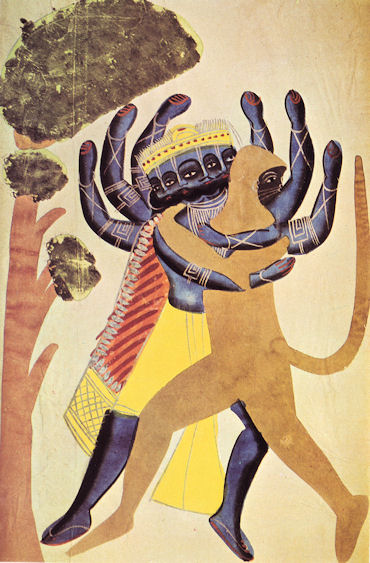
Abb.: Der Rākṣasa-König Rāvaṇa im Zweikampf mit Hanumān, Kalighat-Schule, 1880
[Bildquelle: A Journey Round My Skull. --
http://www.flickr.com/photos/15100526@N08/3278161038. -- Zugriff am
2010-07-07. --
Creative Commons Lizenz (Namensnnenung)]
"RĀKṢASAS. Goblins or evil spirits. They are not all equally bad, but have been classified as of three sorts
one as a set of beings like the Yakṣas,
another as a sort of Titans or enemies of the gods, and
lastly, in the common acceptation of the term, demons and fiends who haunt cemeteries, disturb sacrifices, harass devout men, animate dead bodies, devour human beings, and vex and afflict mankind in all sorts of ways.
These last are the Rākṣasas of whom Rāvaṇa was chief, and according to some authorities, they are descended, like Rāvaṇa himself, from the sage Pulastya. According to other authorities, they sprang from Brahmā's foot. The Viṣṇu Puāṇa also makes them descendants of Kaśyapa and Khaśā, a daughter of Dakṣa, through their son Rākṣas ; and the Rāmāyaṇa states that when Brahmā created the waters, he formed certain beings to guard them who were called RāKṣasas (from the root rakṣ, 'to guard', but the derivation from this root may have suggested the explanation), and the Viṣṇu Purāṇa gives a somewhat similar derivation.
It is thought that the Rākṣasas of the epic poems were the rude barbarian races of India who were subdued by the Aryans. When Hanumān entered the city of Laṅkā to reconnoitre in the form of a cat, he saw that "the Rākṣasas sleeping in the houses were of every shape and form. Some of them disgusted the eye, while some were beautiful to look upon. Some had long arms and frightful shapes ; some were very fat and some were very lean : some were mere dwarfs and some were prodigiously tall. Some had only one eye and others only one ear. Some had monstrous bellies, hanging breasts, long projecting teeth, and crooked thighs ; whilst others were exceedingly beautiful to behold and clothed in great splendour. Some had two legs, some three legs, and some four legs. Some had the heads of serpents, some the heads of donkeys, some the heads of horses, and some the heads of elephants." (Rāmāyaṇa.)
The Rākṣasas have a great many epithets descriptive of their characters and actions. They are called Anuśaras, Aśaras, and Hanūṣas, 'killers or hurters' ; Iṣṭi-pacas, 'stealers of offerings; Sandhyāā-balas, strong in twilight ; Kṣapāṭas, Naktañ-caras, Rātri-caras, and Śamanī-ṣadas, 'night-walkers' ; Nṛ-jagdhas or Nṛ-cakṣas, 'cannibals' ; Palalas, Palādas, Palankaṣas, Kravyāds, 'carnivorous' ; Asra-pas, Aśṛk-pas, Kauna-pas, Kīlāla-pas, and Rakta-pas, 'blood-drinkers'; Dandaśukas, 'biters' ; Praghasas, 'gluttons' ; Malina-mukhas, 'black-faced' ; Karbūras, &c. But many of these epithets are not reserved exclusively for Rākṣasas."
[Quelle: Dowson, John <1820-1881>: A classical dictionary of Hindu mythology and religion, geography, history, and literature. -- London, Trübner, 1879. -- s.v.]
2 Nikāṣātmaja - निकषात्मज m.: Sohn der Nikāṣā
"NIKAṢĀ. A female demon, the mother of Rāvaṇa. The mother of the carnivorous imps called Piśitāśanas, or by their metronymic Naikaṣeyas and Nikaṣātmajas."
[Quelle: Dowson, John <1820-1881>: A classical dictionary of Hindu mythology and religion, geography, history, and literature. -- London, Trübner, 1879. -- s.v.]
3 Puṇyajana - पुण्यजन m.: Gute Leute
ein Euphemismus / Hüllwort
4 Nairṛta - नैरृत m.: Leute der Nirṛti (Göttin des Todes)
"NIRṚTI. 'Death, decay'. Death personified as a golddess ; sometimes regarded as the wife and sometimes as the daughter of A-dharma. One of the Rudras."
[Quelle: Dowson, John <1820-1881>: A classical dictionary of Hindu mythology and religion, geography, history, and literature. -- London, Trübner, 1879. -- s.v.]
64 a./b. pracetā varuṇaḥ pāśī yādasāṃpatir appatiḥ
प्रचेता वरुणः पाशी यादसांपतिर् अप्पतिः ।६४ क।
[Bezeichnungen für Varuṇa1 sind:]
Erläuterungen:
1 Varuṇa - वरुण m.: Varuṇa
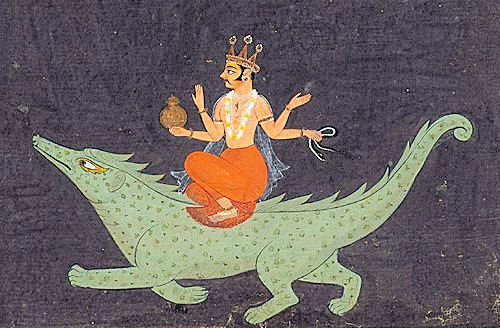
Abb.: Varuṇa auf Makara, Bundi, 1675/1700 n. Chr.
[Bildquelle: Wikipedia. -- Public domain]
"VARUṆΑ. Similar to Οὐρανός. The universal encompasser, the all-embracer. One of the oldest of the Vedic deities, a personification of the all-investing sky, the maker and upholder of heaven and earth. As such he is king of the universe, king of gods and men, possessor of illimitable knowledge, the supreme deity to whom especial honour is due. He is often associated with Mitra, he being the ruler of the night and Mitra of the day ; but his name frequently occurs alone, that of Mitra only seldom. In later times he was chief among the lower celestial deities called Ādityas, and later still he became a sort of Neptune, a god of the seas and rivers, who rides upon the Makara. This character he still retains. His sign is a fish. He is regent of the west quarter and of one of the Nakṣatras or lunar mansions. According to the Mahā-bhārata he was son of Kardama and father of Puṣkara. The Mahā-bhārata relates that he carried off Bhadrā, the wife of Utathya (q.v.), a Brāhman, but Utathya obliged him to submit and restore her. He was in a way the father of the sage Vasiṣṭha (q.v.). In the Vedas, Varuṇa is not specially connected with water, but there are passages in which he is associated with the element of water both in the atmosphere and on the earth, in such a way as may account for the character and functions ascribed to him in the later mythology.
Dr. Muir thus sums up in the words of the hymns the functions and attributes of Varuṇa : "The grandest cosmical functions are ascribed to Varuṇa. Possessed of illimitable resources (or knowledge), this divine being has meted out (or fashioned) and upholds heaven and earth, he dwells in all worlds as sovereign ruler ; indeed the three worlds are embraced within him. He made the golden and revolving sun to shine in the firmament. The wind which resounds through the atmosphere is his breath. He has opened out boundless paths for the sun, and has hollowed out channels for the rivers, which flow by his command. By his wonderful contrivance the rivers pour out their waters into the one ocean but never fill it. His ordinances are fixed and unassailable. They rest on him unshaken as on a mountain. Through the operation (of his laws) the moon walks in brightness, and the stars which appear in the nightly sky mysteriously vanish in daylight. Neither the birds flying in the air, nor the rivers in their ceaseless flow can attain a knowledge of his power or his wrath. His messengers behold both worlds. He knows the flight of birds in the sky, the paths of ships on the ocean, the course of the far-travelling wind, and be holds all the things that have been or shall be done. No creature can even wink without him. He witnesses men s truth and falsehood. He instructs the Ṛṣi Vasiṣṭha in mysteries ; but his secrets and those of Mitra are not to be revealed to the foolish." "He has unlimited control over the destinies of mankind. He has a hundred thousand remedies, and is supplicated to show his wide and deep benevolence and drive away evil and sin, to untie sin like a rope and remove it. He is entreated not to steal away, but to prolong life, and to spare the suppliant who daily transgresses his laws. In many places mention is made of the bonds or nooses with which he seizes and punishes transgressors. Mitra and Varuṇa conjointly are spoken of in one passage as being barriers against falsehood, furnished with many nooses, which the hostile mortal cannot surmount ; and, in another place, India and Varuṇa are described as binding with bonds not formed of rope. On the other hand, Varuṇa is said to be gracious even to him who has committed sin. He is the wise guardian of immortality, and a hope is held out that he and Yama, reigning in blessedness, shall be beheld in the next world by the righteous."
"The attributes and functions ascribed to Varuṇa impart to his character a moral elevation and sanctity far surpassing that attributed to any other Vedic deity."
The correspondence of Varuṇa with Ouranos has been already noted, but "the parallel will not hold in all points. There is not in the Vedic mythology any special relation between Varuṇa and Pṛthivī (the earth) as husband and wife, as there is between Ouranos and Gaia in the theogony of Hesiod ; nor is Varuṇa represented in the Veda, as Ouranos is by the Greek poet, as the progenitor of Dyaus (Zeus), except in the general way in which he is said to have formed and to preserve heaven and earth" (Muir's Texts, v. 58). Mann also refers to Varuṇa as "binding the guilty in fatal cords."
In the Purāṇas, Varuṇa is sovereign of the waters, and one of his accompaniments is a noose, which the Vedic deity also carried for binding offenders : this is called Nāga-pāśa, Pulakāṅga, or Viśva-jit. His favourite resort is Puṣpa-giri, 'flower mountain', and his city Vasudhā-nagara or Sukhā. He also possesses an umbrella impermeable to water, formed of the hood of a cobra, and called Ābhoga. The Viṣṇu Purāṇa mentions an incident which shows a curious coincidence between Varuṇa and Neptune. At the marriage of the sage Ṛcīka, Varuṇa supplied him with the thousand fleet white horses which the bride s father had demanded of him. Varuṇa is also called Pracetas, Ambu-rāja, Jala-pati, Keśa, 'lord of the waters' ; Ud-dāma, 'the surrounder' ; Pāśa-bhṛt, 'the noose-carrier' ; Viloma, Vāri-loma, 'watery hair' ; Yādaḥ-pati, 'king of aquatic animals'. His son is named Agasti."
[Quelle: Dowson, John <1820-1881>: A classical dictionary of Hindu mythology and religion, geography, history, and literature. -- London, Trübner, 1879. -- s.v.]
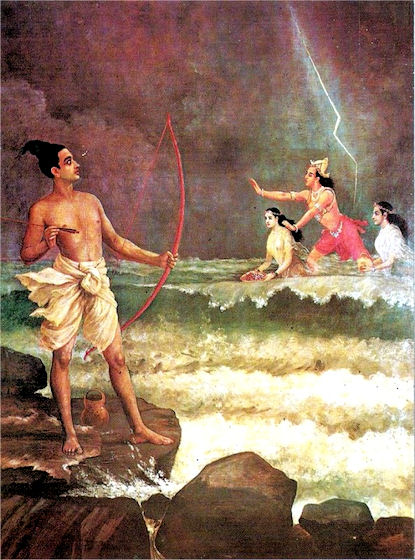
Abb.: Raja Ravi Varma (രാജാ രവി വര്മ)
<1848 - 1906>: Rāma besiegt Varuṇa
[Bildquelle: Wikipedia. -- Public domain.]
64. c./d. śvasanaḥ sparśano vāyur mātariśvā sadāgatiḥ
65. pṛṣadaśvo gandhavaho gandhavāhānilāśugāḥ
samīra-māruta-maruj-jagatprāṇa-samīraṇāḥ
66 a./b. nabhasvad-vāta-pavana-pavamāna-prabhañjanāḥ
श्वसनः स्पर्शनो वायुर् मातरिश्वा सदागतिः ॥६४ ख्॥
पृषदश्वो गन्धवहो गन्धवाहानिलाशुगाः ।
समीर-मारुत-मरुज्-जगत्प्राण-समीरणाः ॥६५॥
नभस्वद्-वात-पवन-पवमान-प्रभञ्जनाः ॥६६ क्॥
[Bezeichnungen für Vāyu1 / Wind sind:]
Erläuterungen:
1 Vāyu - वायु m.: Blaser, Wind, Vāyu
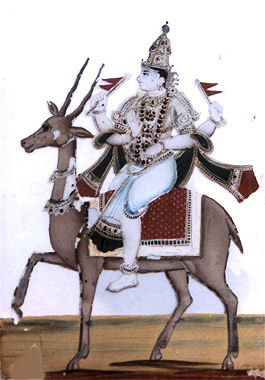
Abb.: Vāyu, 19. Jhdt. n. Chr.
[Bildquelle: Wikipedia. -- Public domain]
"VĀYU. 'Air, wind'. The god of the wind, Eolus. In the Vedas he is often associated with Indra, and rides in the same car with him, Indra being the charioteer. The chariot has a framework of gold which touches the sky, and is drawn by a thousand horses. There are not many hymns addressed to him. According to the Nirukta there are three gods specially connected with each other. "Agni, whose place is on earth ; Vāyu or Indra, whose place is in the air; and Sūrya, whose place is in the heaven." In the hymn Puruṣa-sūkta Vāyu is said to have sprung from the breath of Puruṣa, and in another hymn he is called the son-in-law of Tvaṣṭṛ. He is regent of the north-west quarter, where he dwells.
According to the Viṣṇu Purāṇa he is king of the Gandharvas. The Bhāgavata Purāṇa relates that the sage Nārada incited the wind to break down the summit of Mount Meru. He raised a terrible storm which lasted for a year, but Viṣṇu's bird, Garuḍa, shielded the mountain with his wings, and all the blasts of the wind-god were in vain. Nārada then told him to attack the mountain in Garuḍa's absence. He did so, and breaking off the summit of the mountain, he hurled it into the sea, where it became the island of Laṅkā (Ceylon).
Vāyu is the reputed father of Bhīma and of Hanumat, and he is said to have made the hundred daughters of King Kuśanābha crooked because they would not comply with his licentious desires, and this gave the name Kanyā-kubja, 'hump-backed damsel', to their city.
Other names of Vāyu (wind) are Anila, Marut, Pavana, Vāta, Gandha-vaha, 'bearer of perfumes' ; Jala-kāntāra, 'whose garden is water' ; Sadā-gata, Satata-ga, 'ever moving', &c."
[Quelle: Dowson, John <1820-1881>: A classical dictionary of Hindu mythology and religion, geography, history, and literature. -- London, Trübner, 1879. -- s.v.]
2 Māruta, Marut - मारुत m.: zu den Maruts gehörend, मरुत् m.: Marut
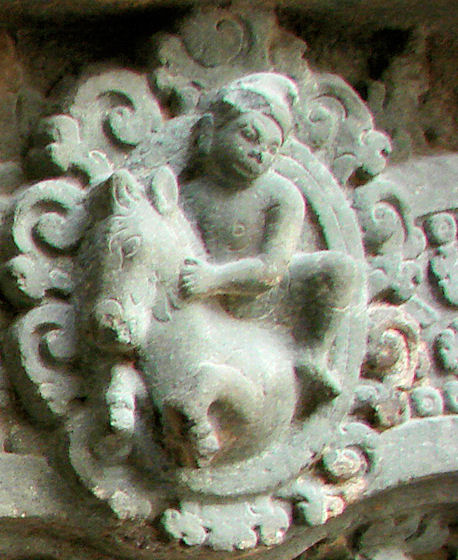
Abb.: Marut, Sambor Prei Kuk, Kampong Thom (កំពង់ធំ),
Kambodscha, 7. Jhdt. n. Chr.
[Bildquelle: Vassil / Wikimedia commons. -- Public domain]
"MARUTS. The storm gods, who hold a very prominent place in the Vedas, and are represented as friends and allies of Indra. Various origins are assigned to them. They are sons of Rudra, sons and brothers of Indra, sons of the ocean, sons of heaven, sons of earth. They are armed with lightnings and thunderbolts, and "ride on the whirlwind and direct the storm." The number of them is said in one place to be thrice sixty, and in another only twenty-seven. In the Rāmāyaṇa they are represented to have their origin in an unborn son of Diti, whom Indra dashed into forty-nine pieces with his thunderbolt, and in compassion converted into Maruts. This is also the story told in the Purāṇas, and they are said to have obtained their name from the words mā rodīḥ, weep not, which Indra addressed to them. A scholiast on the Veda says, that after their birth from Diti, as above told, Śiva and Pārvatī beheld them in great affliction, and the latter asked Śiva to transform the lumps of flesh into boys ; he accordingly made them boys of like form, like age, and similarly accoutred, and gave them to Pārvatī as her sons, whence they are called the sons of Rudra. Other legends are, that Pārvatī, hearing the lamentations of Diti, entreated Śiva to give forms to the shapeless births, telling them not to weep (mā rodīḥ) ; and another, that he actually begot them in the form of a bull on Pṛthivī, the earth, as a cow. (See Diti.) All these legends have manifestly been invented to explain those passages of the Vedas which make the Maruts the sons of Rudra. The world of the Maruts, called Māruta, is the appointed heaven of Vaiśyas.
2. The god of the wind, and regent of the north-west quarter."
[Quelle: Dowson, John <1820-1881>: A classical dictionary of Hindu mythology and religion, geography, history, and literature. -- London, Trübner, 1879. -- s.v.]
66. c./d. prakampano mahāvāto jhañjhāvātaḥ savṛṣṭikaḥ
प्रकम्पनो महावातो झञ्झावातः सवृष्टिकः ॥६६ ख्॥
[Bezeichnungen für Sturm sind:]
Erläuterungen:
1 Prabhañjana - प्रभञ्जन m.: Zerbrecher
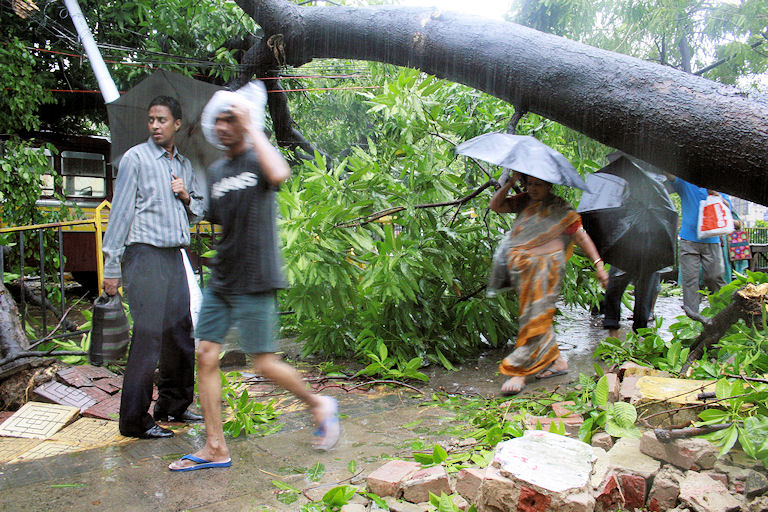
Abb.: Nach dem Sturm, Kolkata (কলকাতা)
[Bildquelle: Wil Wright. --
http://www.flickr.com/photos/wilwright/3622009225/. -- Zugriff am
2010-07-08. --
Creative
Commons Lizenz (Namensnennung, keine kommerzielle Nutzung, share alike)]
67. prāṇo 'pānaḥ samānaś codānavyānau ca vāyavaḥ
śarīrasthā ime raṃhastarasī tu rayaḥ syadaḥ
प्राणो
ऽपानः
समानश् चोदान-व्यानौ च वायवः
शरीरस्था इमे रंहस्तरसी तु रयः स्यदः ॥६७॥
Dies sind die im Körper befindlichen Winde1:
Erläuterungen:
1 im Körper befindlichen Winde
Jātarūpa:
hṛdi prāṇo gude 'pānaḥ samāno nābhisaṃsthitaḥ
udānaḥ kaṇṭhadeśe ca vyānaḥ sarvaśarīragaḥ"Prāṇa befindet sich im Herzen, Apāna im Darm, Samāna im Nabel, Udāna im Halsbereich, Vyāna durchdringt den ganzen Körper."
Kulacandra Śarma Gautama zitiert in seiner Ausgabe des Amarakośa folgenden Vers:
annapraveśanaṃ mūtrādyutsargo 'nnādipācanam
bhāṣaṇādi-nimeṣāś ca tadvyāpārāḥ kramād amī"Diese [Körperwinde] haben ihrer Reihe nach folgende Aufgaben:
- [Prāṇa] - Aufnahme der Speise
- [Apāna] - Ausscheidung Urin usw.
- [Samāna] - Verdauung (Gar-machen) von Speise usw.
- [Udāna] - Sprechen usw.
- [Vyāna] - Augenblinzeln"
67. c./d. śarīrasthā ime raṃhas-tarasī tu rayaḥ syadaḥ
68. javo 'tha śīghraṃ tvaritaṃ laghu kṣipram araṃ drutam
satvaraṃ capalaṃ tūrṇam avilambitam āśu ca
शरीरस्था इमे
रंहस्-तरसी तु रयः स्यदः ॥६७ ख्॥
जवो
ऽथ शीघ्रं त्वरितं लघु क्षिप्रम् अरम् द्रुतम् ।
सत्वरं चपलं तूर्णम् अविलम्बितम् आशु च ॥६८॥
[Bezeichnungen für Schnelligkeit sind:]
[Bezeichnungen für schnell / eilig sind:]
69. satate 'nāratāśrānta-saṃtatāviratāniśam
nityānavaratājasram apy athātiśayo bharaḥ
सततानारताश्रान्त-संतताविरतानिशम्
।
नित्यानवरताजस्रम् अप्य् अथातिशयो भरः
॥६९॥
[Die Bedeutung von "ständig" haben:]
69. c./d. nityānavaratājasram apy athātiśayo bharaḥ
70. ativela-bhṛśātyarthātimātrodgāḍha-nirbharam
tīvraikānta-nitāntāni gāḍha-bāḍha-dṛḍhāni ca
71. a./b. klībe śīghrādya-sattve syāt triṣv eṣāṃ
sattvagāmi yat
नित्यानवरताजस्रम् अप्य्
अथातिशयो भरः ॥६९ ख्॥
अतिवेल-भृशात्यर्थातिमात्रोद्गाढ-निर्भरम् ।
तीव्रैकान्त-नितान्तानि गाढ-बाढ-दृढानि च ॥७०॥
क्लीबे शीघ्राद्यसत्त्वे स्यात् त्रिष्व् एषां भेद्यगामि यत् ।७१ क।
[ Ausdrücke für überragend u. ä. sind:]
क्लीबे शीघ्राद्यसत्त्वे स्यात् त्रिष्व् एषां भेद्यगामि यत्
"Die Wörter śīghra - शीघ्र ('schnell, rasch') sind wenn sie nicht-nominal verwendet werden (d.h. wenn sie Adverbien sind) im [Nominativ Singular] Neutrum. Wenn sie qualifizierend sind [d.h. wenn sie Adjektive sind] kommen sie in den drei grammatischen Geschlechtern vor."
71. c./d. kuberas tryambakasakho yakṣarāḍ guhyakeśvaraḥ
72. manuṣyadharmā dhanado rājarājo dhanādhipaḥ
kinnareśo vaiśravaṇaḥ paulastyo naravāhanaḥ
73 a./b. yakṣaikapiṅgailavila-śrīda-puṇyajaneśvarāḥ
कुबेरस् त्र्यम्बकसखो यक्षराड् गुह्यकेश्वरः ॥७१
ख॥
मनुष्यधर्मा धनदो राजराजो धनाधिपः ।
किन्नरेशो वैश्रवणः पौलस्त्यो नरवाहनः ॥७२॥
यक्षैकपिङ्गैलविल-श्रीद-पुण्यजनेश्वराः ।७३ क।
[Bezeichnungen für Kubera1 sind:]
Erläuterungen:
1 Kubera - कुबेर m.: Kubera
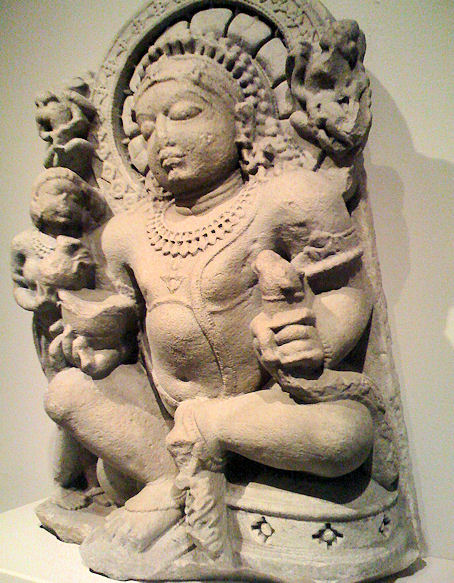
Abb.: Kubera, 10. Jhdt. n. Chr.
[Bildquelle: Zereshk / Wikipedia. -- Creative Commons Lizenz (Namensnennung, share alike)]
"KUVERA. In the Vedas, a chief of the evil beings or spirits living in the shades : a sort of Pluto, and called by his patronymic Vaiśravaṇa. Later he is Pluto in another sense, as god of wealth and chief of the Yakṣas and Guhyakas. He was son of Viśravas by Iḍāviḍā, but he is sometimes called son of Pulastya, who was father of Viśravas. This is explained by the Mahā-bhārata, accord ing to which Kuvera was son of Pulastya, but that sage being offended with Kuvera for his adulation of Brahmā, "reproduced the half of himself in the form of Viśravas," and had Rāvaṇa and other children. (See Viśravas.) Kuvera's city is Alakā (also called Prabhā, Vasu-dharā, and Vasu-sthalī) in the Himalayas, and his garden Caitra-ratha on Mandara, one of the spurs of Mount Meru, where he is waited upon by the Kinnaras. Some authorities place his abode on Mount Kailāsa in a palace built by Viśva-karma. He was half-brother of Rāvaṇa, and, according to the Rāmāyaṇa and Mahā-bhārata, he once had possession of the city of Laṅkā in Ceylon, which was also built by Viśva-karma, and from which he was expelled by Rāvaṇa. The same authority states that he performed austerities for thousands of years, and obtained the boon from Brahmā that he should be immortal, one of the guardian deities of the world, and the god of wealth. So he is regent of the north, and the keeper of gold and silver, jewels and pearls, and all the treasures of the earth, besides nine particular Nidhis, or treasures, the nature of which is not well understood. Brahmā also gave him the great self-moving aerial car Puṣpaka (q.v.). His wife is Yakṣī, Cārvī, or Kauverī, daughter of the Dānava Mura. His sons are Maṇi-grīva or Varṇa-kavi and Nala-kubara or Mayu-rāja, and his daughter Mīnākṣī (fish-eyed). He is represented as a white man deformed in body, and having three legs and only eight teeth. His body is covered with ornaments. He receives no worship. The name Ku-vera, as also the variant Ku-tanu, signifies vile body, referring to his ugliness. He is also called Dhana-pati, 'lord of wealth'; Icchā-vasu, 'who has wealth at will' ; Yakṣa-rāja, chief of the Yakṣas ; Mayu-rāja, 'king of the Kinnaras' ; Rākṣasendra, chief of the Rākṣasas ; Ratna-garbha, 'belly of jewels' ; Rāja-rāja, 'king of kings'; and Nara-rāja, 'king of men' (in allusion to the power of riches). From his parentage he is called Vaiśravaṇa, Paulastya, and Aiḍaviḍa or Ailavila. As an especial friend of Śiva he is called Īśa-sakhi, &c."
[Quelle: Dowson, John <1820-1881>: A classical dictionary of Hindu mythology and religion, geography, history, and literature. -- London, Trübner, 1879. -- s.v.]
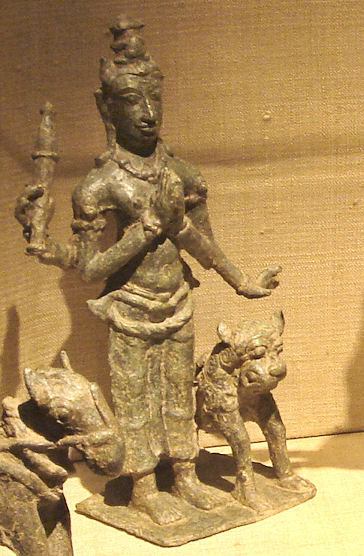
Abb.: Kubera als Dikpāla
[Bildquelle: shibainu. --
http://www.flickr.com/photos/50576994@N00/1413044344. -- Zugriff am
2010-07-07. --
Creative Commons Lizenz (Namensnennung)]
2 Tryambakasakha - त्र्यम्बकसख m.: Freund des Tryambaka (Śiva)
siehe oben!
3 Yakṣarāja - यक्षराज् m.: König der Yakṣa
siehe oben!
4 Guhyakeśvara - गुह्यकेश्वर m.: Herr der Guhyaka
siehe oben!
5 Kinnareśa - किन्नरेश m.: Herr der Kinnaras
siehe oben!
6 Vaiśravaṇa - वैश्रवण m.: Sohn des Viśravas
"VIŚRAVAS. Son of the Prajāpati Pulastya, or, according to a statement of the Mahā-bhārata, a reproduction of half Pulastya himself. By a Brāhmaṇī wife, daughter of the sage Bharadvāja, named Iḍaviḍā or Ilaviḍā, he had a son, Kuvera, the god of wealth. By a Rākṣasī named Nikaṣā or Kaikasī, daughter of Sumāli, he had three sons, Rāvaṇa, Kumbha-karṇa, and Vibhīṣaṇa and a daughter named Sūrpa-nakhā. The Viṣṇu Purāṇa substitutes Keśinī for Nikaṣā. The account given by the Mahā-bhārata is that Pulastya, being offended with Kuvera for his adulation of Brahmā, reproduced half of himself as Viśravas, and Kuvera to recover his favour gave him three Rākṣasī handmaids : Puṣpotkaṭā, the mother of Rāvaṇa and Kumbha-karṇa ; Mālinī, the mother of Vibhīṣana; and Rākā, the mother of Khara and Sūrpa-nakhā."
[Quelle: Dowson, John <1820-1881>: A classical dictionary of Hindu mythology and religion, geography, history, and literature. -- London, Trübner, 1879. -- s.v.]
7 Paulastya - पौलस्त्य m.: Nachkomme des Pulastya
"PULASTYA. One of the Prajā-patis or mind-born sons of Brahmā, and one of the great Ṛṣis. He was the medium through which some of the Purāṇas were communicated to man He received the Viṣṇu Purāṇa from Brahmā and communicated it to Parāśara, who made it known to mankind. He was father of Viśravas, the father of Kuvera and Rāvaṇa, and all the Rākṣasas are supposed to have sprung from him."
[Quelle: Dowson, John <1820-1881>: A classical dictionary of Hindu mythology and religion, geography, history, and literature. -- London, Trübner, 1879. -- s.v.]
8 Ailavila - ऐलविल m.: Sohn der Ilavilā
"IḌAVIḌĀ. Daughter of Tṛṇabindu and the Apsaras Alambuṣā. There are different statements in the Purāṇas as regards her. She is represented to be the wife of Viśravas and mother of Kuvera, or the wife of Pulastya and mother of Viśravas." [Quelle: Dowson, John <1820-1881>: A classical dictionary of Hindu mythology and religion, geography, history, and literature. -- London, Trübner, 1879. -- s.v.]
73. c./d. asyodyānaṃ caitrarathaṃ putras tu nalakūbaraḥ
74. kailāsaḥ sthānam alakā pūr vimānaṃ tu puṣpakam
syāt kinnaraḥ kimpuruṣas turaṅgavadano mayuḥ
75. nidhir nā śevadhir bhedāḥ padma-śaṅkhādayo nidheḥ
अस्योद्यानं चैत्ररथं पुत्रस् तु नलकूबरः ॥७३ ख॥
कैलासः स्थानम् अलका पूर् विमानं तु पुष्पकम् ।
स्यात् किन्नरः किंपुरुषस् तुरङ्गवदनो मयुः ॥७४॥
निधिर् ना शेवधिर् भेदाः पद्म-शङ्खादयो निधेः ॥७५॥
Sein (Kuberas) Lustgarten heißt चैत्ररथ n.: Caitraratha (Garten des Citraratha)1.
Sein Sohn heißt नलकूबर m.: Nalakūbara ("Schilfrohrdeichsel")2.
Sein Wohnort ist der कैलास m.: Kailāsa3.
Seine Stadt heißt अलका f.: Alakā ("Lockige")4.
Sein himmlisches Gefährt (Luftschiff) heißt पुष्पक n.: Puṣpaka ("Blumiges")5.
[Bezeichnungen für Kinnara6 sind:]
मयु m.: Mayu
[Bezeichnungen für Schatz sind:]
Sein Schatz teilt sich in:
1 Caitraratha - चैत्ररथ n.: Caitraratha (Garten des Citraratha)
"CAITRA-RATHA. The grove or forest of Kuvera on Mundara, one of the spurs of Meru; it is so called from its being cultivated by the gandharva Citra-ratha." [Quelle: Dowson, John <1820-1881>: A classical dictionary of Hindu mythology and religion, geography, history, and literature. -- London, Trübner, 1879. -- s.v.]
2 Nalakūbara - नलकूबर m.: Nalakūbara ("Schilfrohrdeichsel")
im Dual (Nalakūbarau) bezeichnet es die beiden Söhne Kuberas:
- Nalakūbara
- Maṇigrīva
3 Kailāsa - कैलास m.: Kailāsa
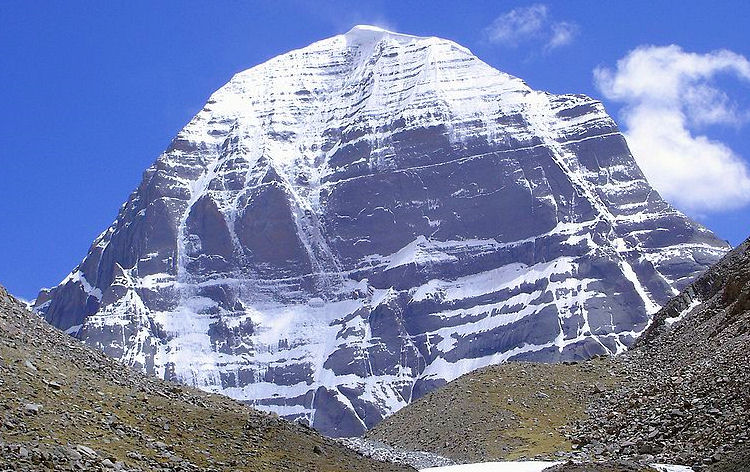
Abb.: Kailāsa von Norden - གངས་རིན་པོ་ཆེ -
冈仁波齐峰, Tibet
[Bildquelle: Ondřej váček / Wikipedia. -- GNU FDLicense]
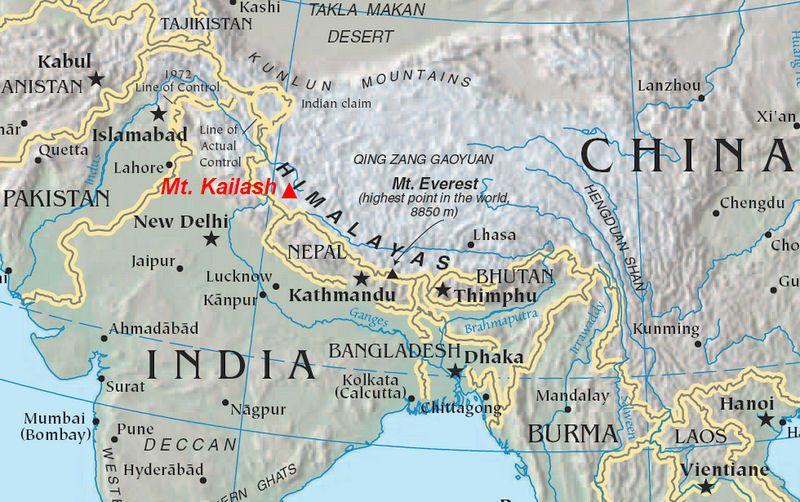
Abb.: Lage des Kailāsa
[Bildquelle: US Government / Wikipedia. -- Public domain]
"KAILĀSA. A mountain in the Himalayas, north of the Mānasa lake. Śiva's paradise is said to be on Mount Kailāsa, so also is Kuvera's abode. It is called also Gaṇa-parvata and Rajatādri, 'silver mountain'."
[Quelle: Dowson, John <1820-1881>: A classical dictionary of Hindu mythology and religion, geography, history, and literature. -- London, Trübner, 1879. -- s.v.]
4 Alakā - अलका f.: Alakā ("Lockige")
"ALAKĀ. The capital of Kuvera and the abode of the gandharvas on Mount Meru. It is also called Vasu-dhārā, Vasu-sthalī, and Prabhā."
[Quelle: Dowson, John <1820-1881>: A classical dictionary of Hindu mythology and religion, geography, history, and literature. -- London, Trübner, 1879. -- s.v.]
5 Puṣpaka - पुष्पक n.: Puṣpaka ("Blumiges")
Abb. s. oben!
"PUṢPAKA. A self-moving aerial car of large dimensions, which contained within it a palace or city. Kuvera obtained it by gift from Brahmā, but it was carried off by Rāvaṇa, his half-brother, and constantly used by him. After Rāma-candra had slain Rāvaṇa, he made use of this capacious car to convey himself and Sītā, with Lakṣmaṇa and all his allies, back to Ayodhyā ; after that he returned it to its owner, Kuvera, It isalso called Ratna-varṣuka, 'that rains jewels'."
[Quelle: Dowson, John <1820-1881>: A classical dictionary of Hindu mythology and religion, geography, history, and literature. -- London, Trübner, 1879. -- s.v.]
6 Kinnara - किन्नर m.: Kinnara (halb menschlich, halb tierisches Wesen) ("Ist das ein Mann?")
Jātarūpa: Kinnaras haben einen Menschlichen Körper und Pferdegesichter, sie bringen himmlischen Gesang zum Ertönen." (किन्नरा नरशरीरा अश्वमुखा दिव्यगीतध्वनयः)
"Kinnara. Kiṃnara. 'What men?' Mythical beings with the form of a man and the head of a horse. They are celestial choristers and musicians, dwelling in the paradise of Kuvera on Kailāsa. They sprang from the toe of Brahmā with the Yakṣas, but according to others, they are sons of Kaśyapa. They are also called Aśva-mukhas, Turaṅga-vaktras, 'horse-faced', and Mayus." [Quelle: Dowson, John <1820-1881>: A classical dictionary of Hindu mythology and religion, geography, history, and literature. -- London, Trübner, 1879. -- s.v.]
7 usw.
Der folgende Vers zählt die neun Schätze Kuberas auf:
mahāpadmaś ca padmaś ca śaṅkho makara-kacchapau
mukunda-kunda-nīlāś ca kharvaś ca nidhayo navaमहापद्मश् च पद्मश् च शङ्खो मकर-कच्छपौ
मुकुन्द-कुन्द-नीलाश् च खर्वश् च निधयो नवDie neun Schätze sind:
महापद्म m.: großer Lotos, weißer Lotos
पद्म m.: Nelumbo nucifera Gaertn. = Indische Lotosblume (s. oben)
- शङ्ख m.: rechtsdrehende (linksgewundene) Muschel Turbinella pyrum L. - Hinduglocke
- मकर m.: Makara (siehe oben!)
- कच्छप m.: Schildkröte
- मुकुन्द m.: Harz von Boswellia serrata Roxb. - Weihrauchbaum, Weihrauch
- कुन्द m.: Jasminum multiflorum (Burm. f.) Andrews - Sternblütiger Jasmin
- नील m.: blaue Farbe (von Indigofera tinctoria L. - Indigopflanze)
- खर्व m.: Kharva, Trapa natans L. - Wassernuss
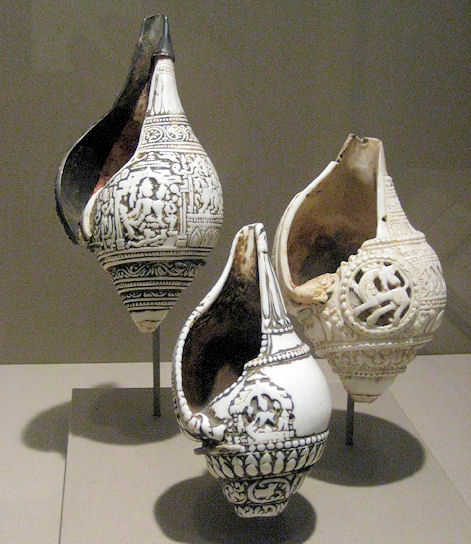
Abb.: Śaṅkha - rechtsdrehende (linksgewundene) Muschel Turbinella pyrum
L. - Hinduglocke, beschnitzt, 11./12. Jhdt n. Chr.
[Bildquelle: unforth. --
http://www.flickr.com/photos/8435962@N06/2457559393. -- Zugriff am
2010-07-09. --
Creative Commons Lizenz (Namensnennung, share alike)]
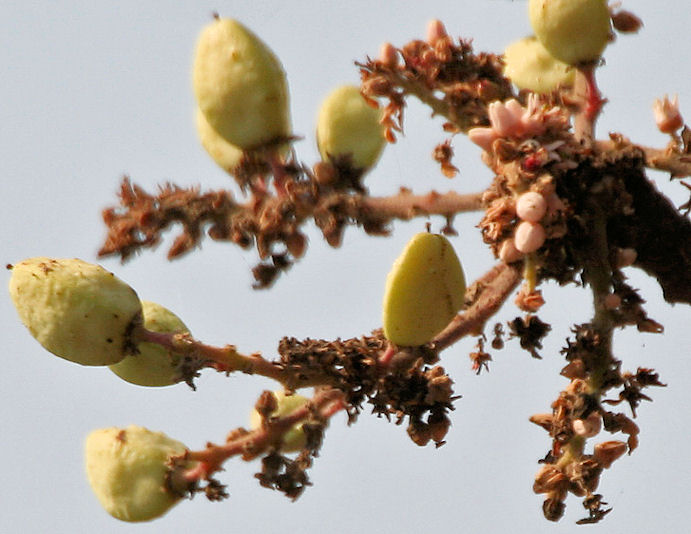
Abb.: Mukunda - Boswellia serrata Roxb. - Weihrauchbaum
[Bildquelle: J. M. Garg / Wikipedia. -- GNU FDLicense]
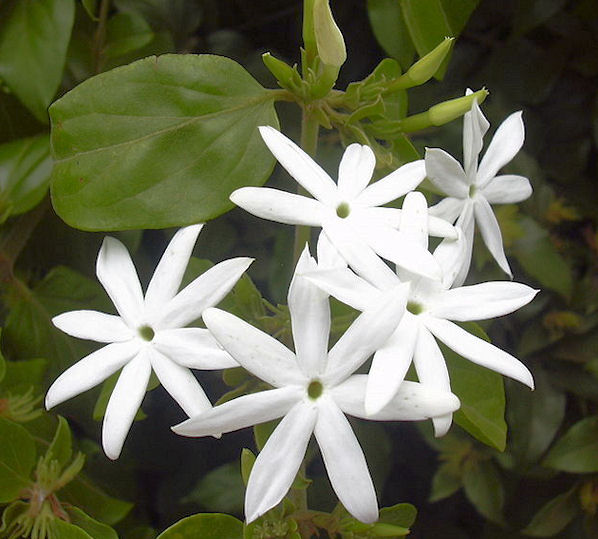
Abb.: Kunda - Jasminum multiflorum (Burm. f.) Andrews - Sternblütiger
Jasmin
[Bildquelle: Forest & Kim Starr. --
http://www.hear.org/starr/images/image/?q=030602-0071&o=plants. -- Zugriff
am 2010-07-09. --
Creative Commons Lizenz (Namensnennung)]
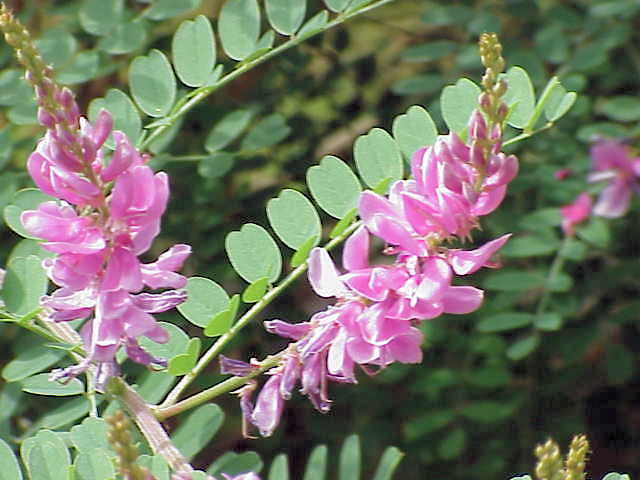
Abb.: Indigofera tinctoria L. - Indigopflanze
[Bildquelle: Kurt Stueber / Wikimedia commons. -- GNU FDLicense]
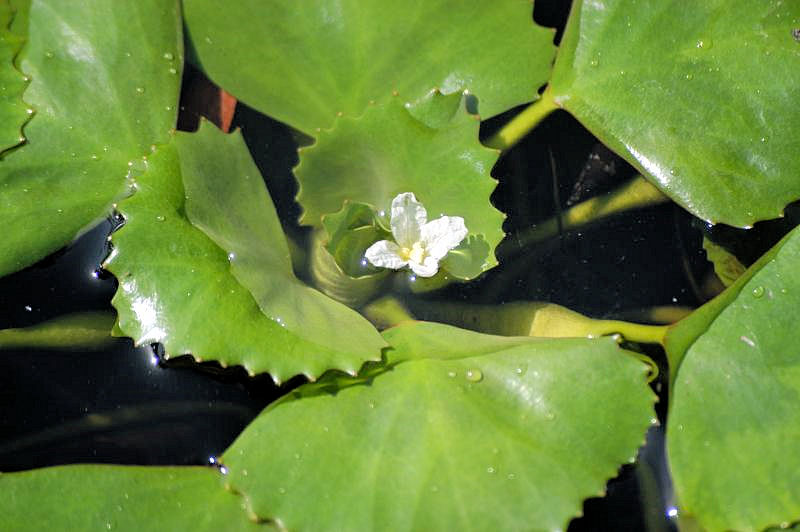
Abb.: Kharva -Trapa natans L. - Wassernuss
[Bildquelle: Schurdl / Wikipedia. --
Creative Commons
Lizenz (Namensnennung, share alike)]
Zu: 1.2. vyomavargaḥ - Abschnitt über den Luftraum